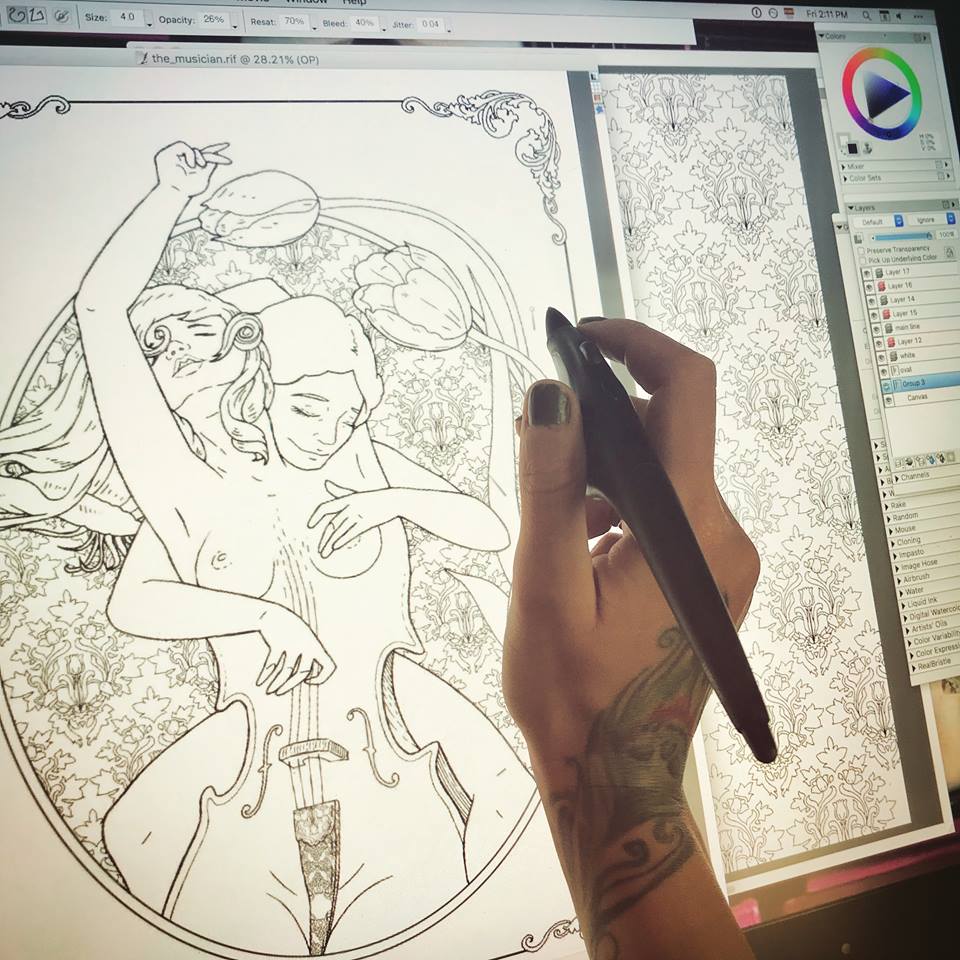Today, I will be digitally painting a still life, concentrating on composition, multiple light sources, reflective and transparent surfaces and light as its own character. I will be working in Corel Painter 18 with mainly acrylic brushes. As always, I invite you to join me and try something similar on your own time. You can apply the principles that i am about to show you to both manual and digital painting.
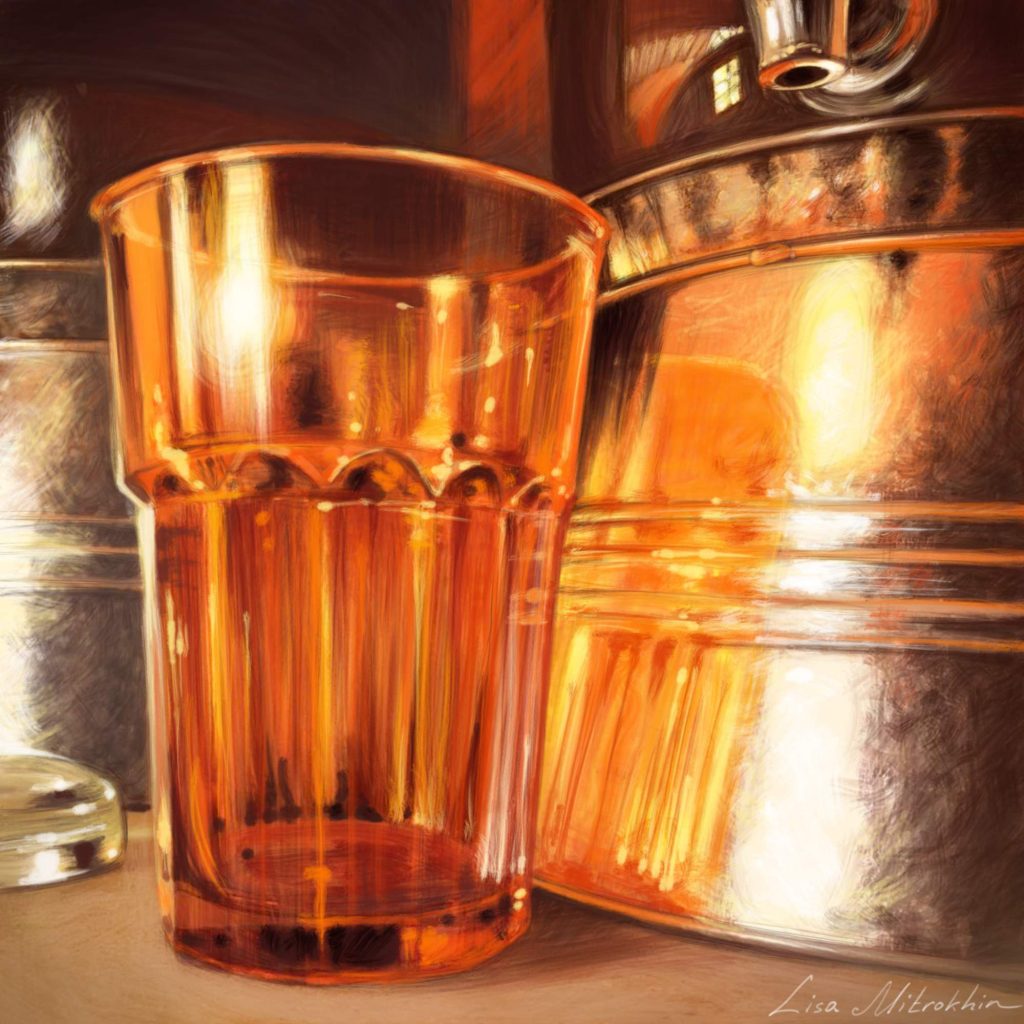
The final painting
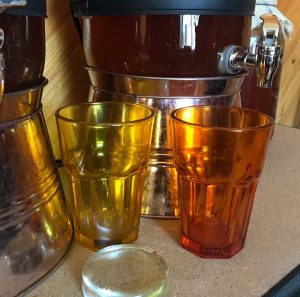
Interesting still life subjects
The first and most important thing in still life painting is, of course, selecting interesting subjects to depict. But what makes subjects interesting? You may think that that you need fancy trinkets or exquisite bouquets of flowers to paint a beautiful still life, but you would be wrong. The only thing you need for a gorgeous composition is interesting lighting and a good vantage point.
In fact, simple, everyday objects, often make the best compositions because most viewers will be able to relate to these things. If you do your job right as an artist and depict an ordinary object in an extraordinary way, that magic that you envelop your subject in will remain with the viewer for many hours, days and years to come. The next time they see a broom or a set of keys, or ordinary drinking glasses they may just see them in the same magnificent light that you introduced in your depiction.
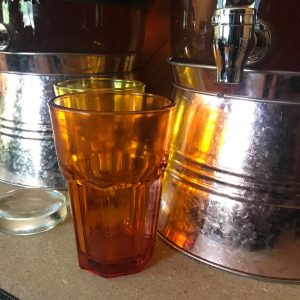
Searching for a better angle
For my ordinary subjects, I chose to work with these colorful glasses. There is nothing special about them. I have one of every color in my kitchen. I chose only the yellow and the orange, however, because the day is very warm and cheerful, and there is gorgeous golden sunlight coming in through all the windows. I place my two chosen glasses near some other interesting reflective surfaces and begin looking for a fun angle to view them from.
I took some photographs of my subjects from different angles solely to illustrate the process of seeking the perfect composition. I highly recommend that you do not draw form photography but rather from real life. Set up your subjects, set up a drawing or painting area nearby, and paint the three-dimensional objects that you actually see, not a photograph of these objects. Once you are comfortable painting from real life compositions as well as from memory and imagination, you may use photographs for reference, but the process then will be very different than just copying the photo. For now, let’s work with what we actually see.
After moving my subjects around a bit, and myself shifting around them, looming over them and kneeling to look up at them, I finally find an angle that is the most interesting to me. From this vantage point, down on one knee, the yellow glass becomes completely obstructed by the orange one giving it an extra burst of color. I really like this effect and will go with this composition. In a photography course that I am taking, I learned that most subjects become more interesting when photographed slightly from below. I will apply that principle here and situate myself slightly lower than my subject. Relocating the subject to your work station is of course also an option, especially if you have great natural lighting in your room or studio.
As always, we begin with a rough sketch. This is the composition that I finally decided to capture. Working in my digital painting program I create a square canvas and begin sketching the scene that I already cropped in my mind. I am only interested in the composition and the simple structure of the objects at this point.

When drawing geometrically accurate and symmetrical objects it is often tempting to use guides, rulers or a compass when working both digitally and analog. I strongly encourage you not to fall into that trap. We are not creating a blueprint. We are depicting what your eyes tell your brain to perceive. We do not see perfect lines. We see concepts. Here, from where I’m sitting, I see a glass that is slightly warped by perspective. I will sketch it exactly as I see it, and if it comes out a little bit crooked it will be received even better. There will be an element of imperfection, of cuteness to it.
Because I am working in a digital program I can apply geometry to my sketch AFTER it is done just for the sake of demonstration. Notice that while my glass appears to have realistic proportions, it is slightly inaccurate. The three virtual ovals are not exactly parallel to each other. Yet, they are not randomly placed either. From where I’m sitting the glass looks almost like it is slightly curved. I want to exaggerate it a bit to give it kind of a cute sense of grandeur.
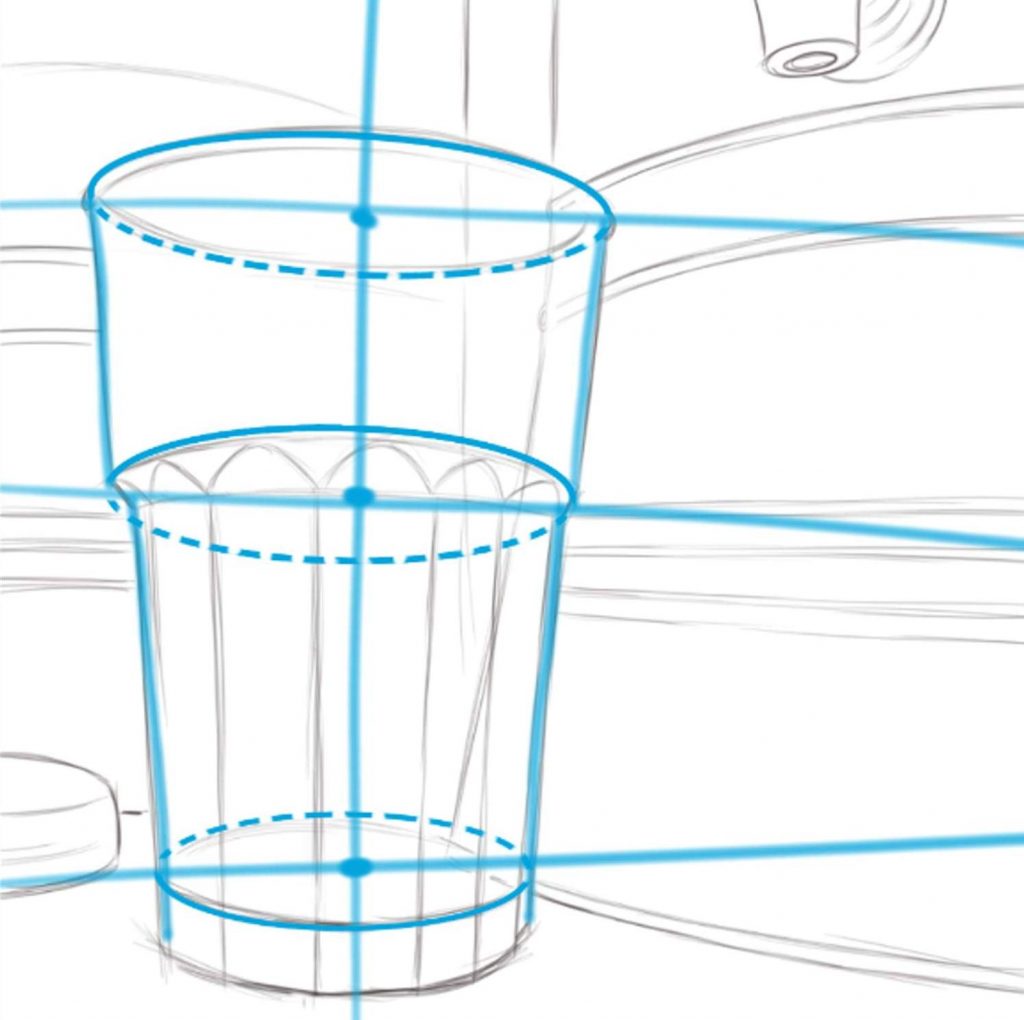
For the sake of demonstration, I will apply a virtual grid so that you can see that the perspective lines I have created for my glass are not perfect, yet consistent. Had I applied the grid to begin with and used the circle tool to create perfect ovals, my glass would have looked too graphic and unnatural. I do not wish to create a graphic design. I wish to create a painting.
I remove the grid and continue with my free-hand sketch. It is important to keep your composition simple and readable. Mine consists of three main layers/subjects. The first and most important layer is, of course, the glass itself. It will receive the most attention to detail as I paint it.
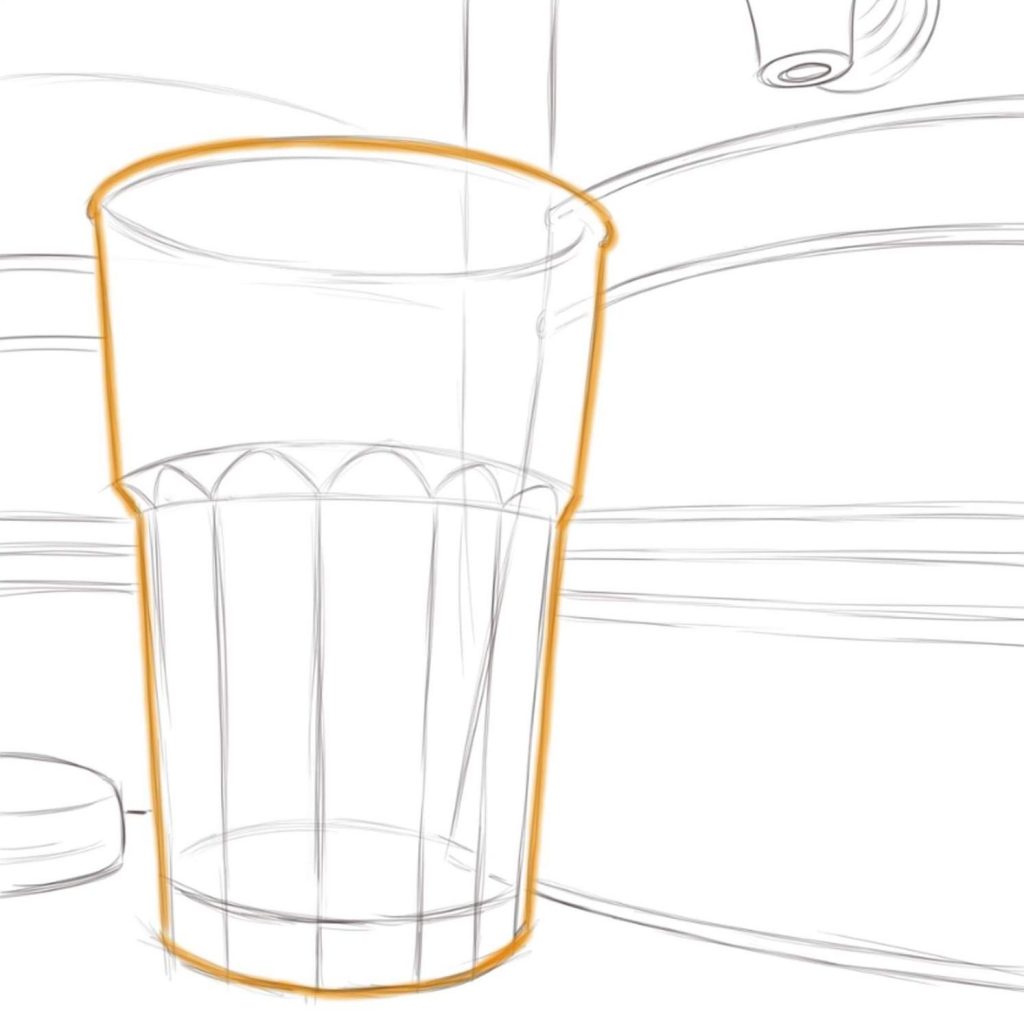
The second most important layer in this composition is the lovely reflective metal and a little glass weight that I have laying around. They are there to demonstrate space and depth of field. They create the scene for our glass. They will receive a lot of attention, but they don’t need to be quite as polished in the final draft as the main character.

Finally, there is another object visible in the background. It is not very importanyt in terms of detail or even focus. It is pretty much a backdrop. It will receive the least amount of attention.
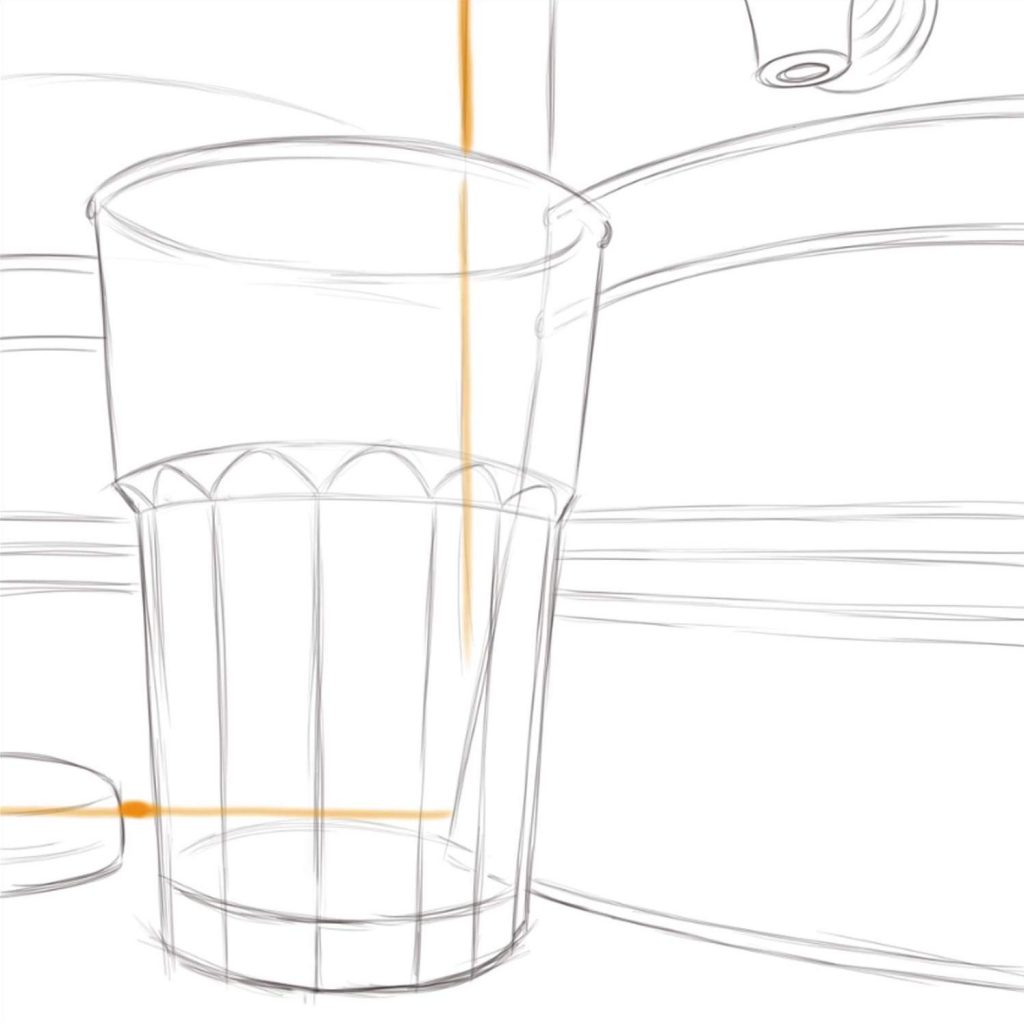
Now that I’ve established what I am depicting, I begin adding little structure lines to my most important subjects to begin building their shapes. At this point, I am also marking the lightest parts of my subjects, the brightest glow that appears on their surfaces.
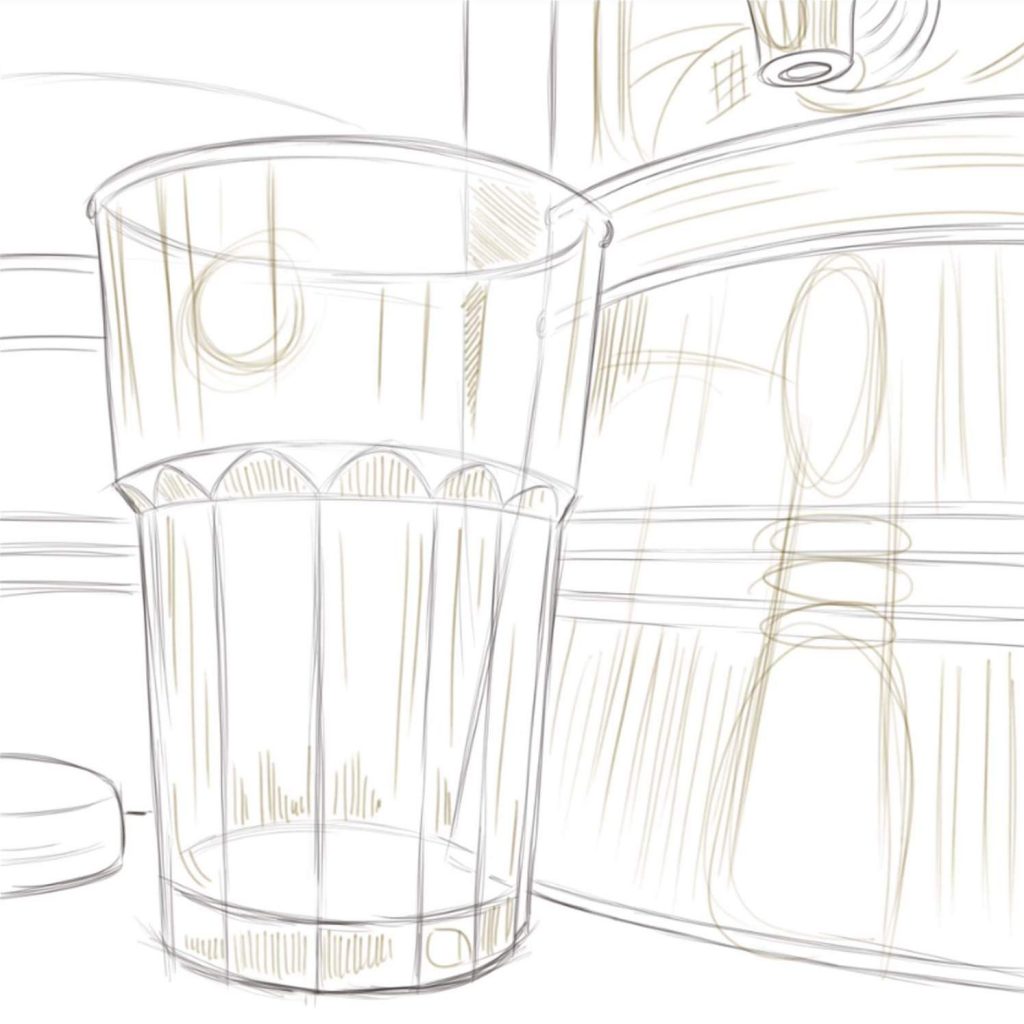
Inspecting my still life I realize that light is as much a character in this scene as the objects that it illuminates. In fact, it is really the sunshine that I am painting with the help of these objects. I’ve marked the potentially lightest parts of painting as a demonstartion for you in this graphic.
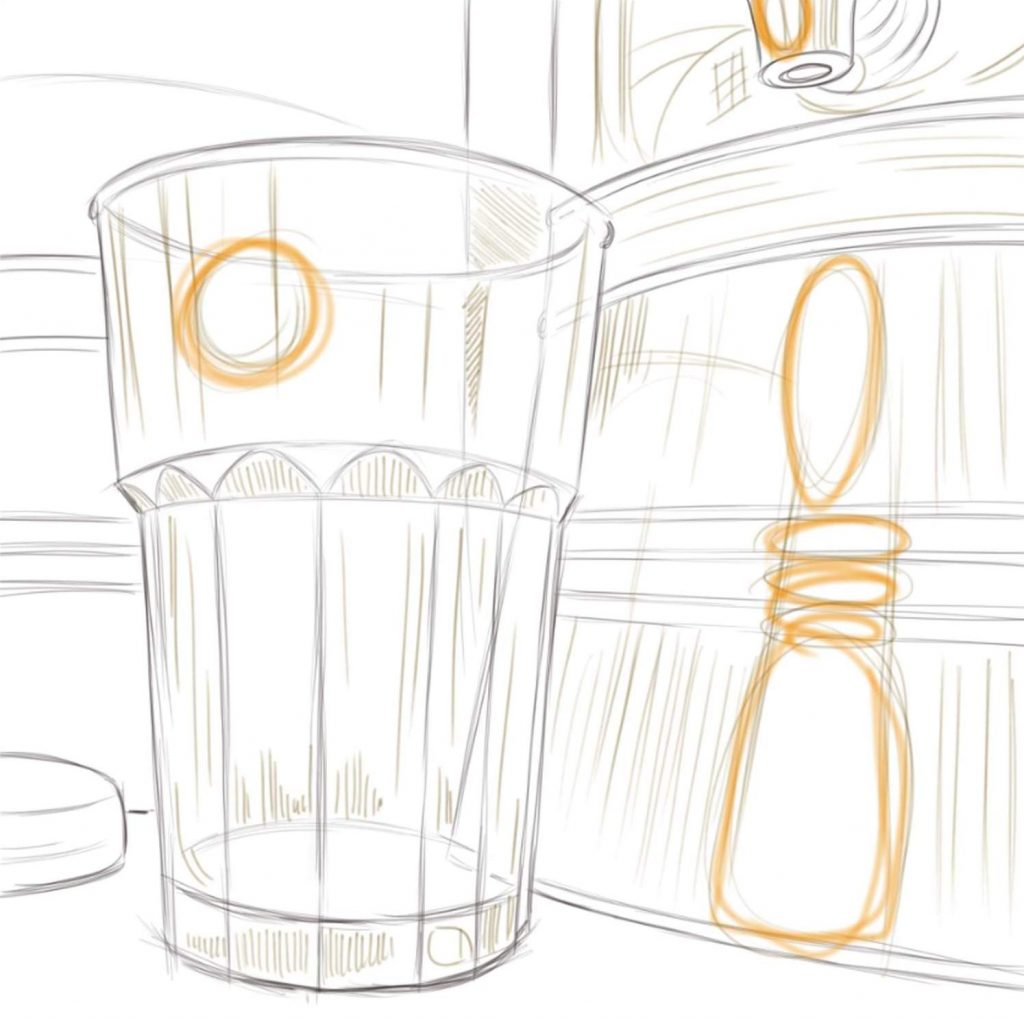
Since light is now a character that we are depicting, I shift my attention to the beautiful orange and yellow glow that is cast through the glasses onto the shiny metal. The glass in combination with this delightful artifact now become my main subjects.
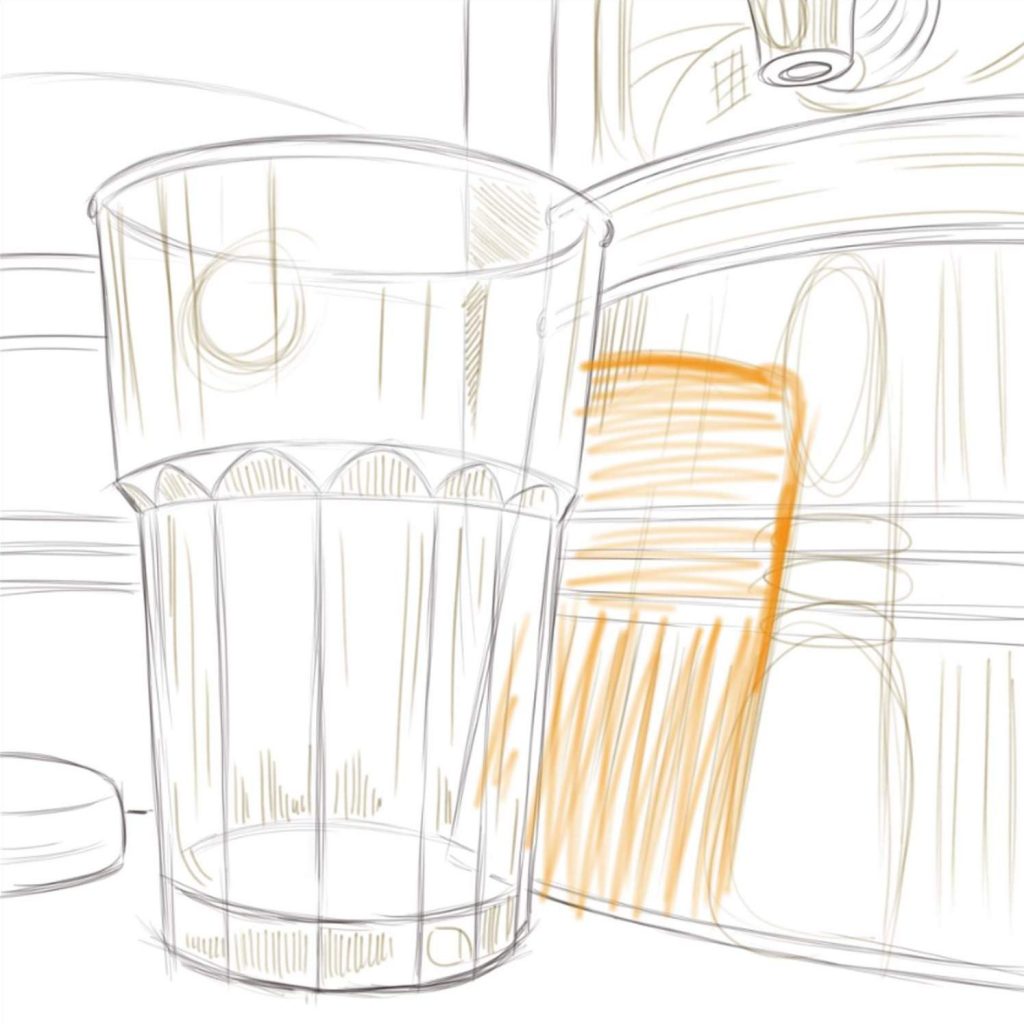
Now that I have the scene built, I prosede to apply rough brushstrokes to the parts of the objects that look the darkest to me.
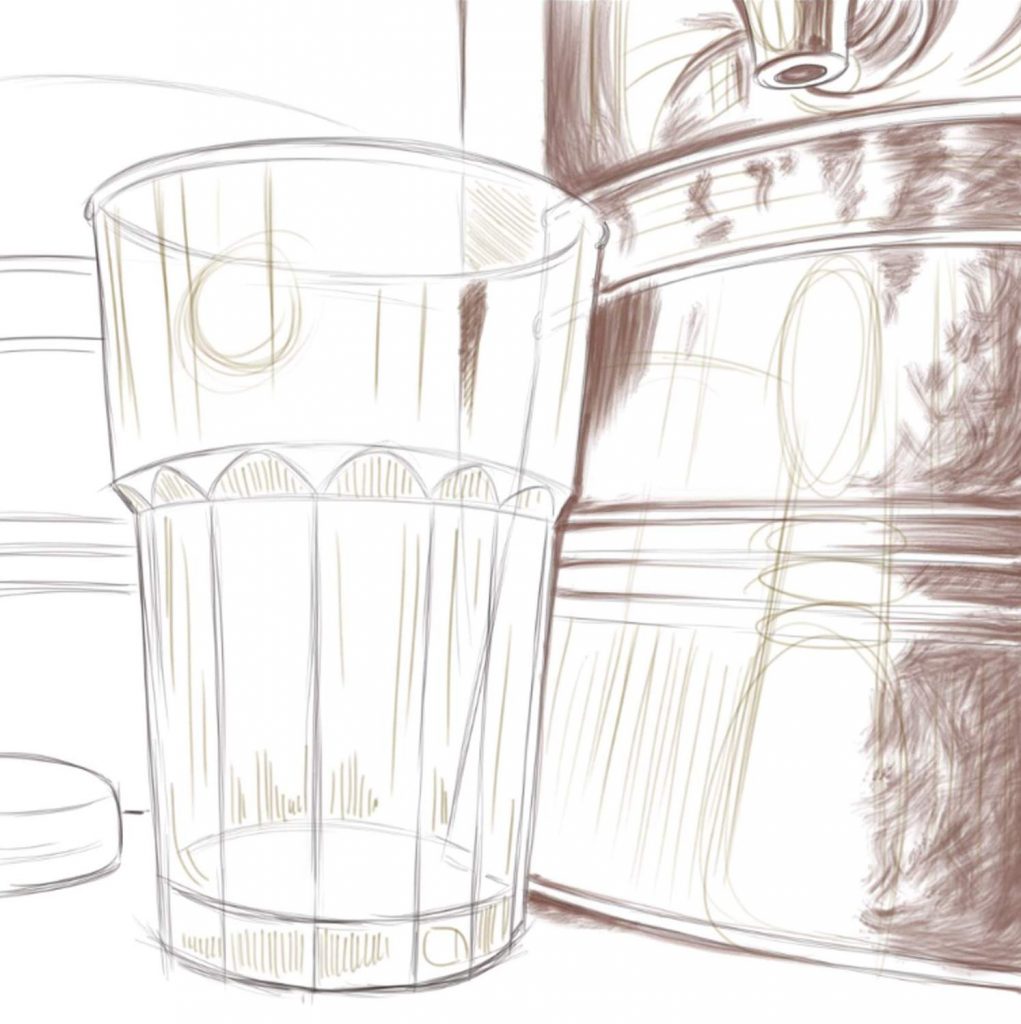
This will take a while, especially if you are working with pencils. This light technique, however, is ideal for brush painting with acrylic or oil paint, or the digital equivalent of the two.
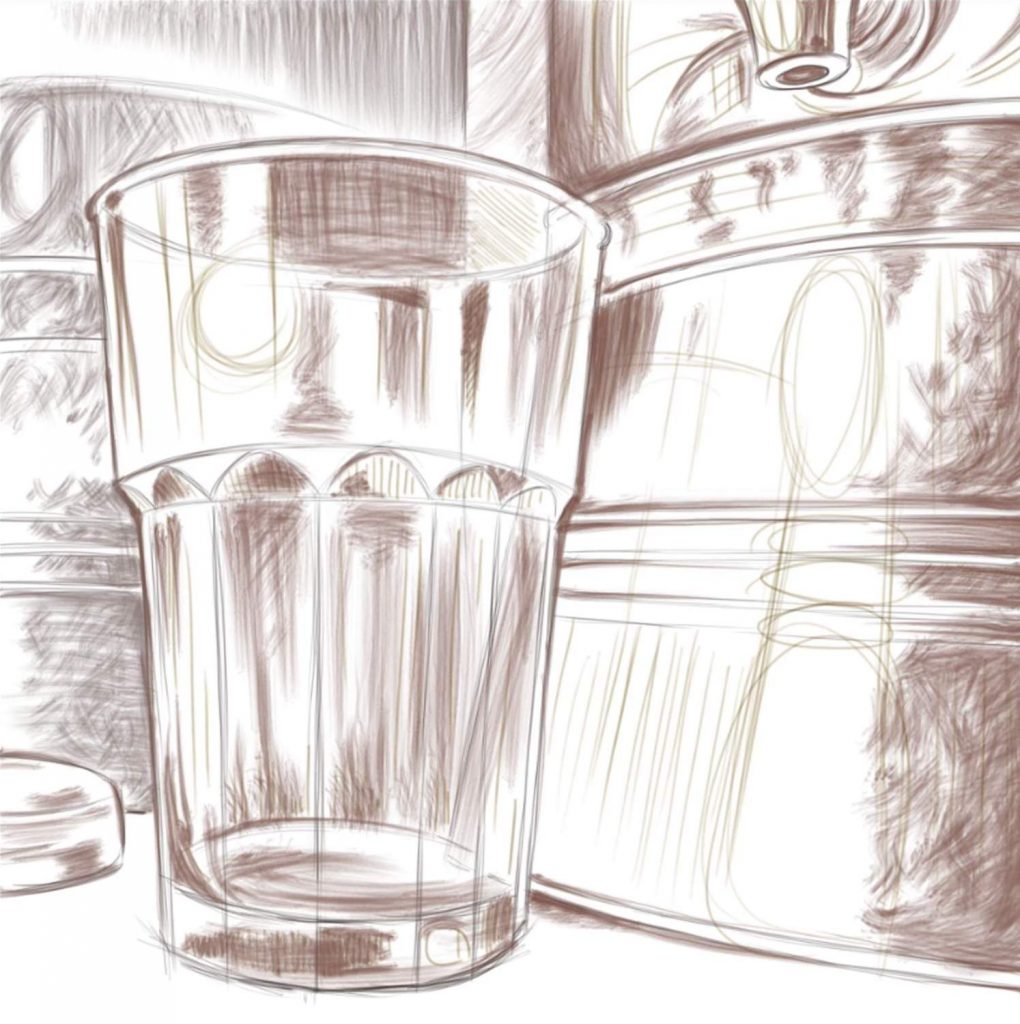
At this point, I realize that I actually prefer to be working on a tonted background. Thankfully, I an drawing digitally, so I can simply add a cream colored layer underneath. When working on actual paper, I recommend that you start with tanned paper, or prep your paper by paining it with a base layer of a ligt cream color. However, working on a pure white background is not a problem at all. Starting with a bit of a tone is just a way to speed things up a bit. If you have a way to add pure white as final details, try tinted paper.
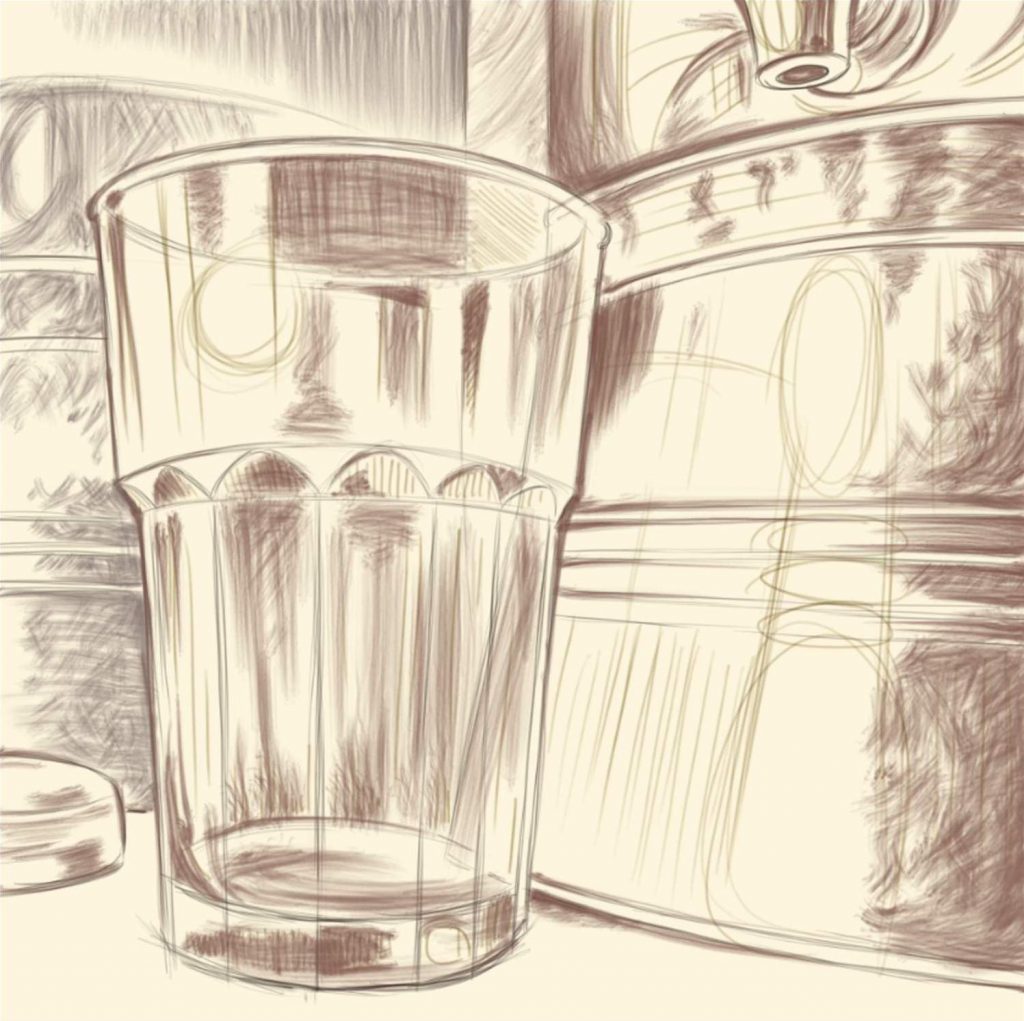
Keep an eye on your light source. If it is artificial light, it will remain constant. However, working with natural light, you do need to get all the light information down on paper as quickly as possible, becasue eventually, the sun will rise or set and your light source with shift.
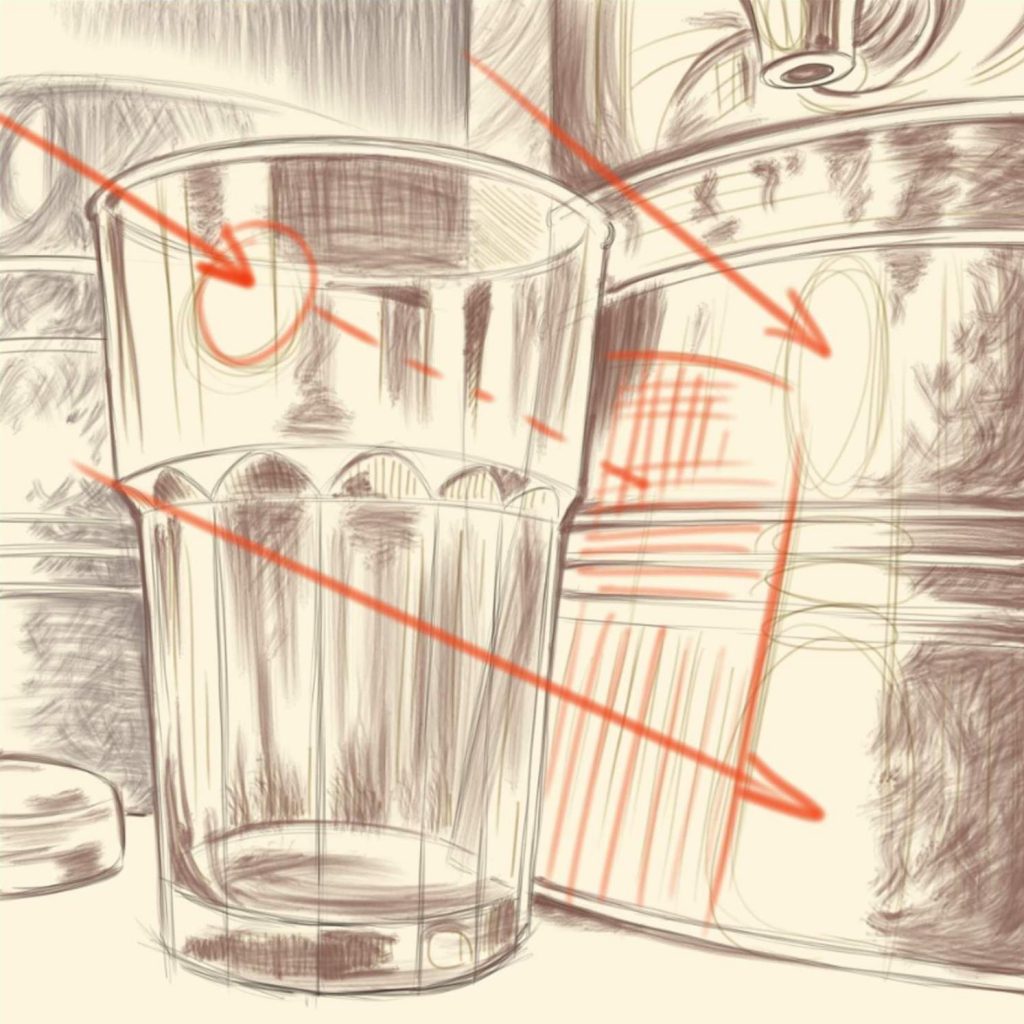
Becasue this image is all about light and color, I don’t spend much time on shading and building up details. I start introducing color right away. My glass is actually orange in color, so I introduce orange. The orange gets reflected in the tin behind it. Remember that yellow glass that is hidden behind the main object? I see that tone reflected in the tin as well. These are points of interest. They are the colors I will continue to build up.
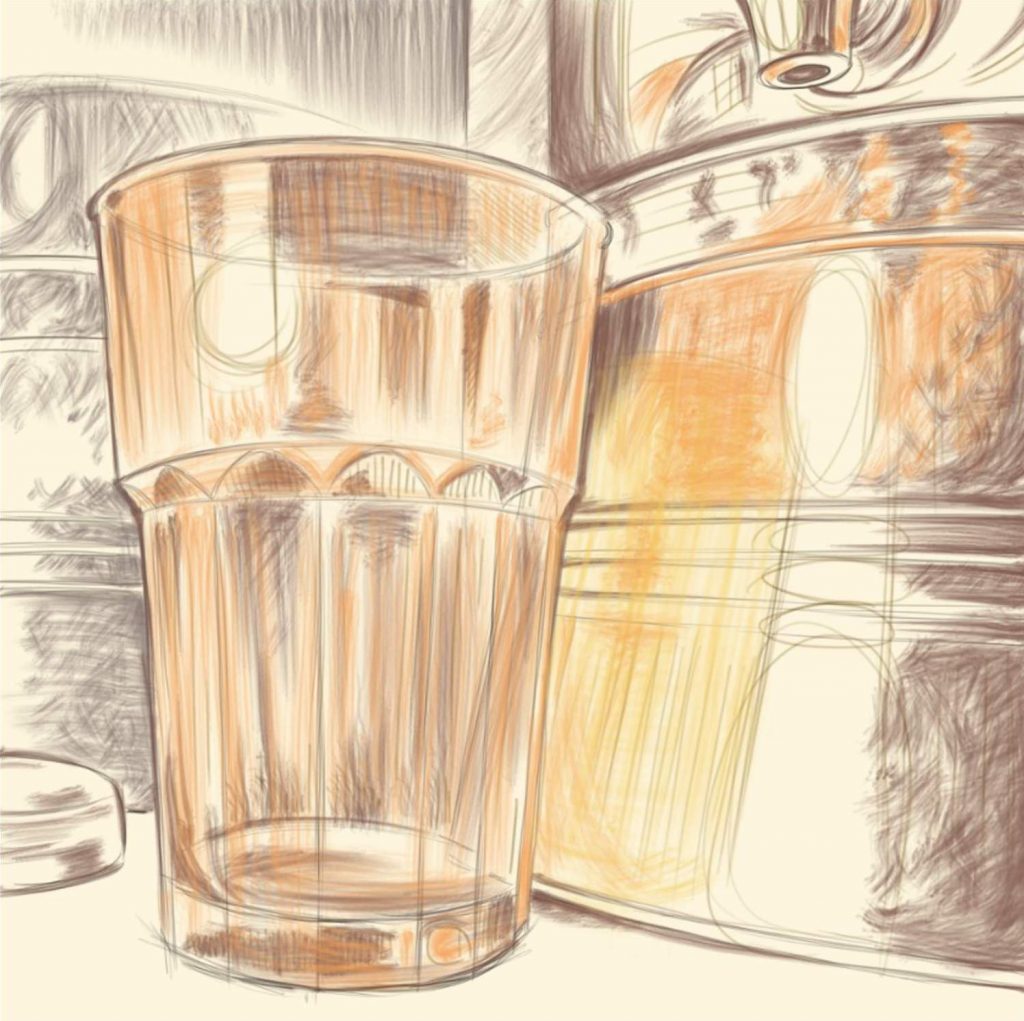
A common beginner mistake is to focus too much on individual details and lose track of the bigger picture. Don’t worry about all the little light artifacts on the glass at this point (unless you are working with watercolor. That technique is completely different from what we are doing now) Instead, start giving your objects shape by building up shadows and adding more and more color where you actually see color. I like to use a softer digital brush to add faded soft grey shadows to my background layers.
Always look at your subject. Your eyes should be going up and down between the composition and the page all the time.
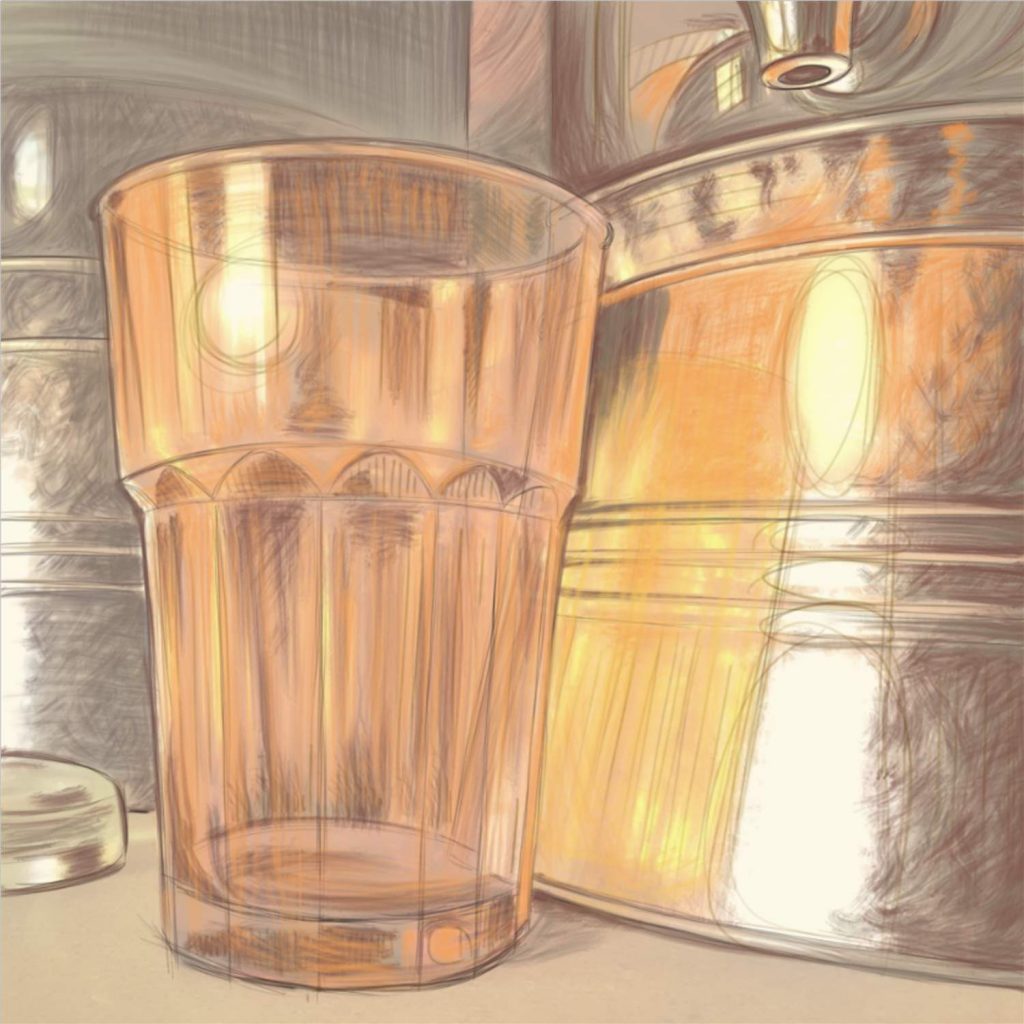
Continue buidling up shape and color by applying dabs of paint all around your composition. Do not fixate on one part yet. Pay a little bit more attention to the objects in the foreground, keep your brush strokes broader and messier on objects in the background, and build and build your composition up.
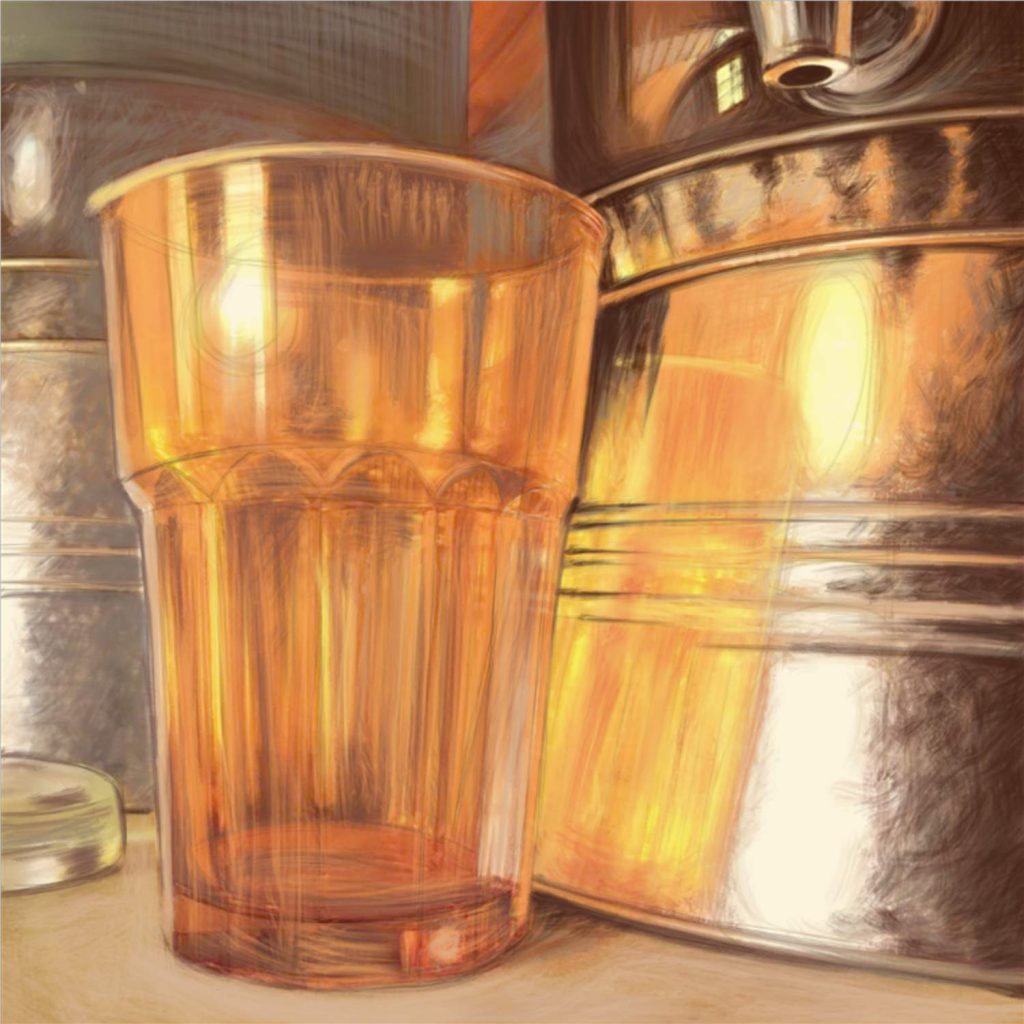
I like for my paintings to get gradually brighter and more sturated, rather than go staright into strong colors. Whether working manually or digitally, I create many layers of paint, each a little bit more saturated, each a little bit more defined.
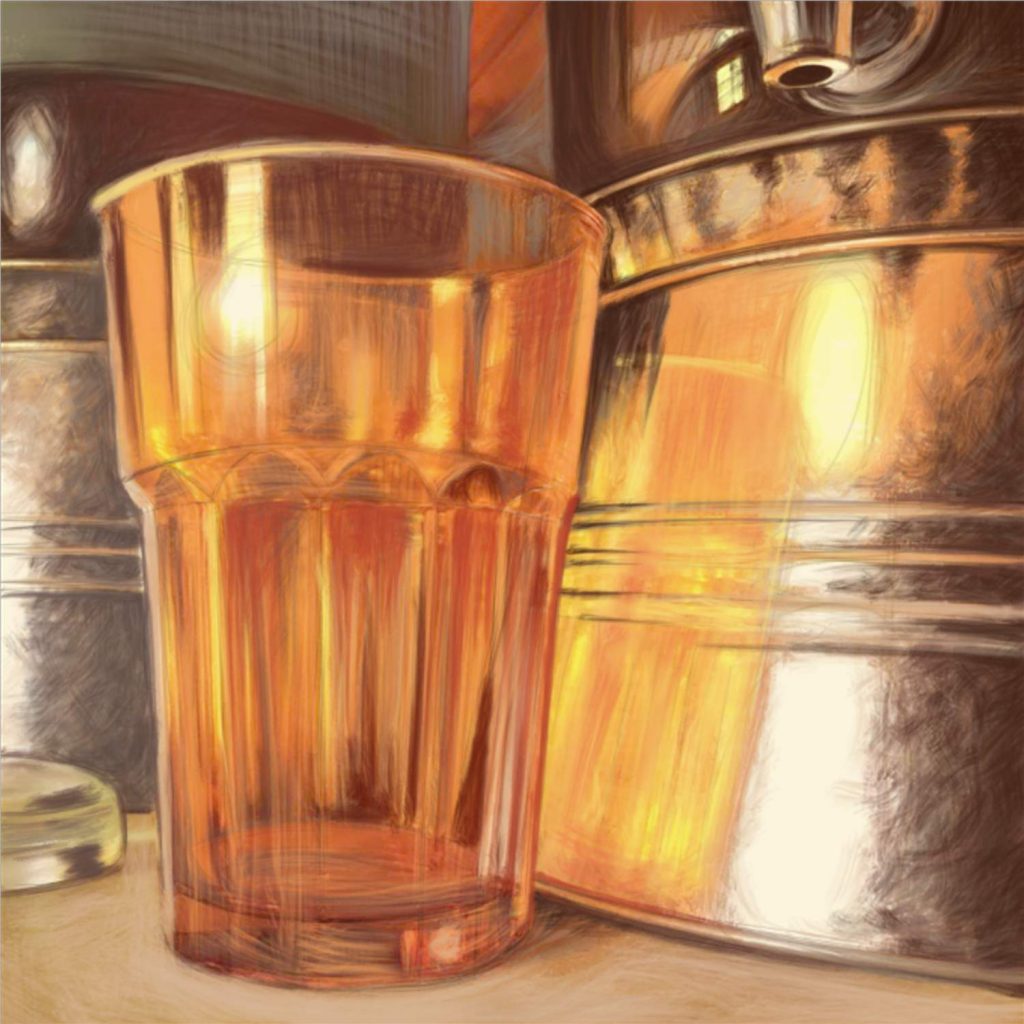
I continue to add detail with each layer.
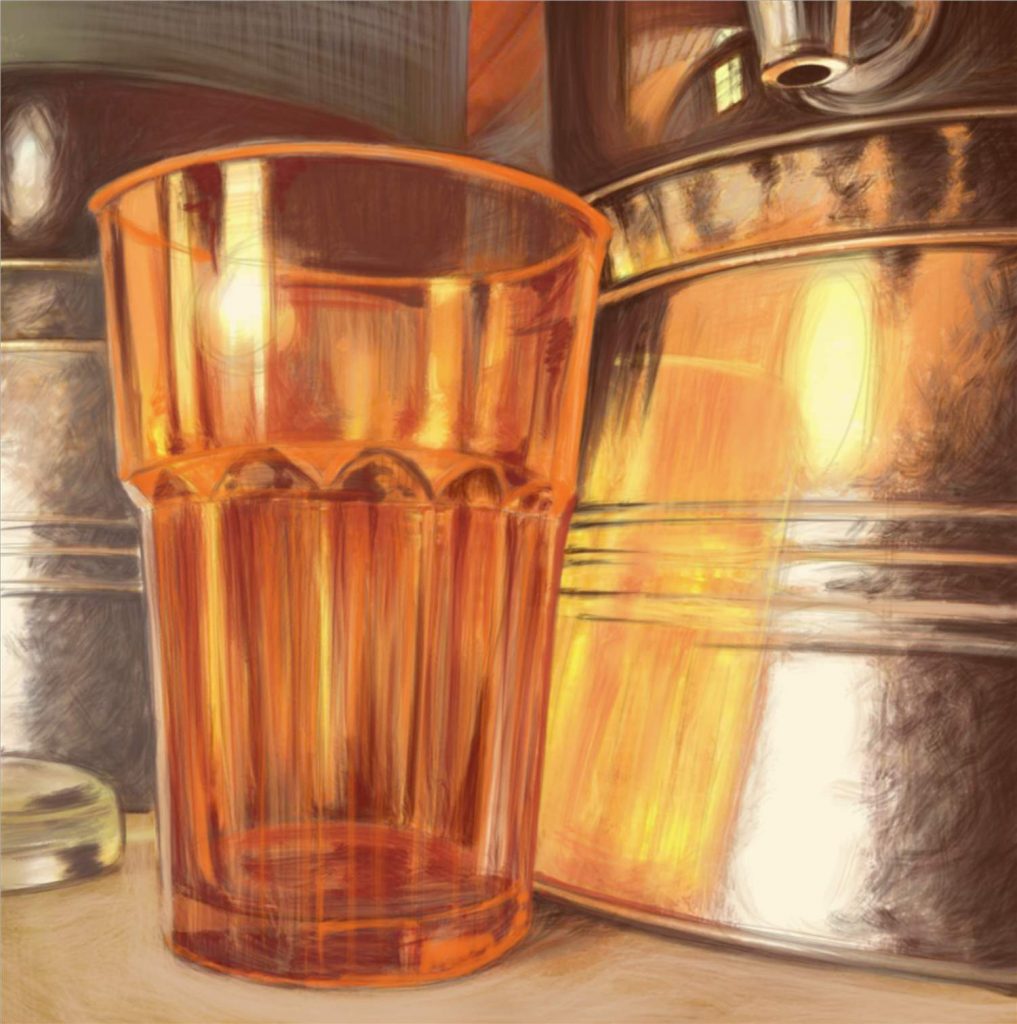
Adding darker brush strokes here and there helps define the shapes of the objects.
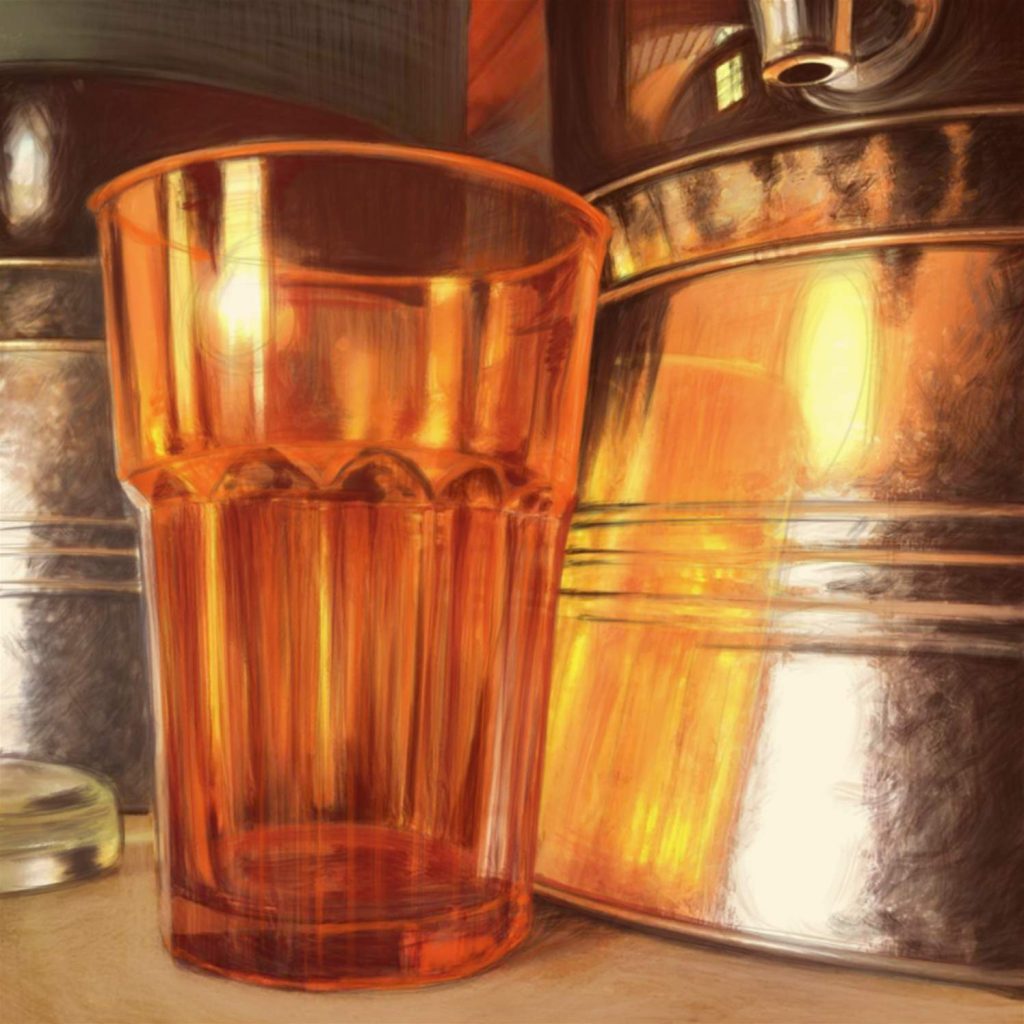
To make the dark parts appear even darker, I add more contrast with light yellow and near white highlights.
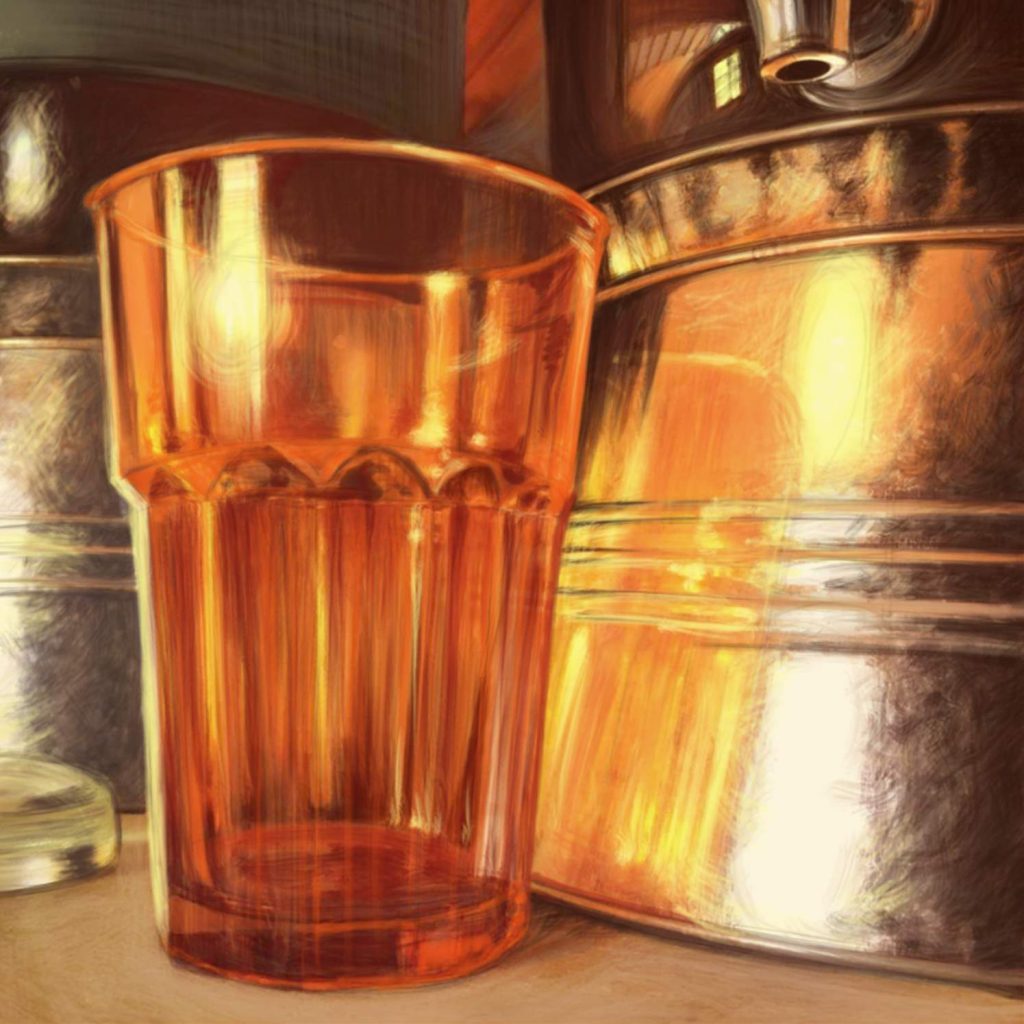
Now I have enough information to start adding the little artifacts of light that I see on the surface of the glass. Little dots and bads here and there that suggest glitter and glow.
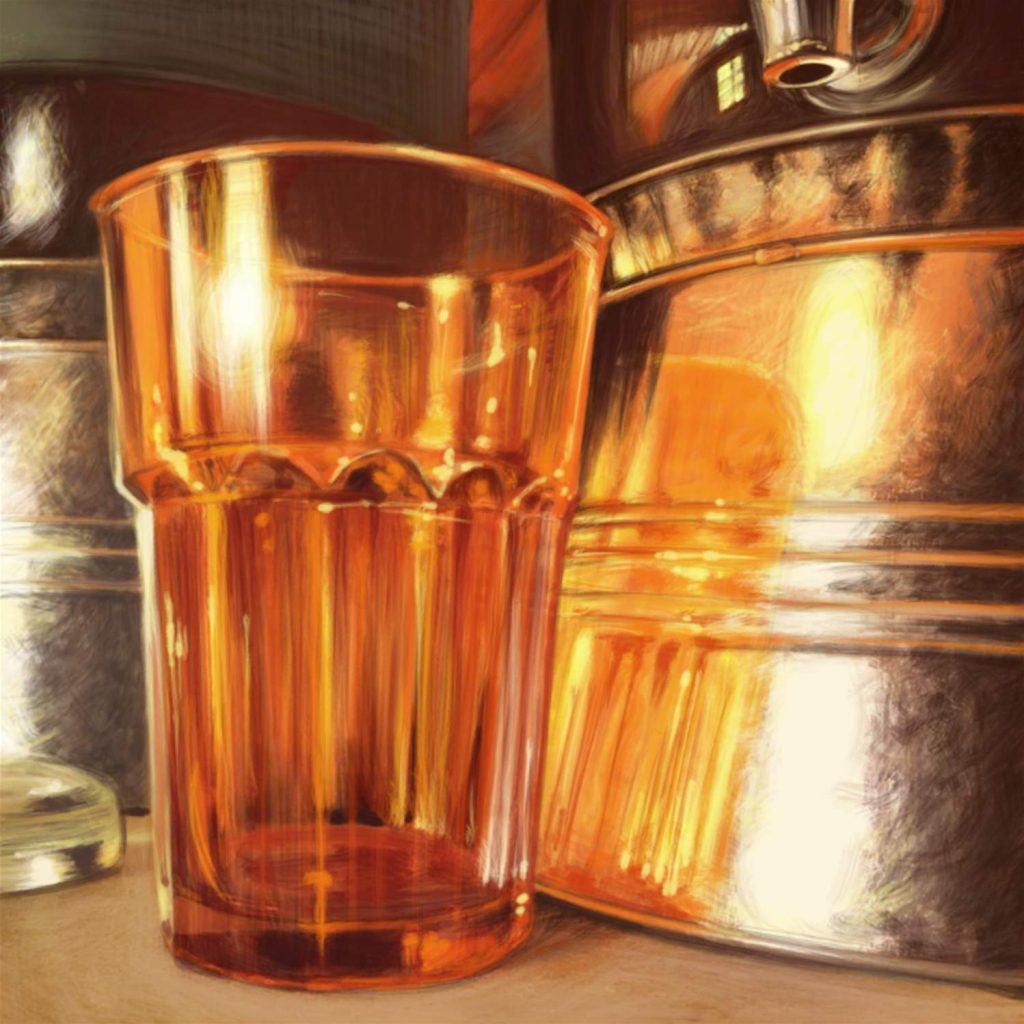
These do not have to be exact. Nor do they have to be exactly where you see them in real life. When I zoom in a bit, you can see that my brush strokes are by no means flawless, and you have no way of knowing if every dab of white and yellow that I have depicted here really corresponds to what I see on the objects, but it feels realistic. It is believable. That’s the goal of this kind of painting, to convey a recognizable scene.
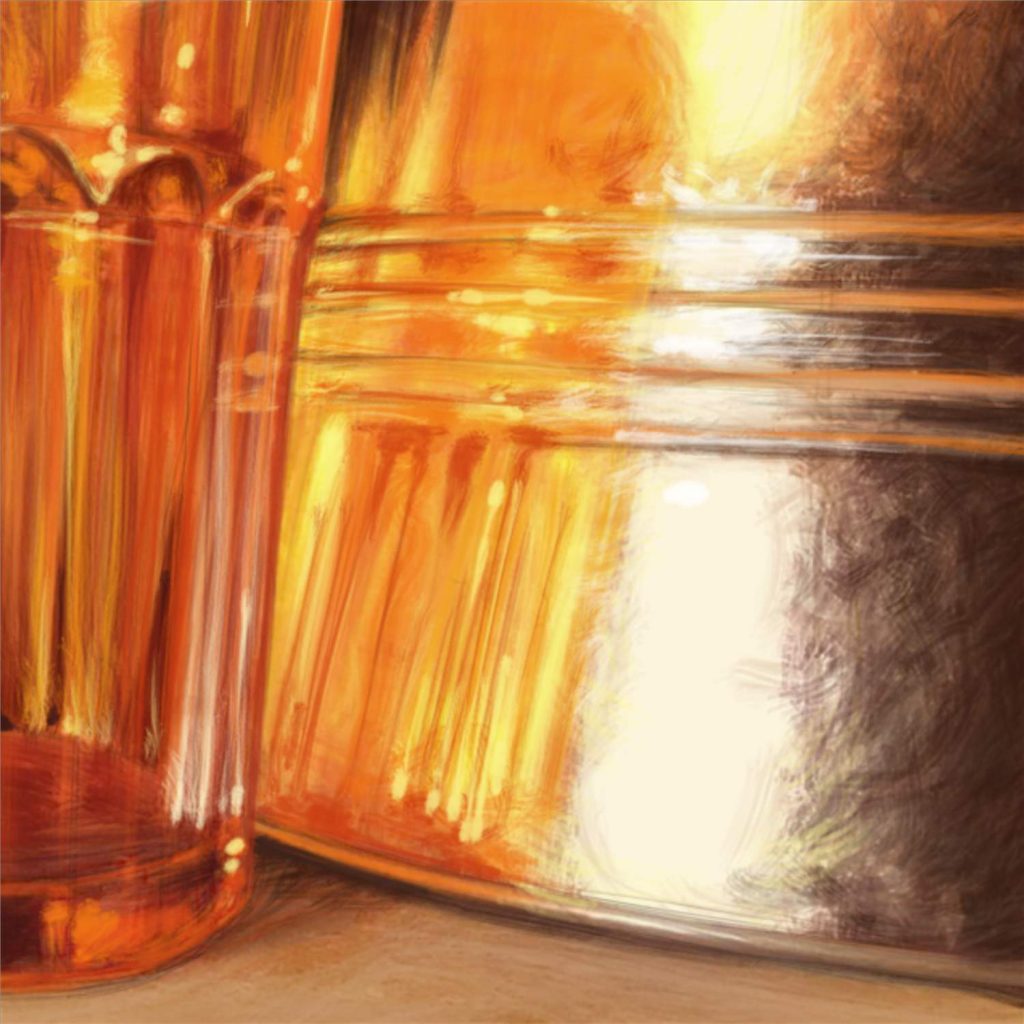
I always continue studying my subject as I paint it. The glass is thick and colorful and it’s easy to overlook that it is also transparent. Not very obviously trasparent, but some lines can be seen through it. I add the necessary transparency suggestions.
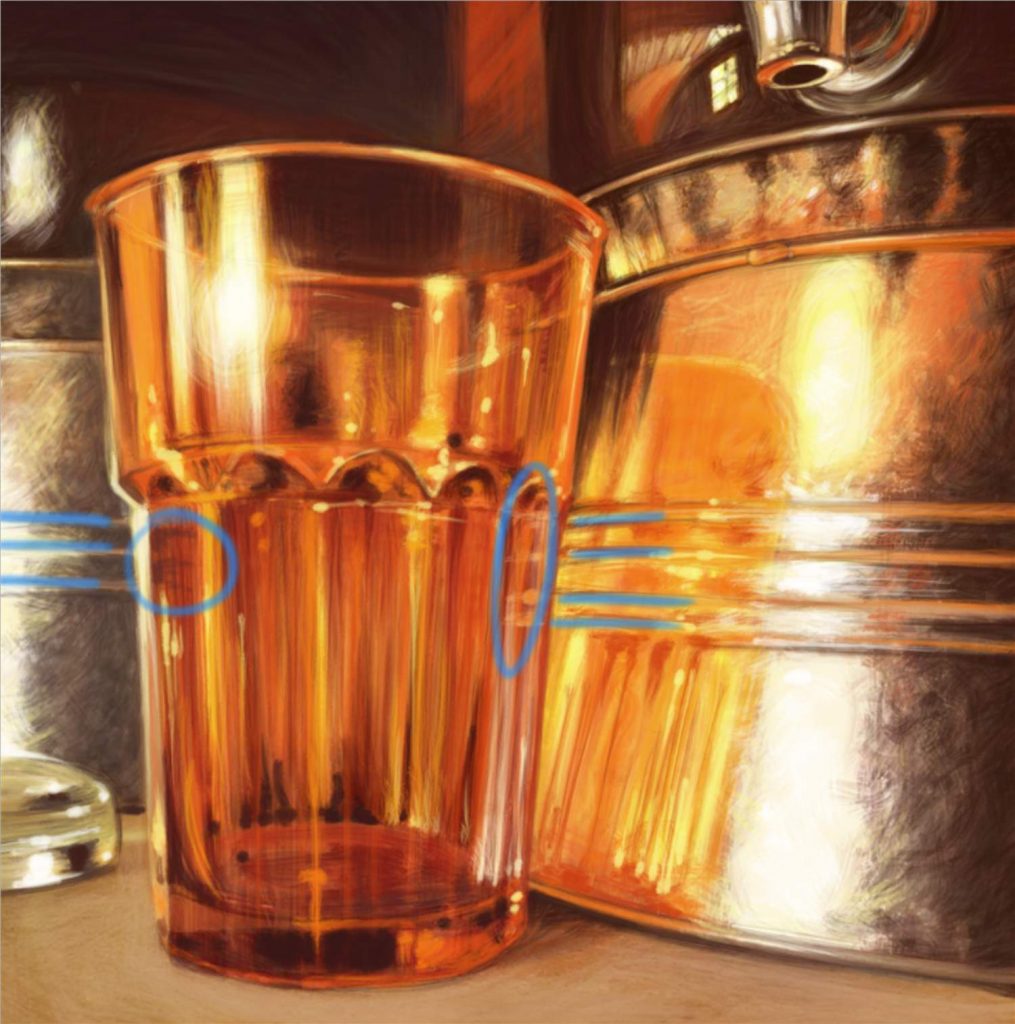
As I am nearing the completion of my painting, I check my light source. It is still coming from the same direction (from up and left). As this is morning light, I notice that the angle of the sun has changed a little bit as the day progressed, but not significantly enough to change what I see. I check my lightest spots and confirm that they are consistent with the current light source.
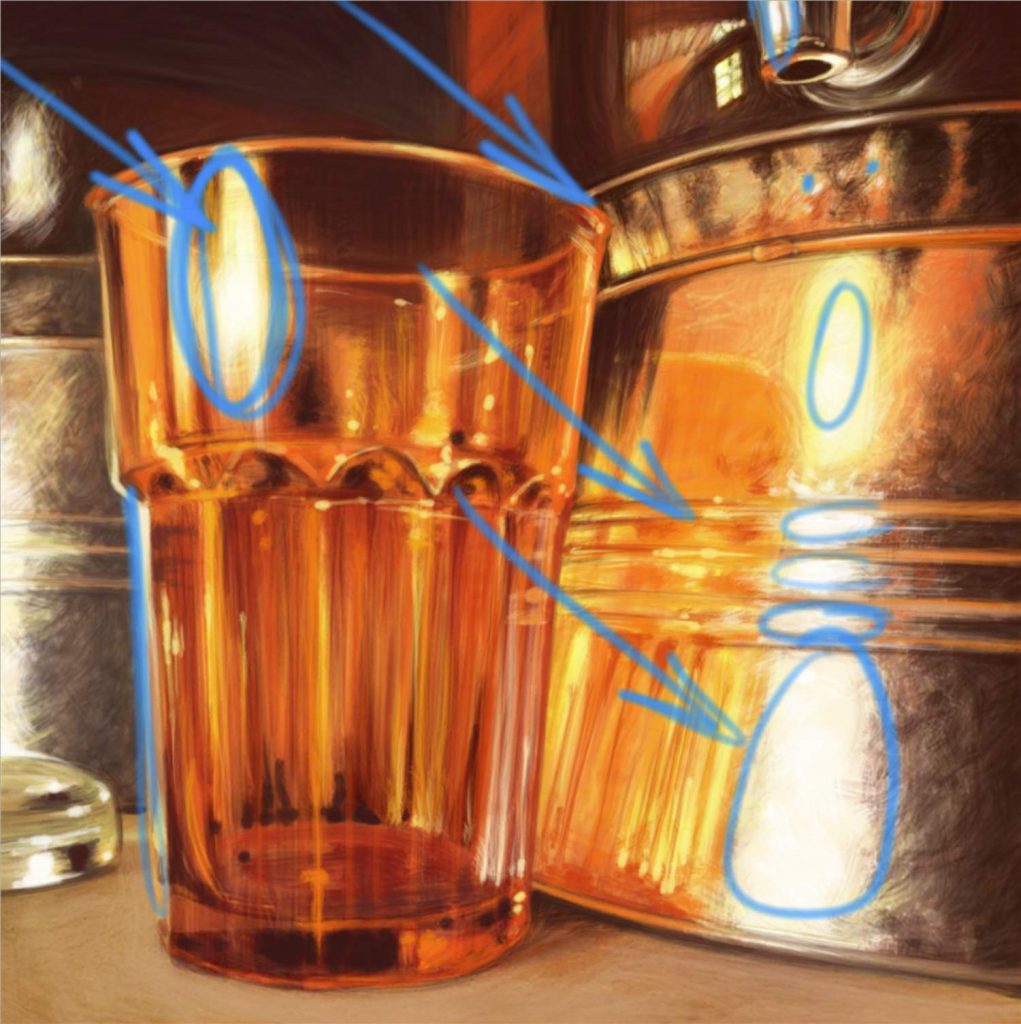
I check my main subject and its colorful shadow artifact. They are indeed the brightest and most interesting parts of this composition and appear to capture the natural light quite beautifully. If anything feels awkward or uneblievable at this point I tweak it without referencing the still life. Remember, this doesn’t have to be 100% true. We are more inetersted in the feel.
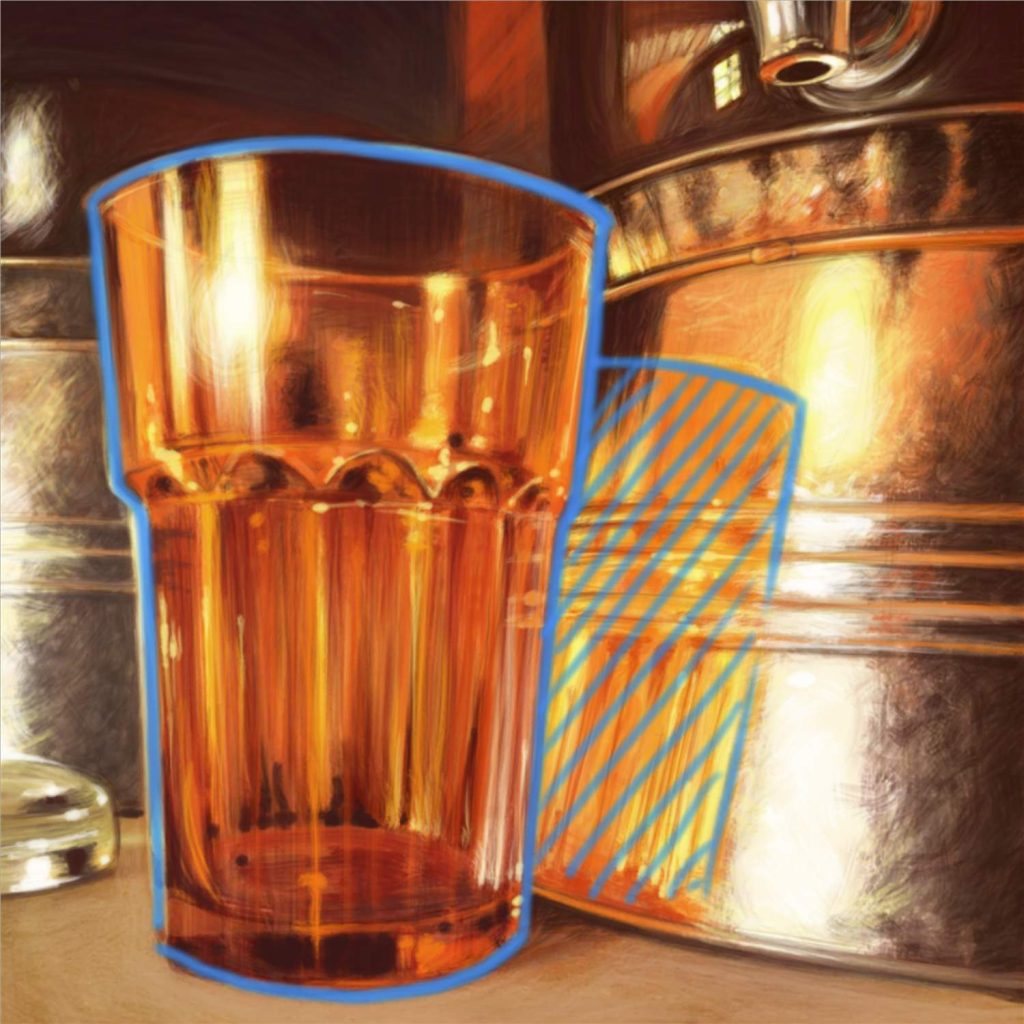
Now that we are nearly done, let’s revisit the shape of the glass. Remember those perspective lines I drew earlier? The vertical is a little bit curved and the parallel ovals are not exactly parallel. I chose to make this glass a little bit warped, and not 100% geometrically accurate. Looking at my painting now I am very pleased with the trick that this warp plays on the eye.
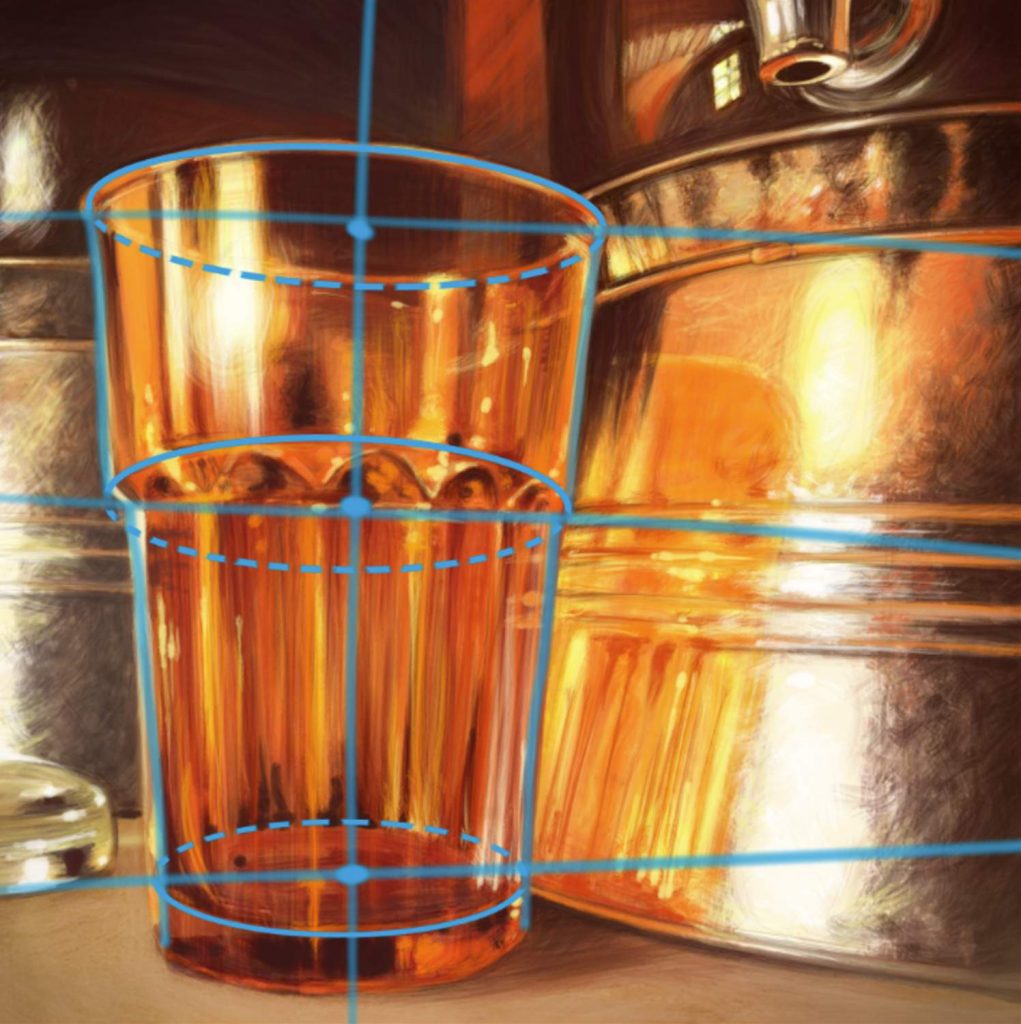
For the final touches, I use pure black to really bring out the darkest parts of the painting. I only use a few brush strokes, and only in the areas indicated here with green circles. This step is optional. I actually debated doing it for a few minutes. I like the soft, fuzzy look that I already achieved, but in the end, I chose to add just a touch of sharpness and higher contrast by introducing a few dabs of pure black.
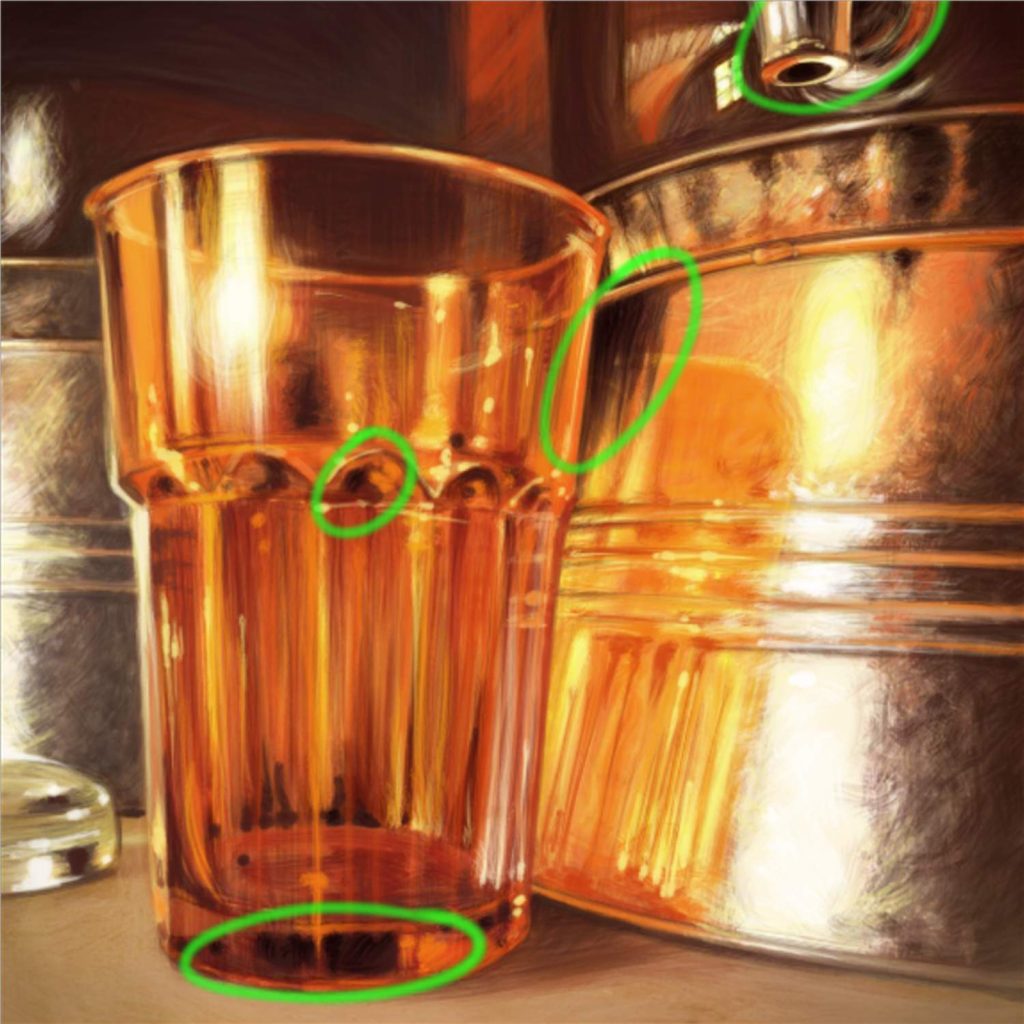
I call that complete. I sign my work, and save my file.

I hope you enjoyed creating this digital painting with me. This tutorial was a result of several requests from my fans on Facebook. If you enjoyed this painting process and would like to see more, please don’t hesitate to propose new topics. Come join me on Facebook at my personal art group TALM – The Art of Lisa Mitrokhin, and tell me which art techniques interest you.
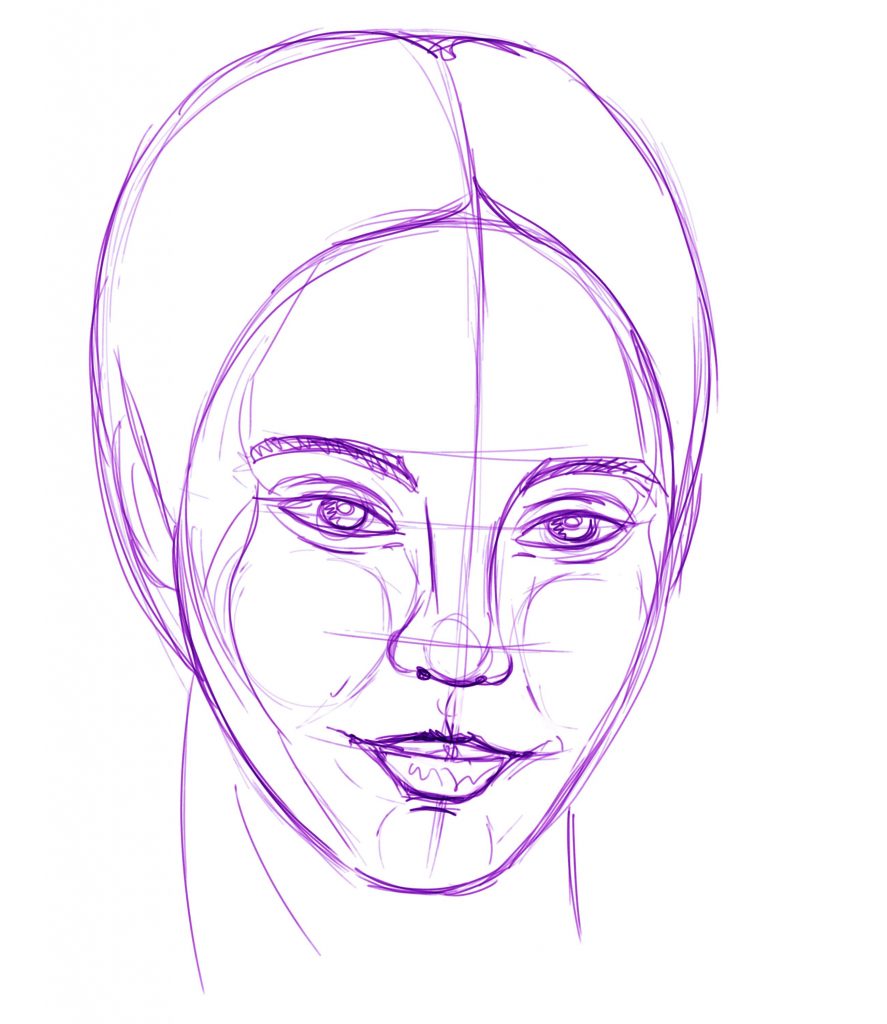
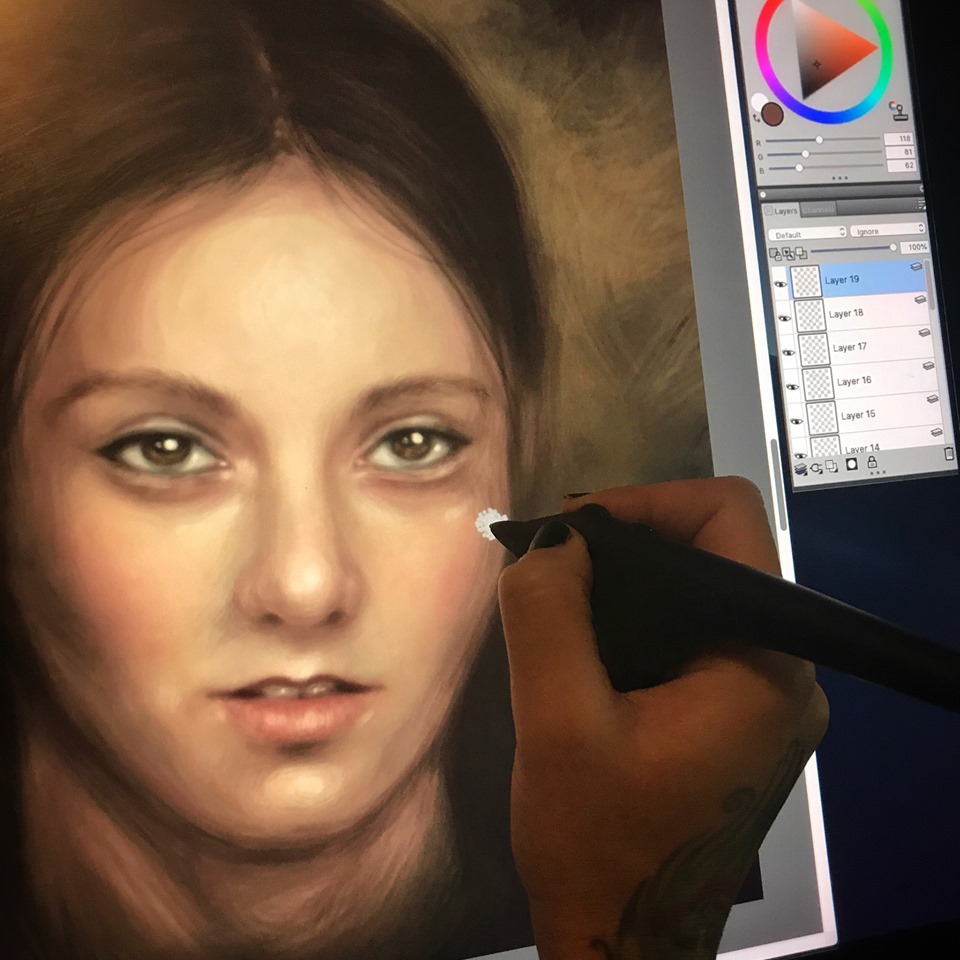
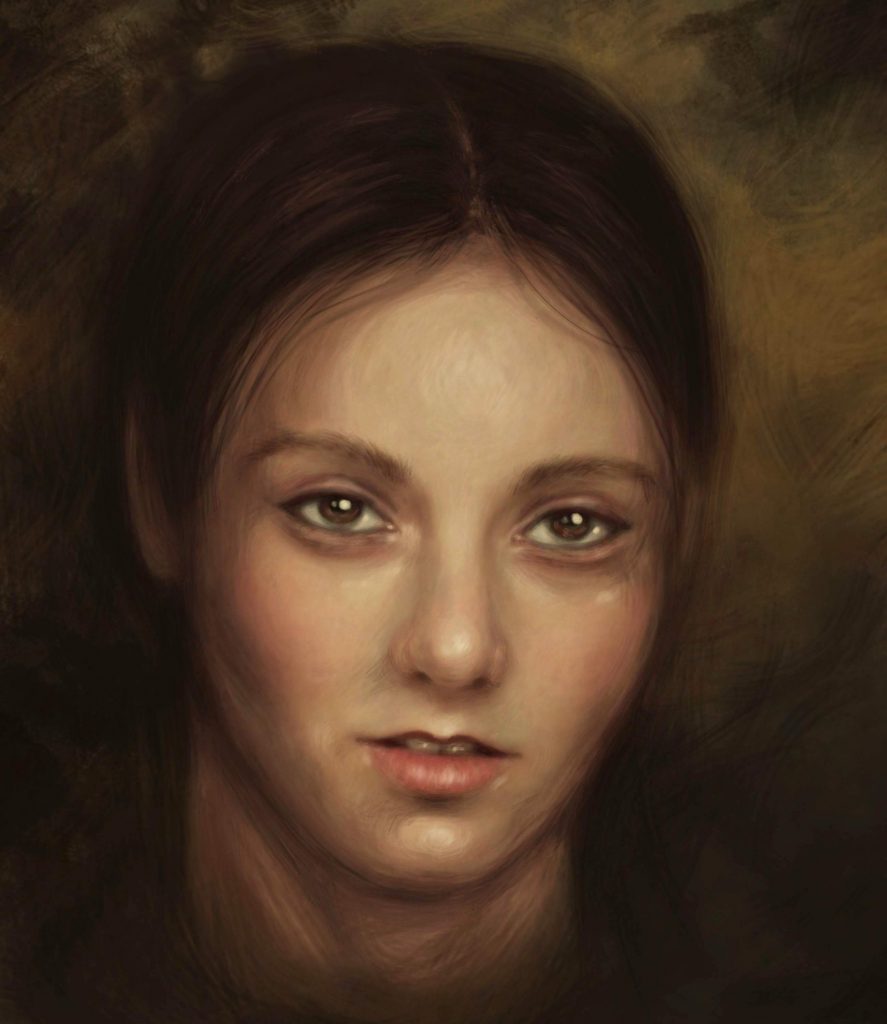
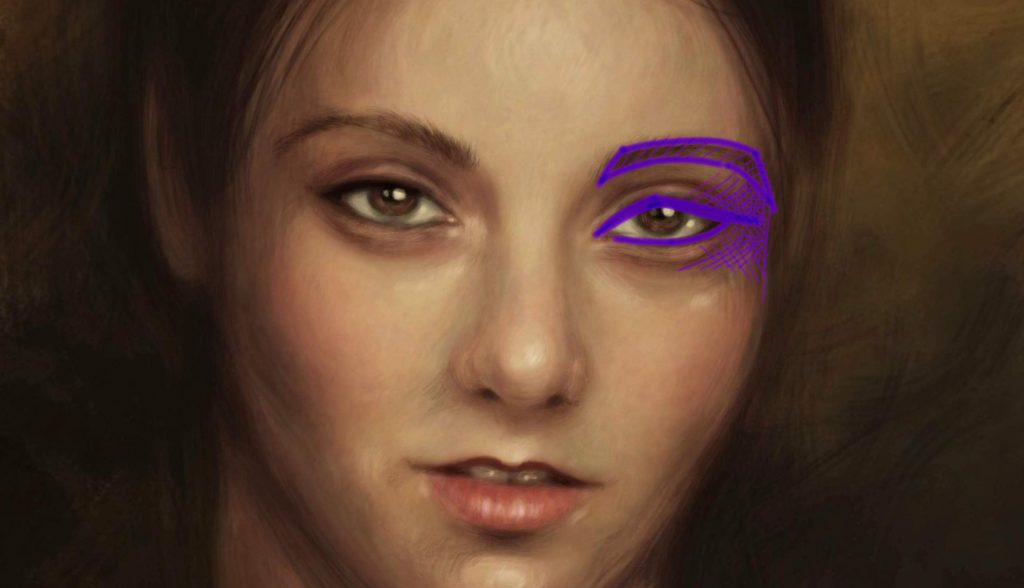
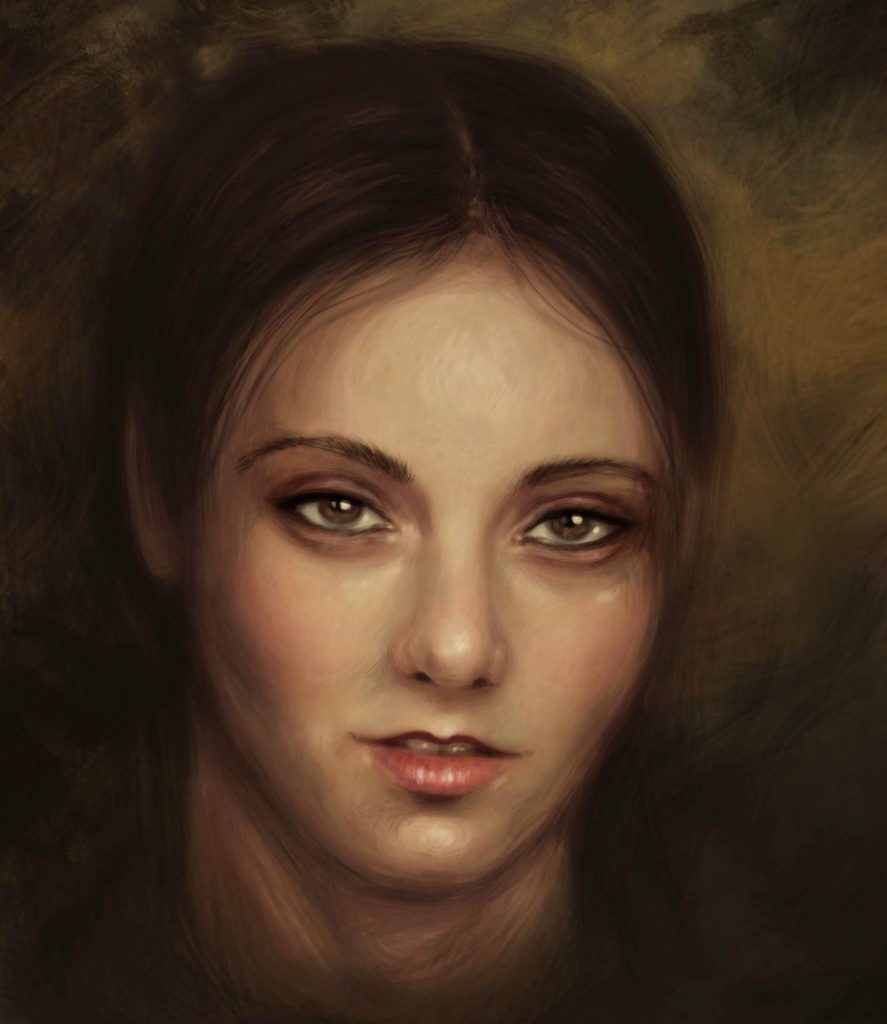
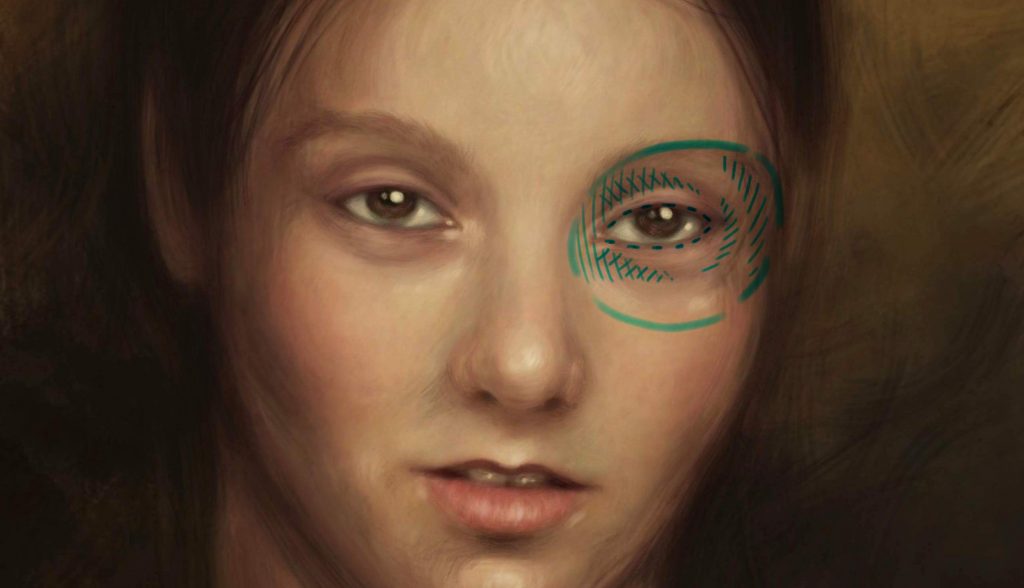
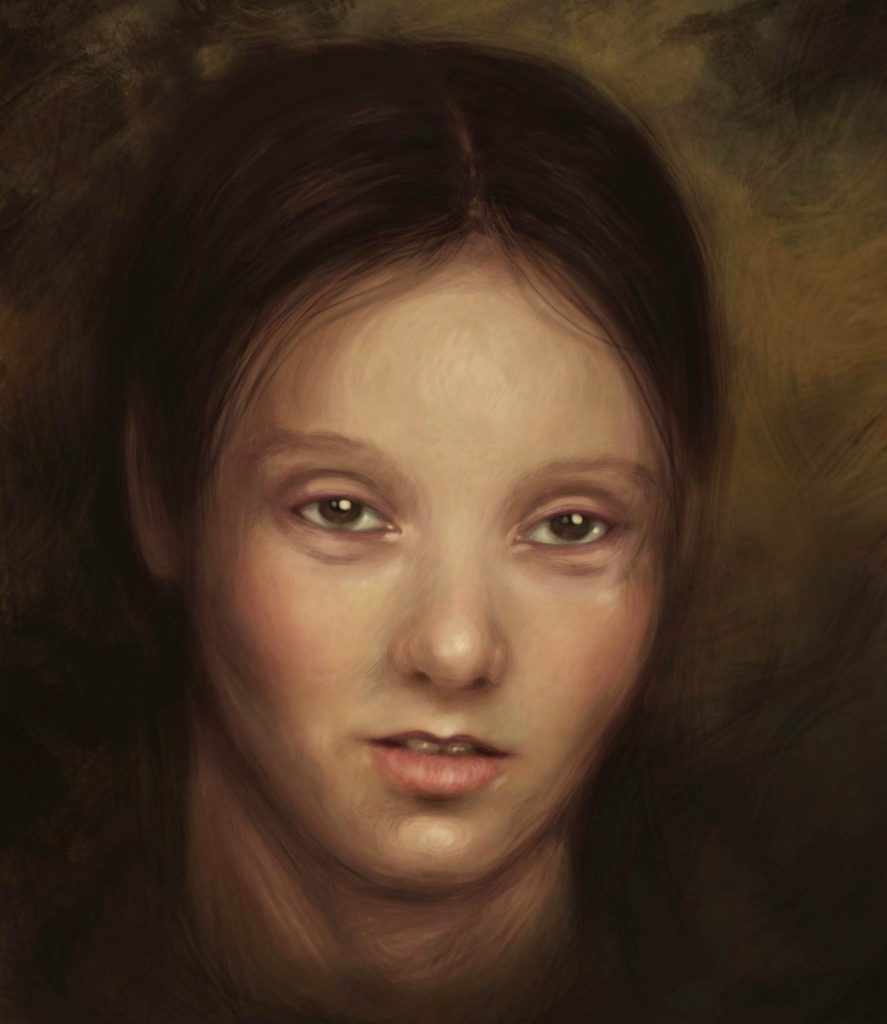
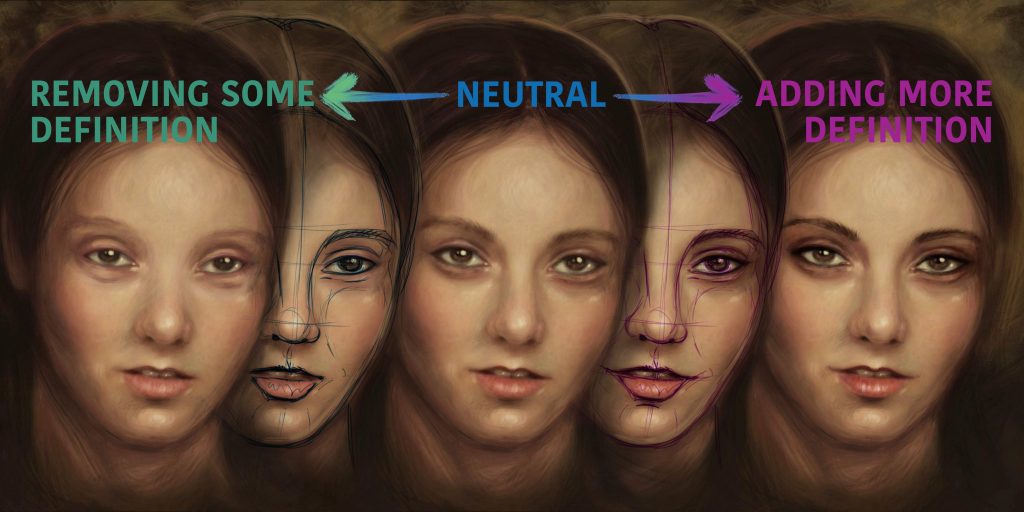
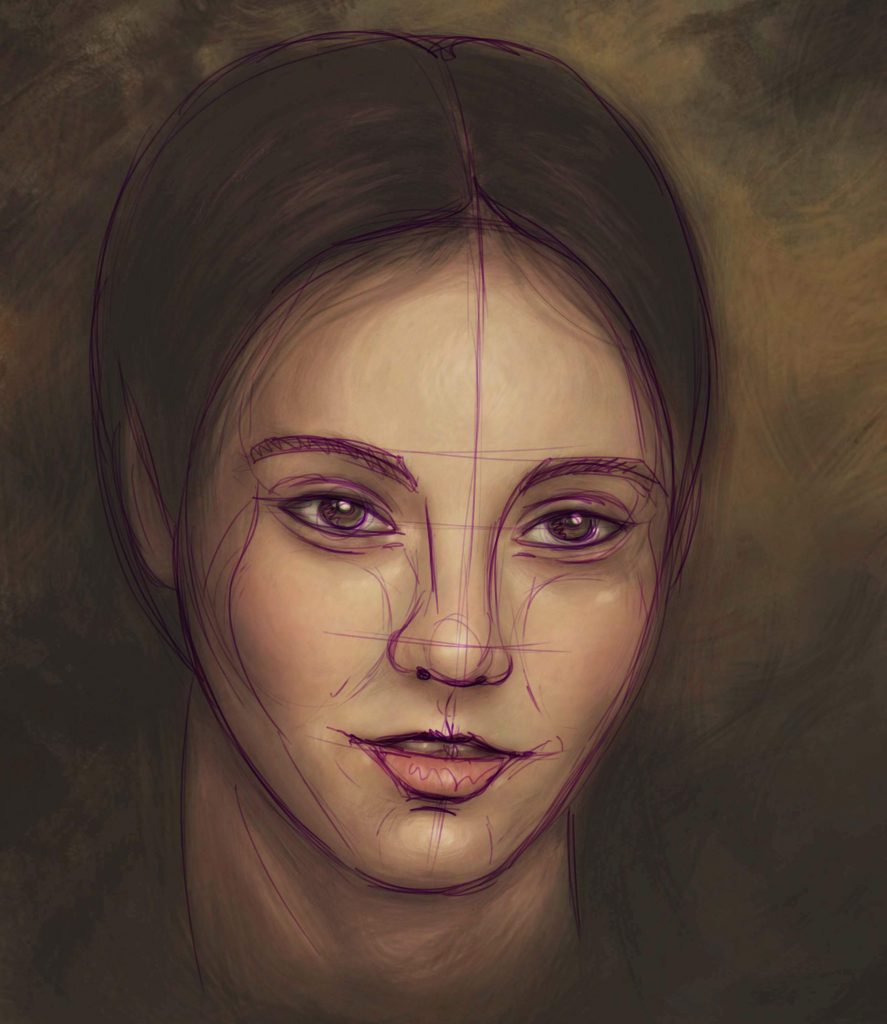
































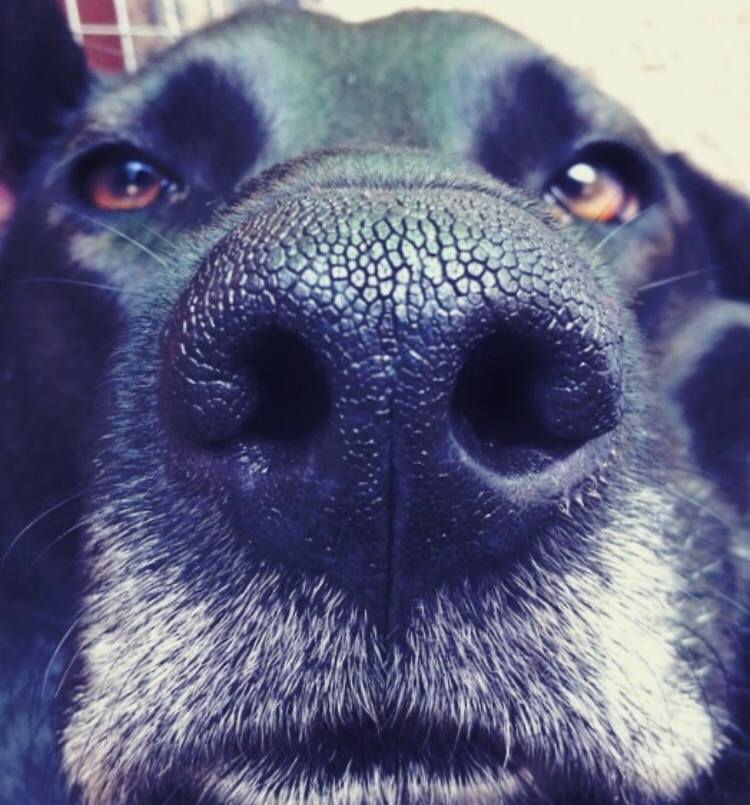
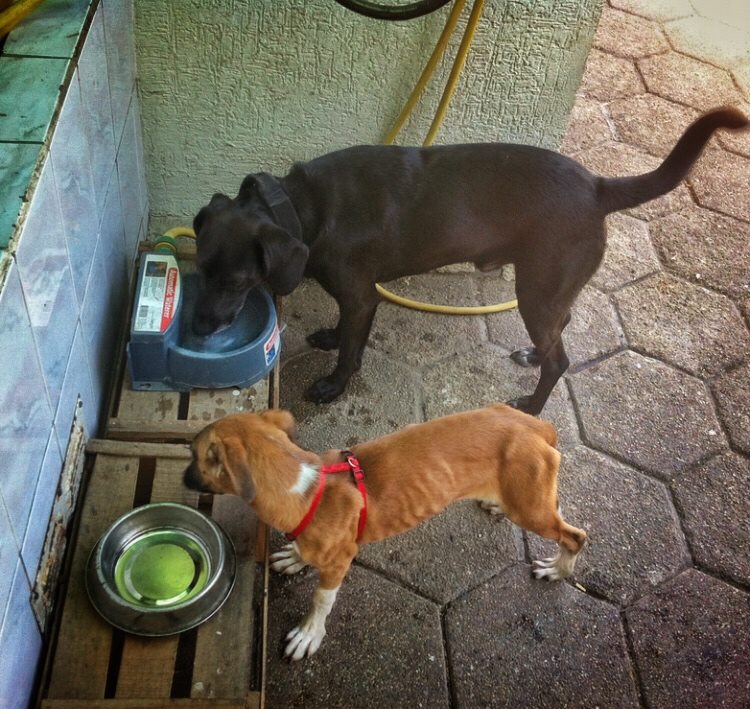
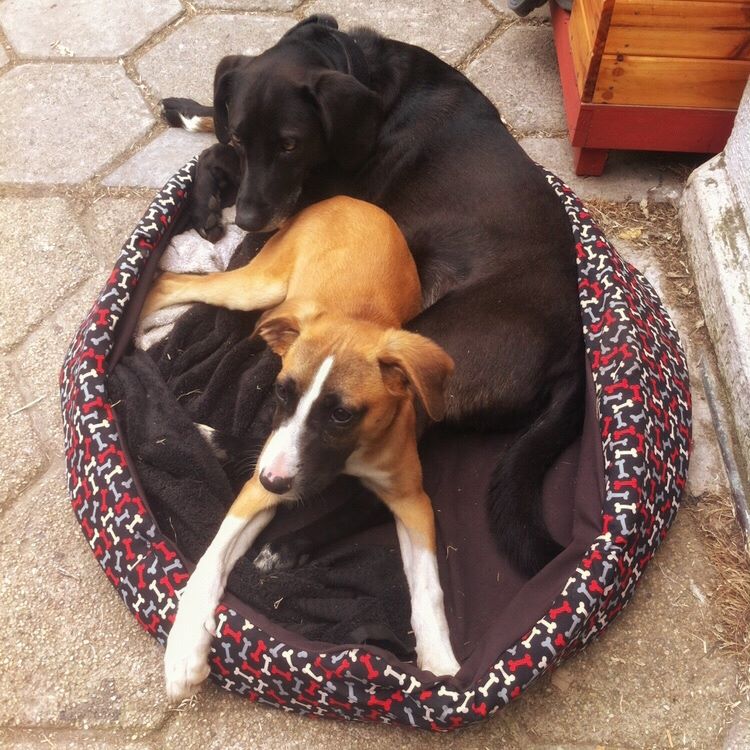
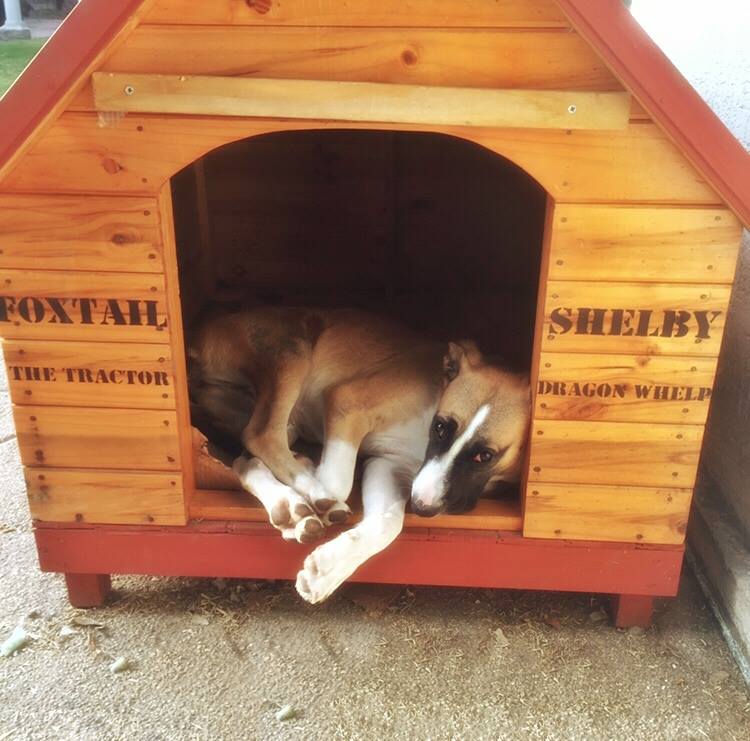

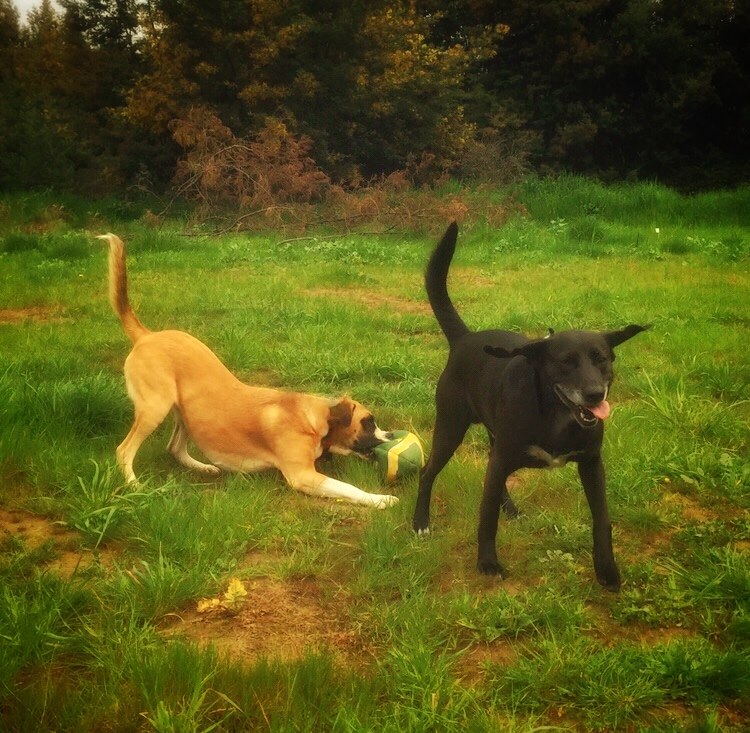
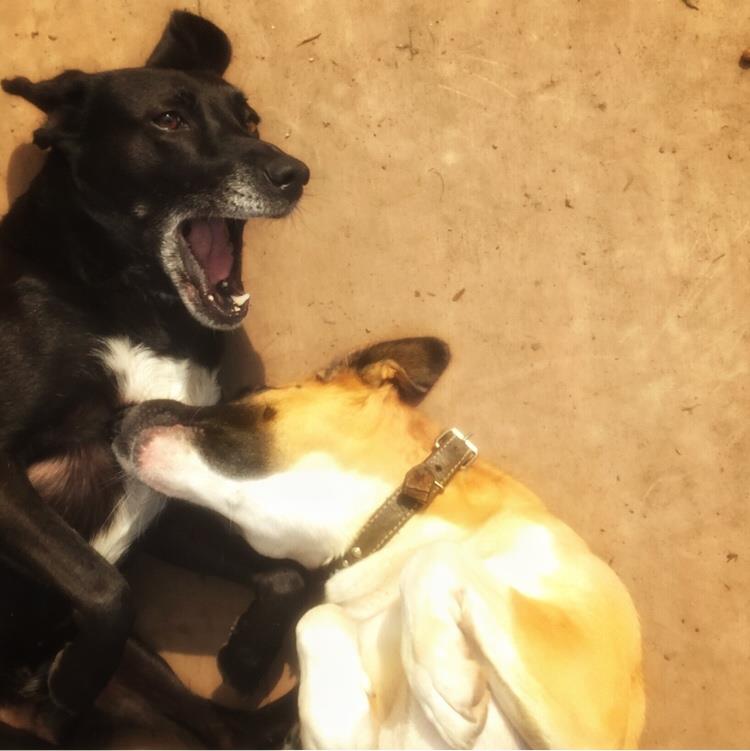
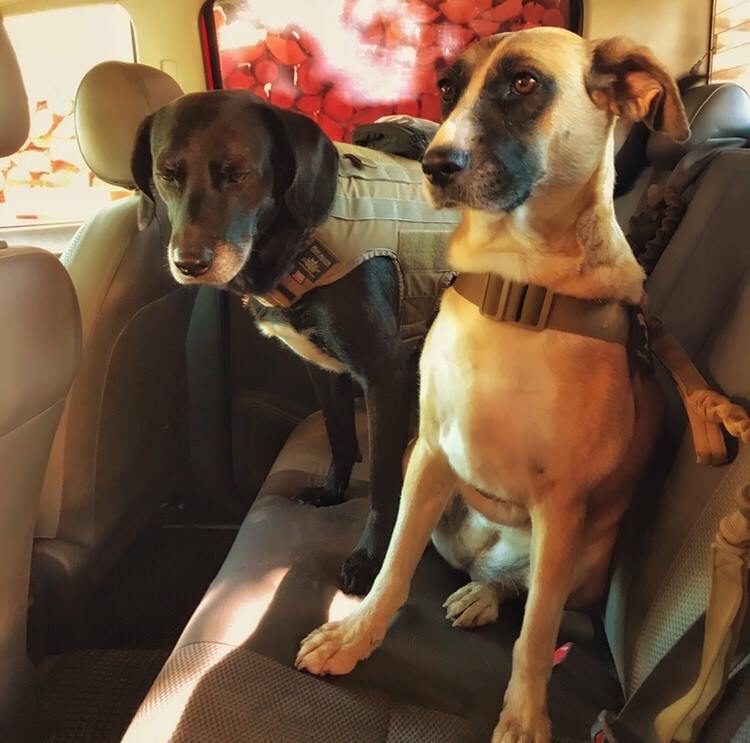
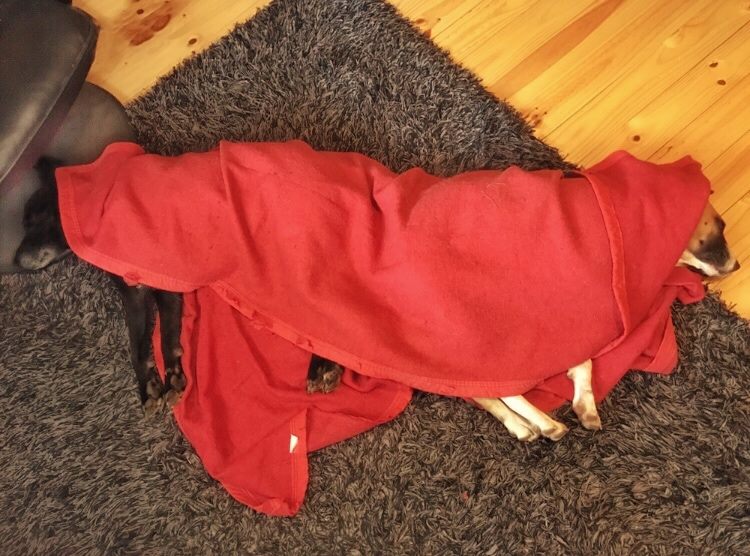
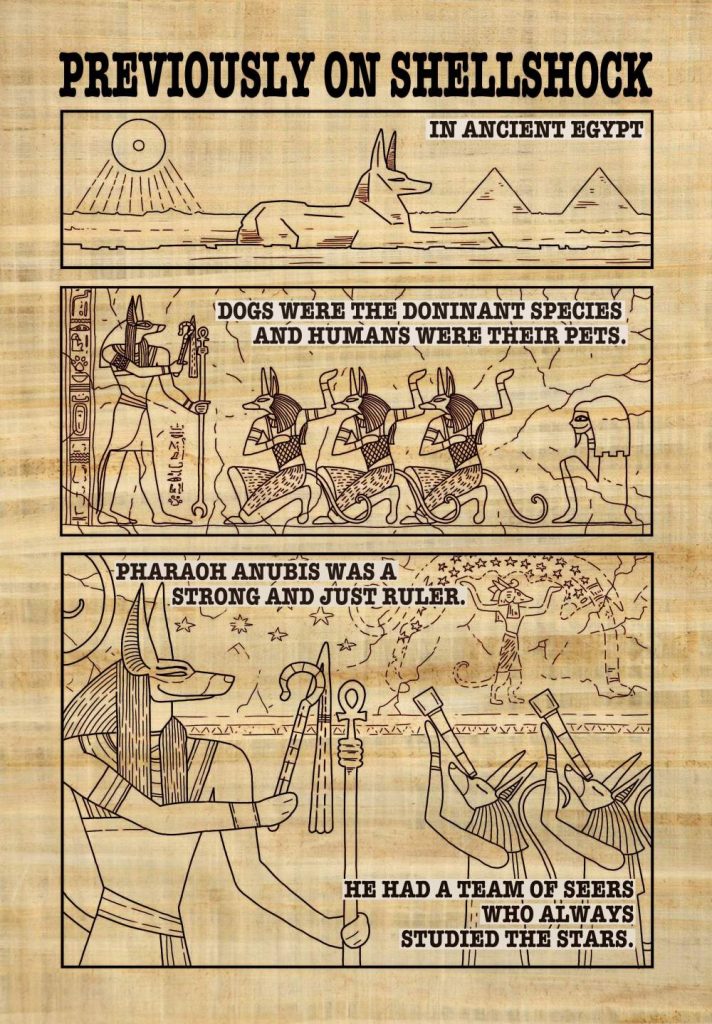
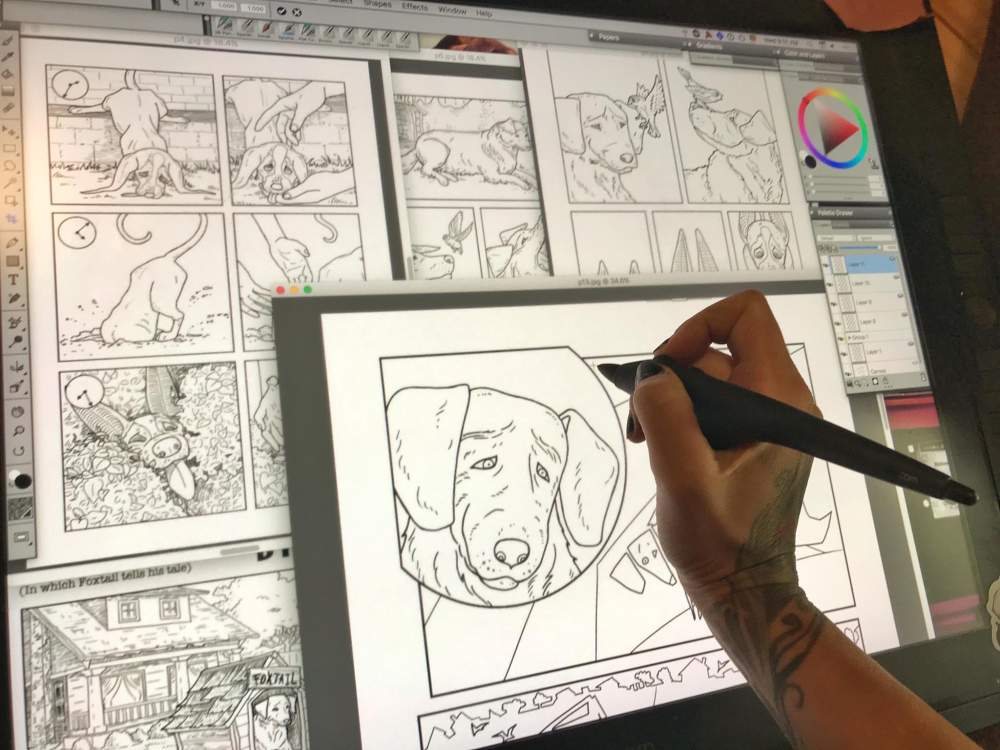
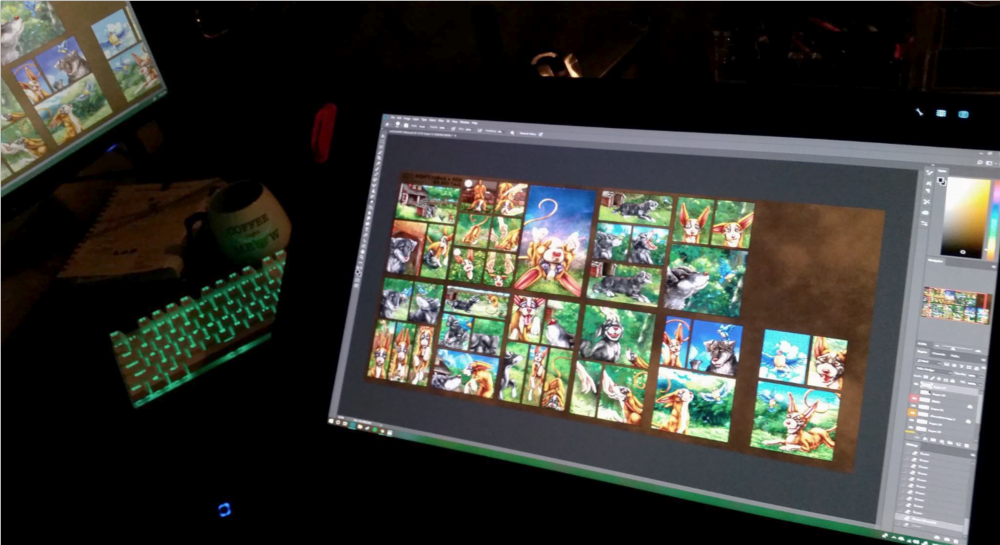
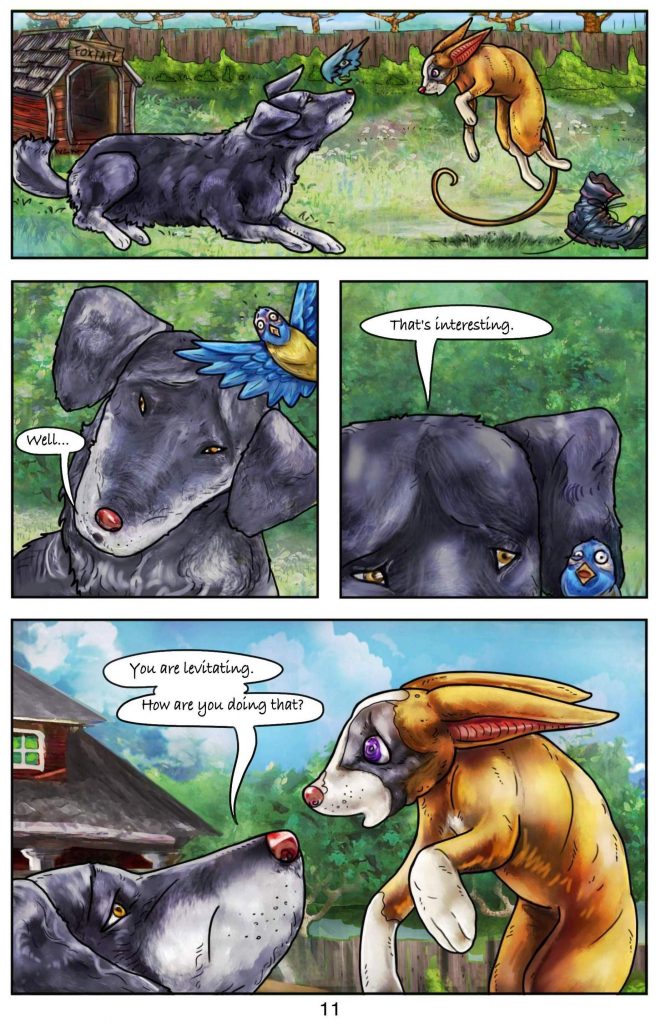
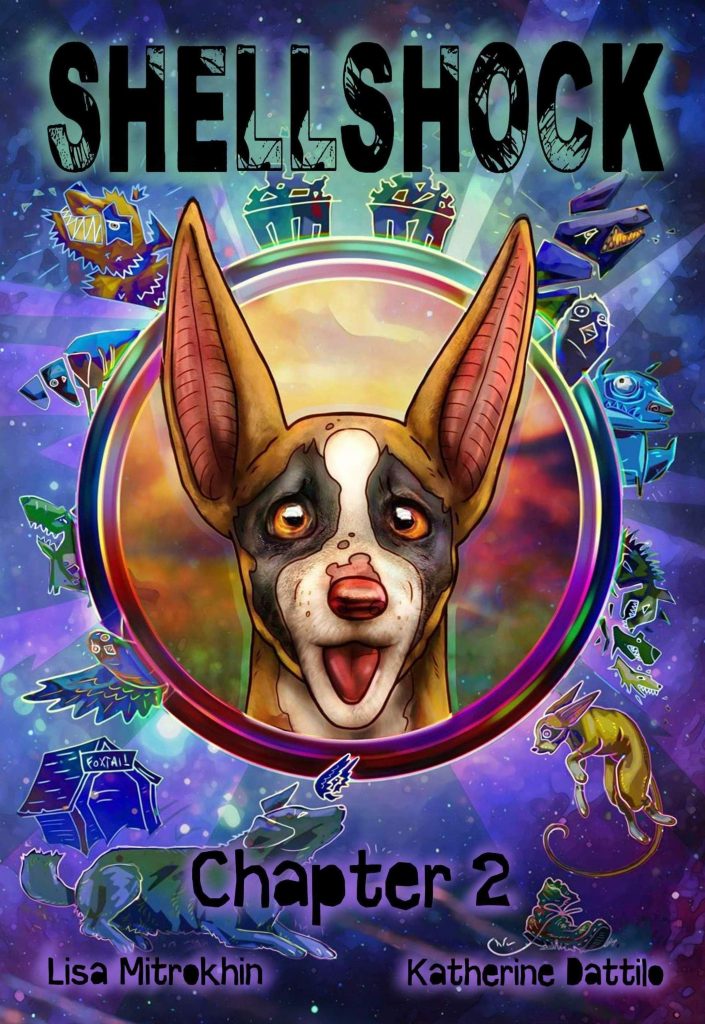

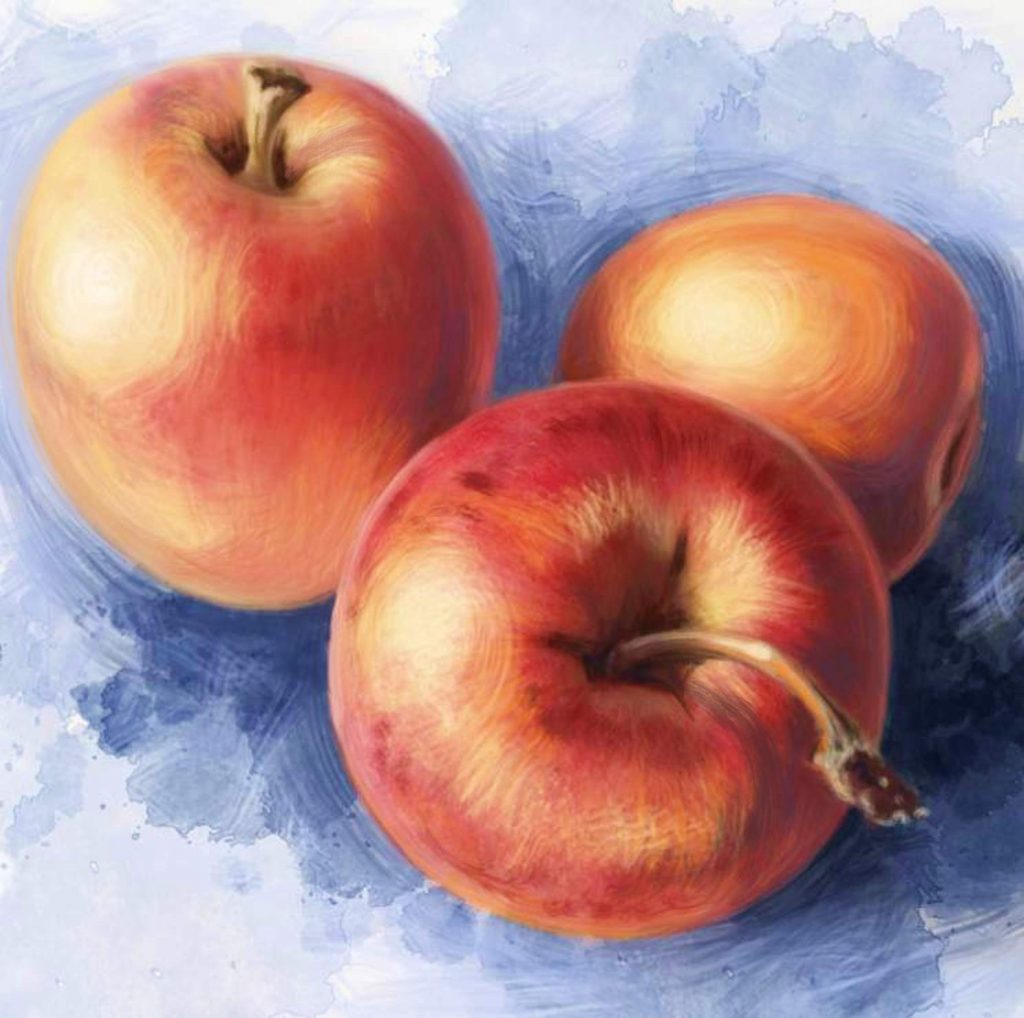
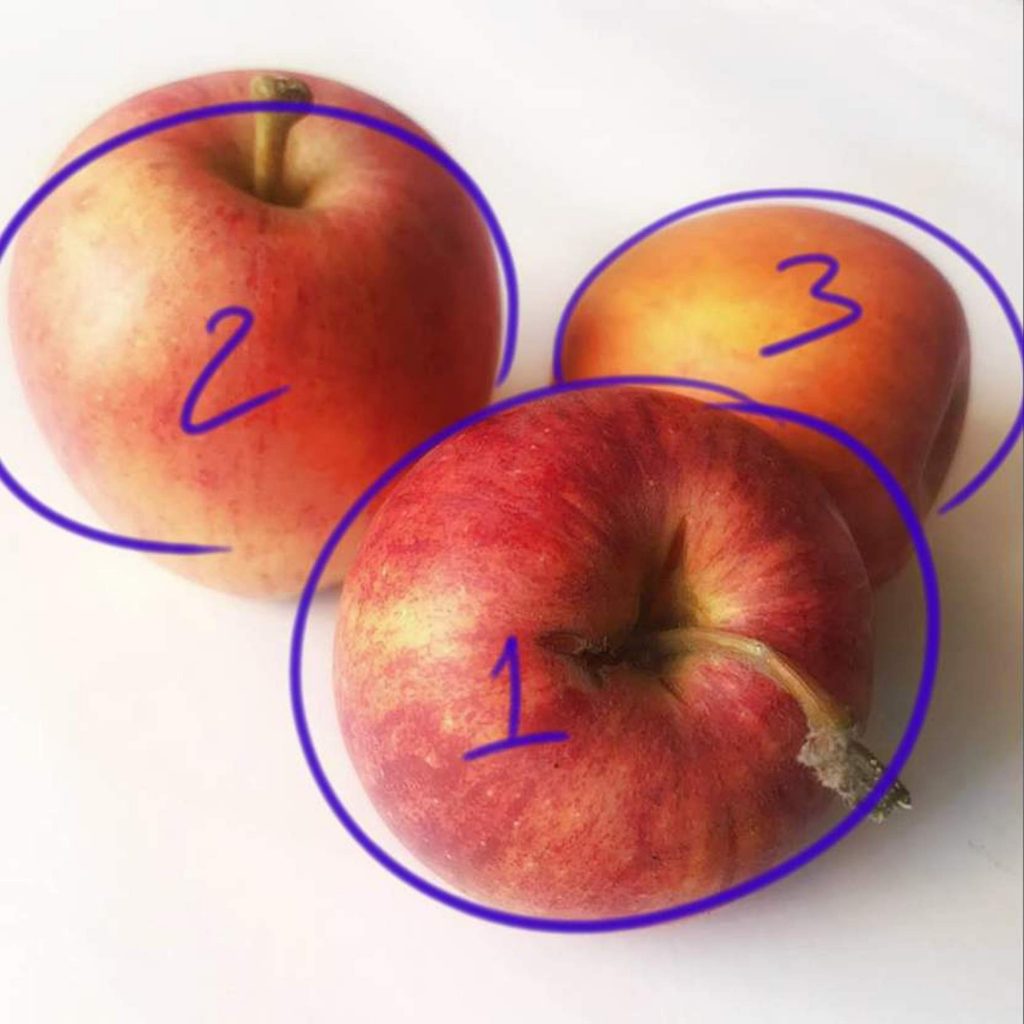
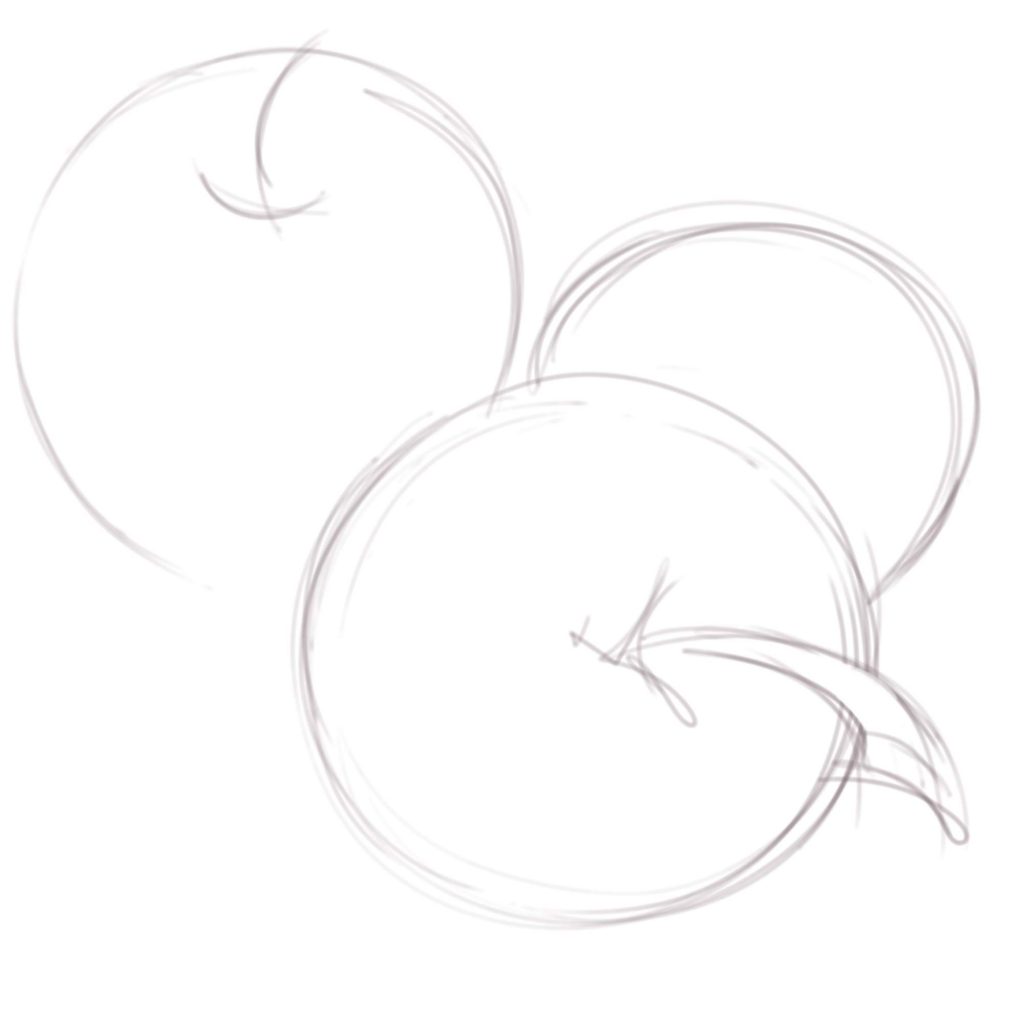
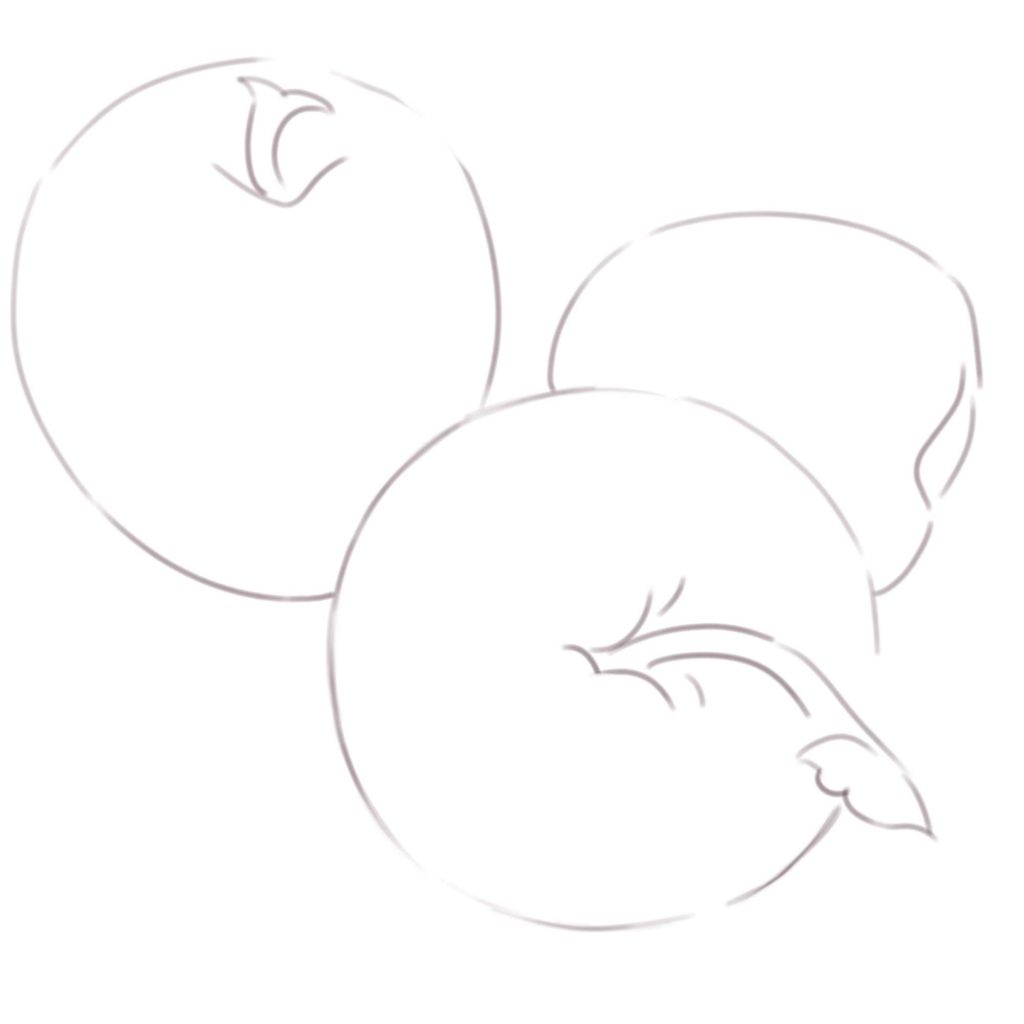
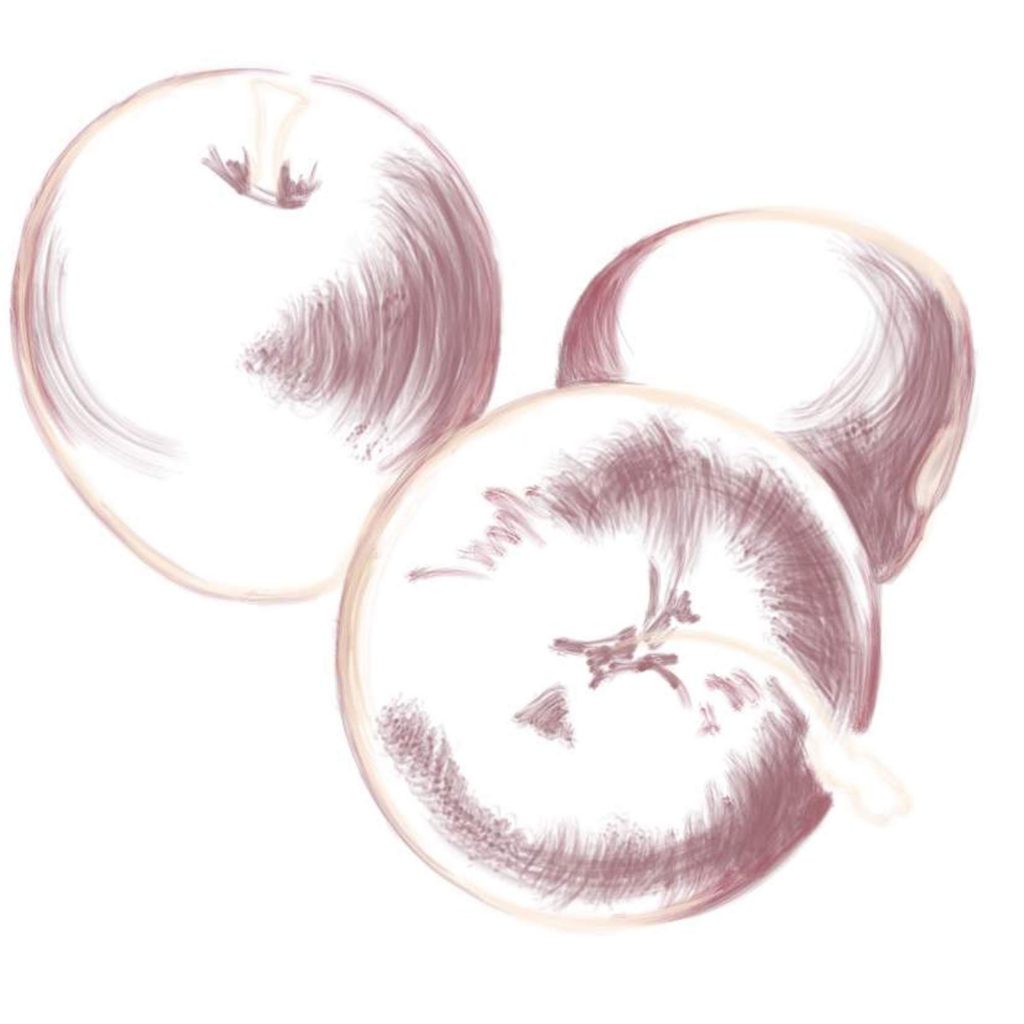
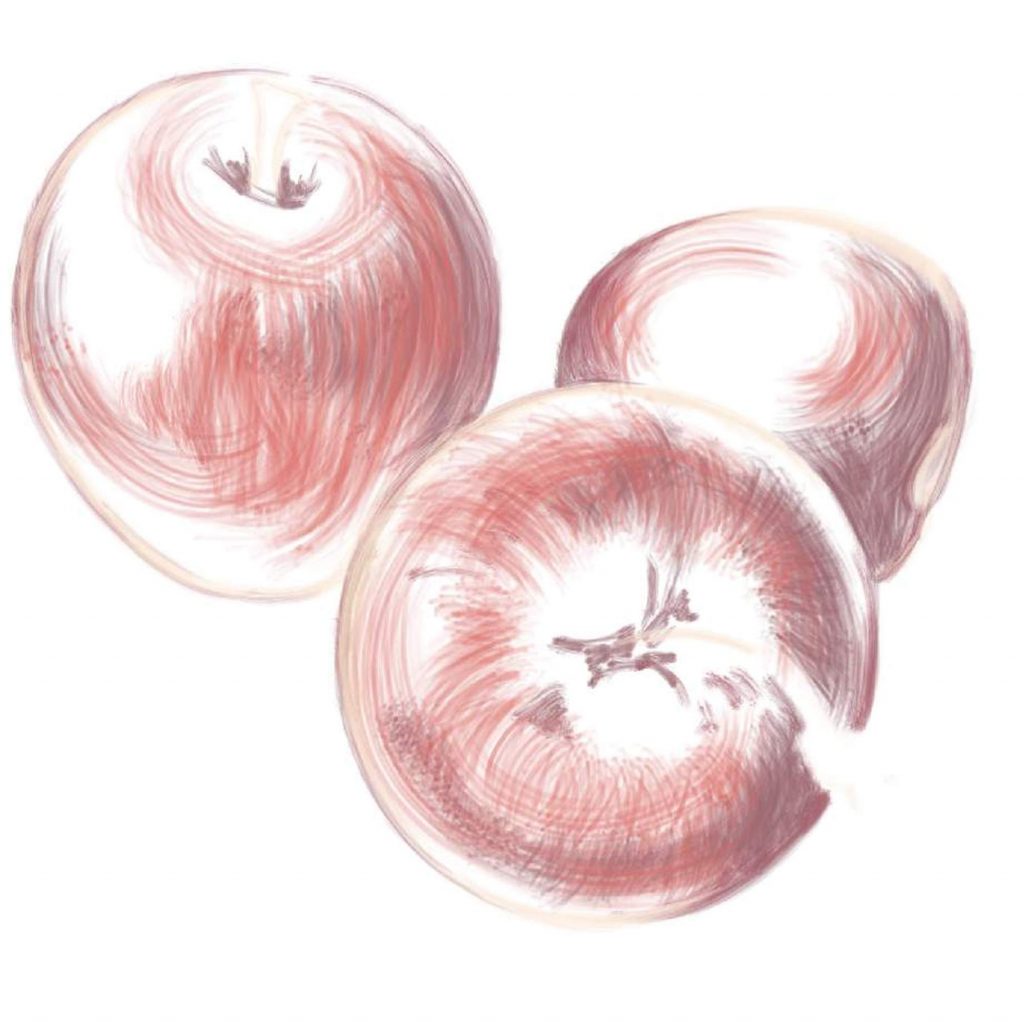
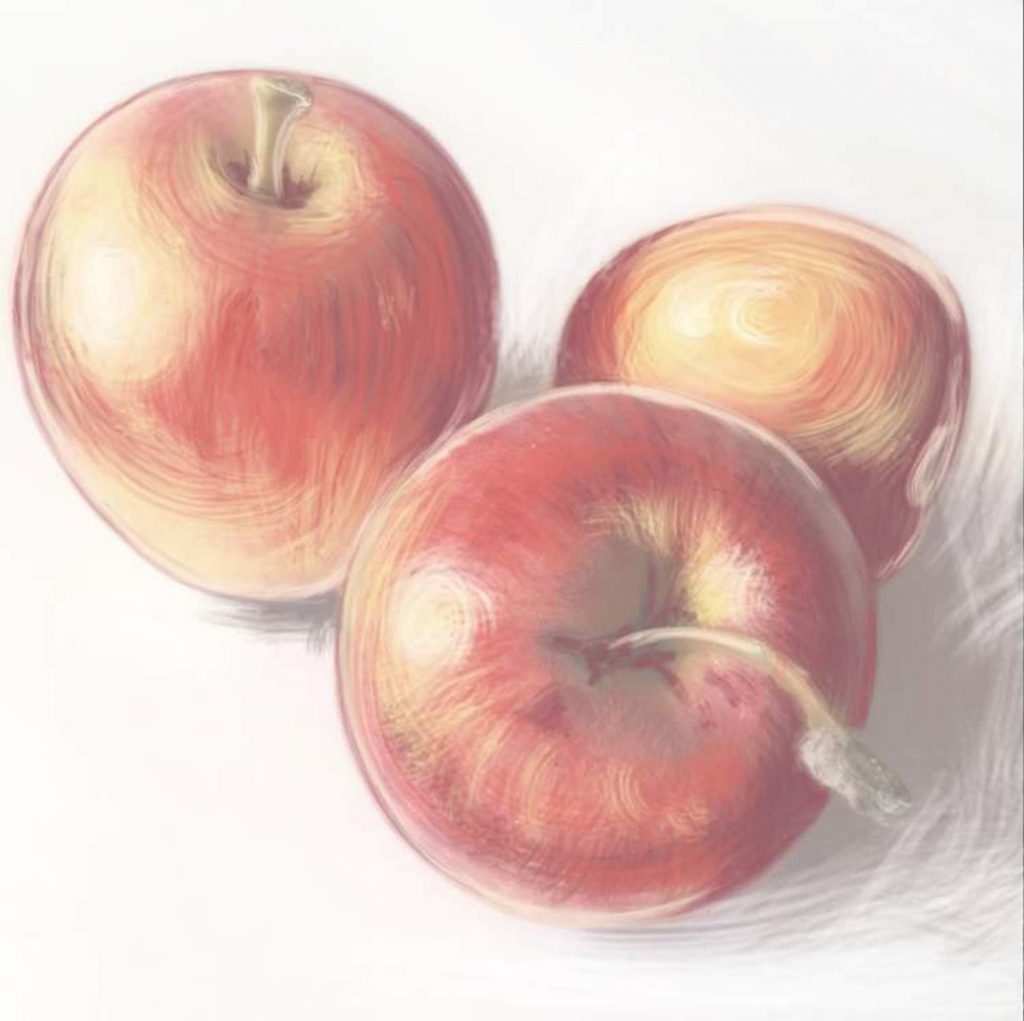
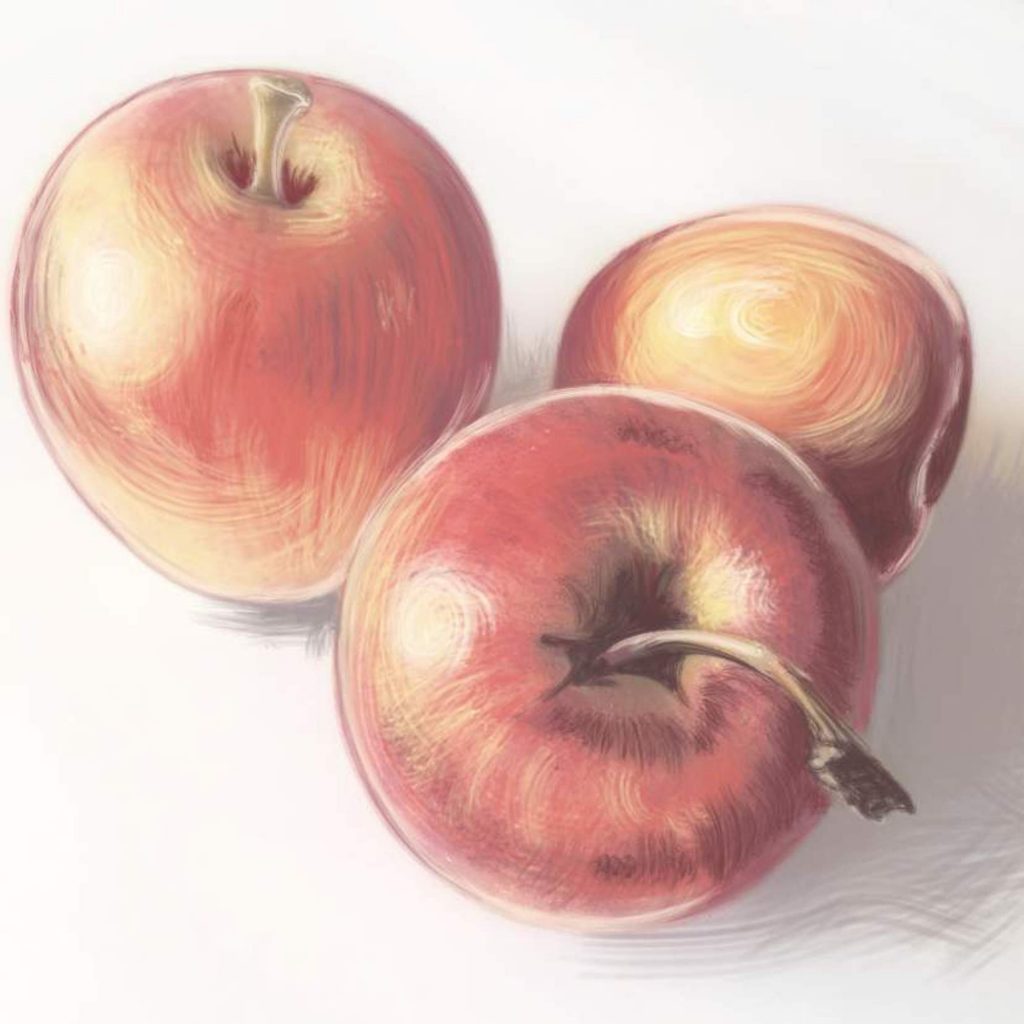
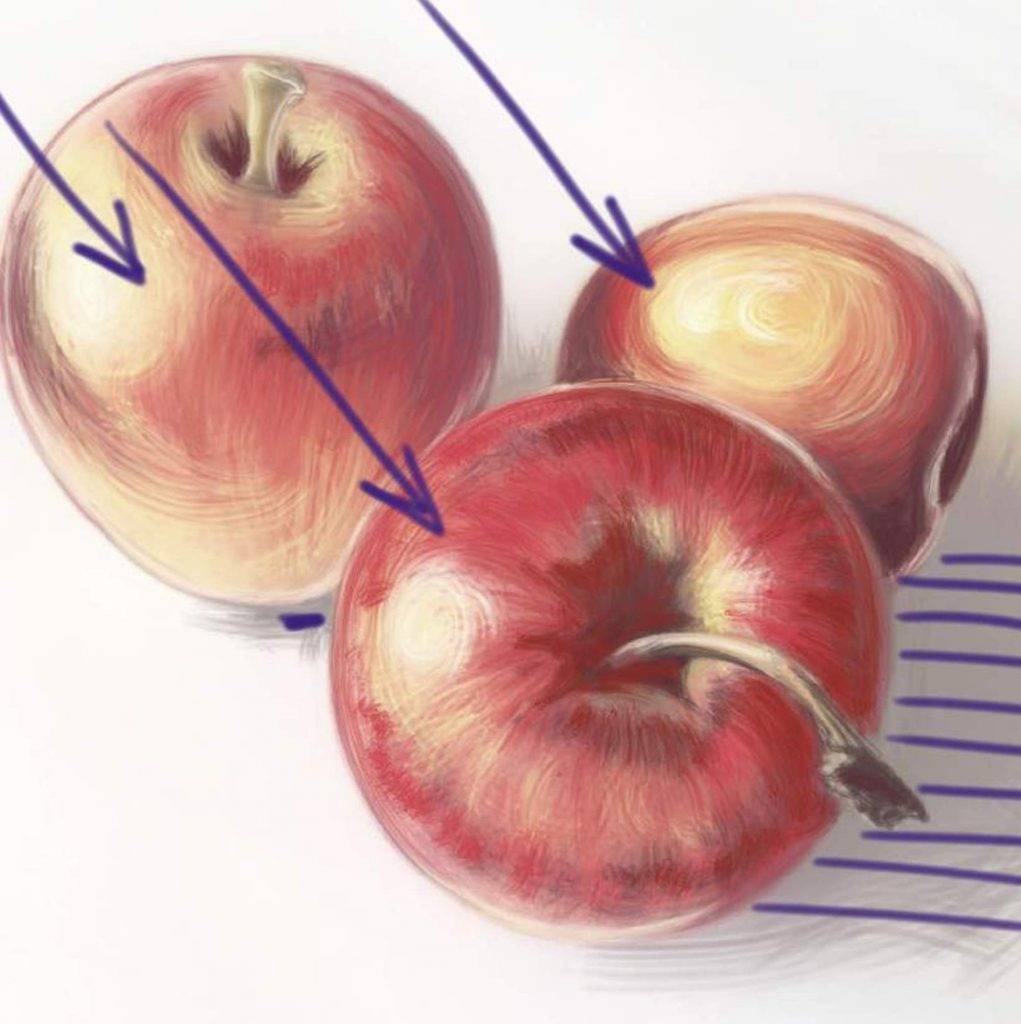
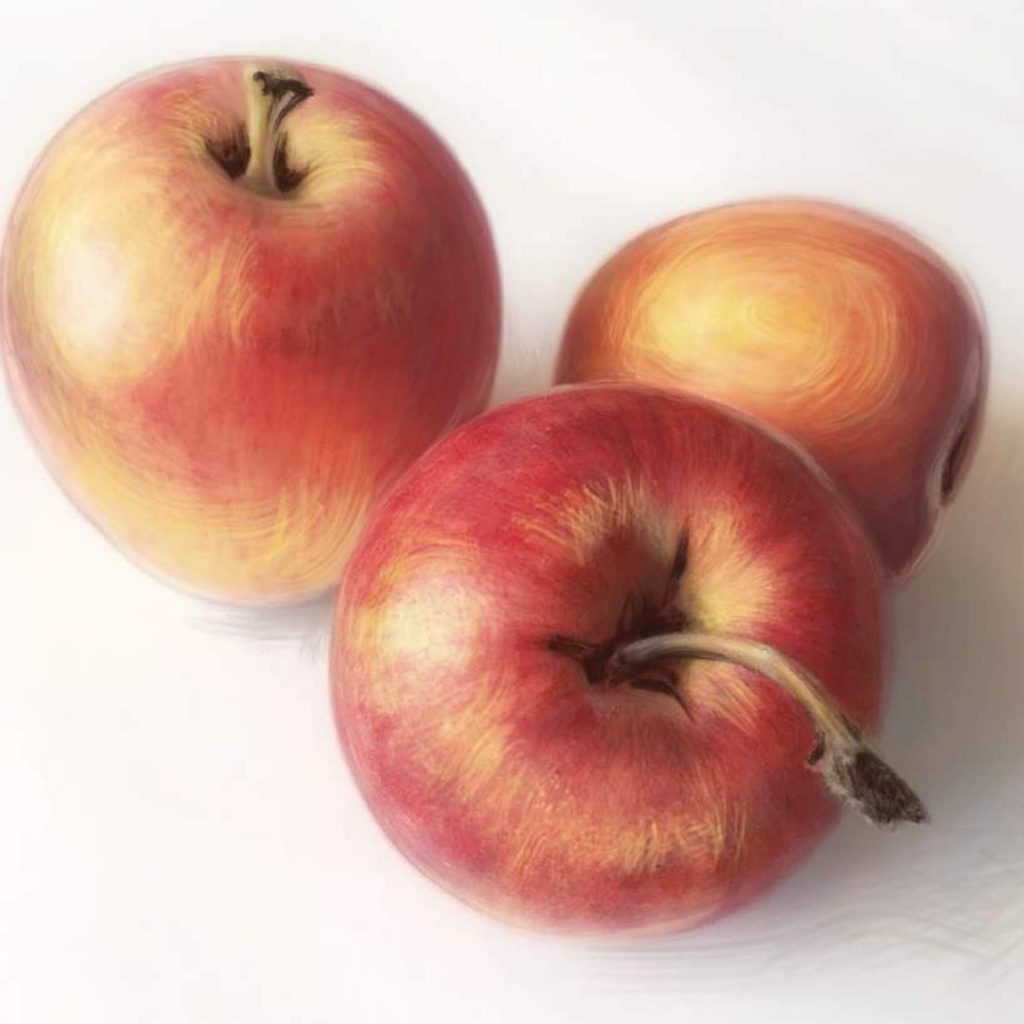
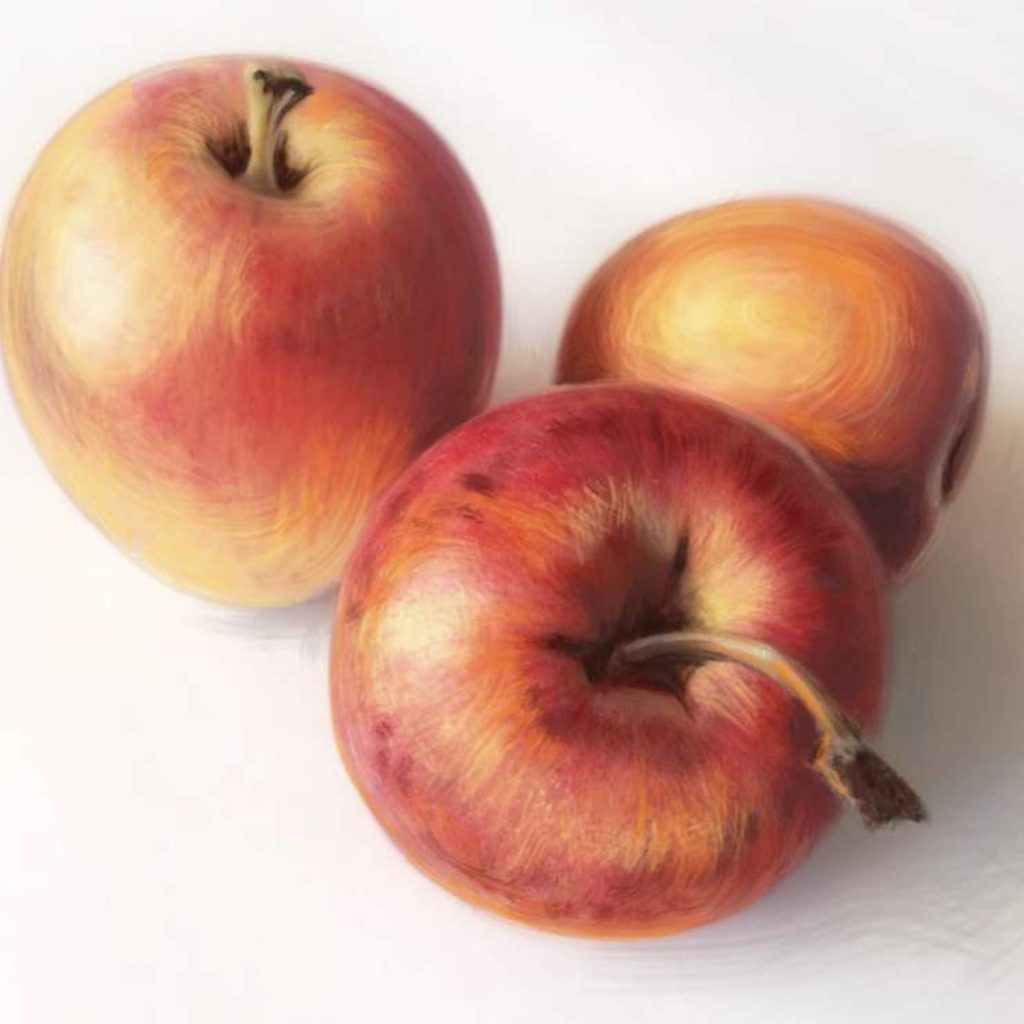
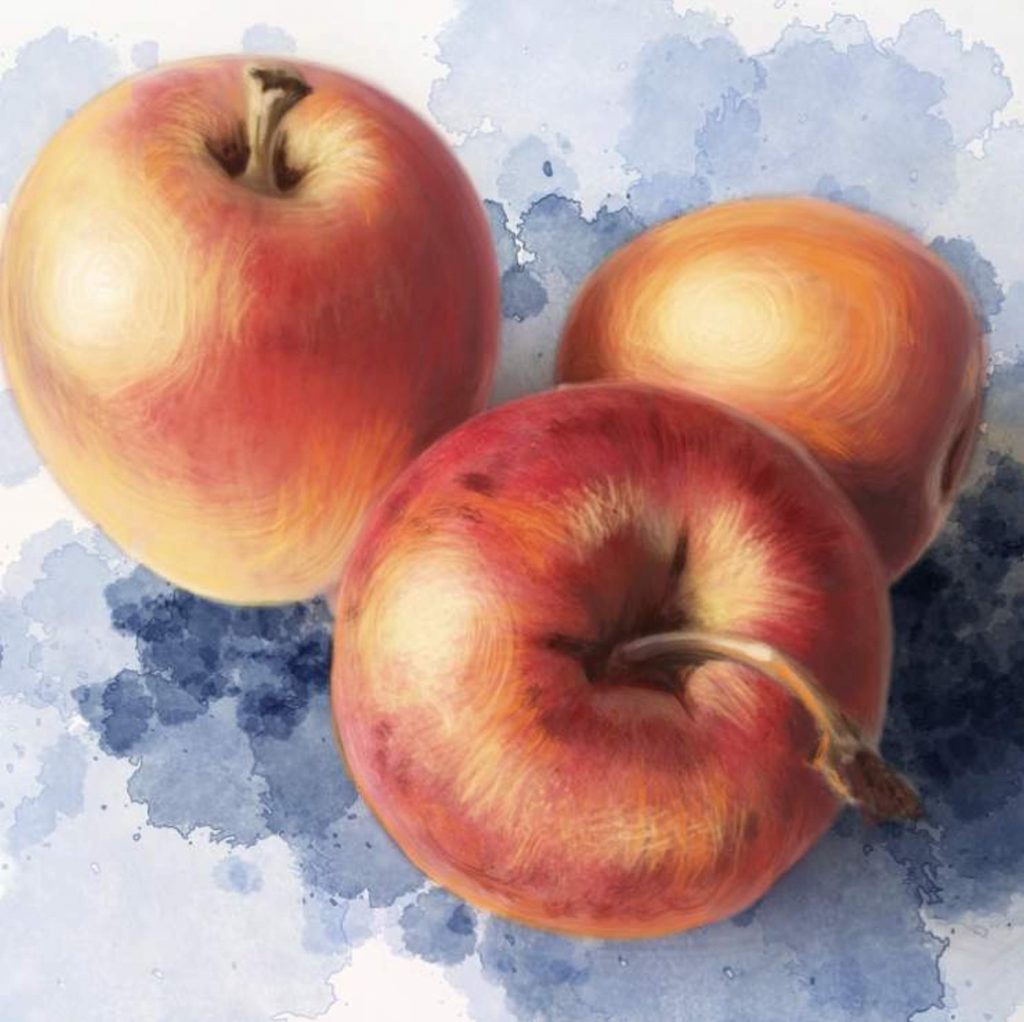
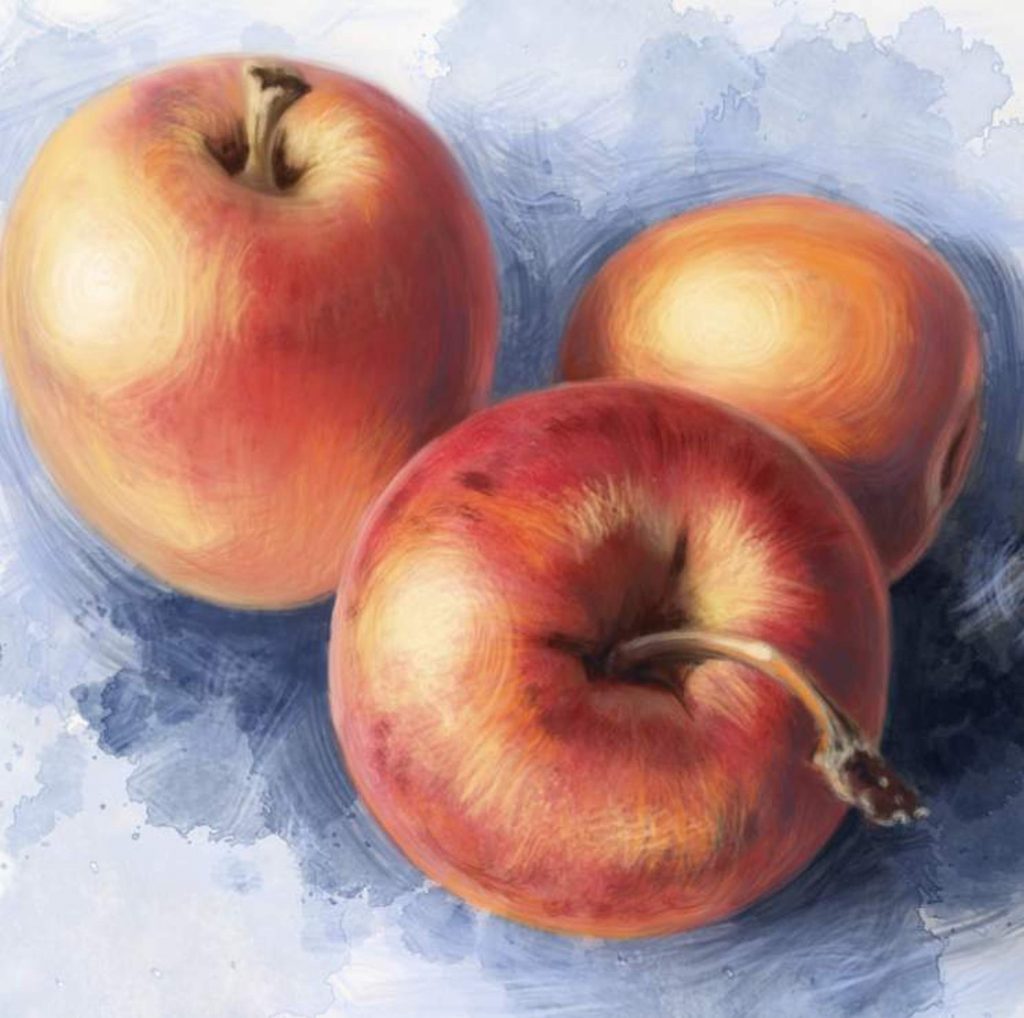
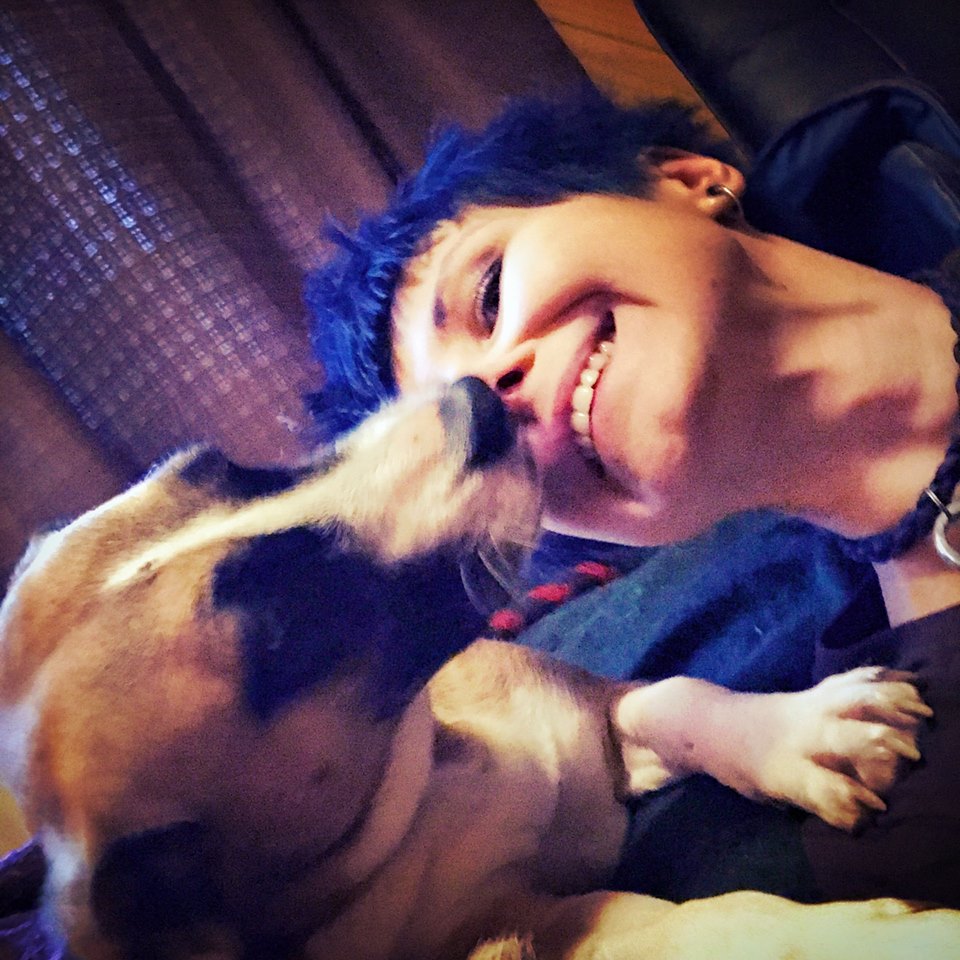
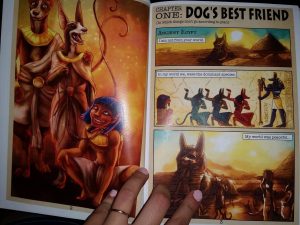 The novel will reveal that in ancient Egypt dogs were the dominant species, and humans were their pets. It was a peaceful world, where pets were loved and cared for. Unlike in the modern world, where dog is supposedly man’s best friend. While some dogs in some parts of the world have very cozy lives, there are millions still who are chained up, beaten, and even forced to race at the track. I wrote this book to illustrate the real problems that dogs today face in South America. I chose South America because this is where I live and these are the problems that are see every day. I didn’t want this book to be heavy and depressing. I didn’t want the readers to feel sad or guilty when reading it. Instead, I wanted each page to be entertaining, funny, witty, and just beautiful. This is why Shelby (or Shellshock as I often call her) is my main character.
The novel will reveal that in ancient Egypt dogs were the dominant species, and humans were their pets. It was a peaceful world, where pets were loved and cared for. Unlike in the modern world, where dog is supposedly man’s best friend. While some dogs in some parts of the world have very cozy lives, there are millions still who are chained up, beaten, and even forced to race at the track. I wrote this book to illustrate the real problems that dogs today face in South America. I chose South America because this is where I live and these are the problems that are see every day. I didn’t want this book to be heavy and depressing. I didn’t want the readers to feel sad or guilty when reading it. Instead, I wanted each page to be entertaining, funny, witty, and just beautiful. This is why Shelby (or Shellshock as I often call her) is my main character.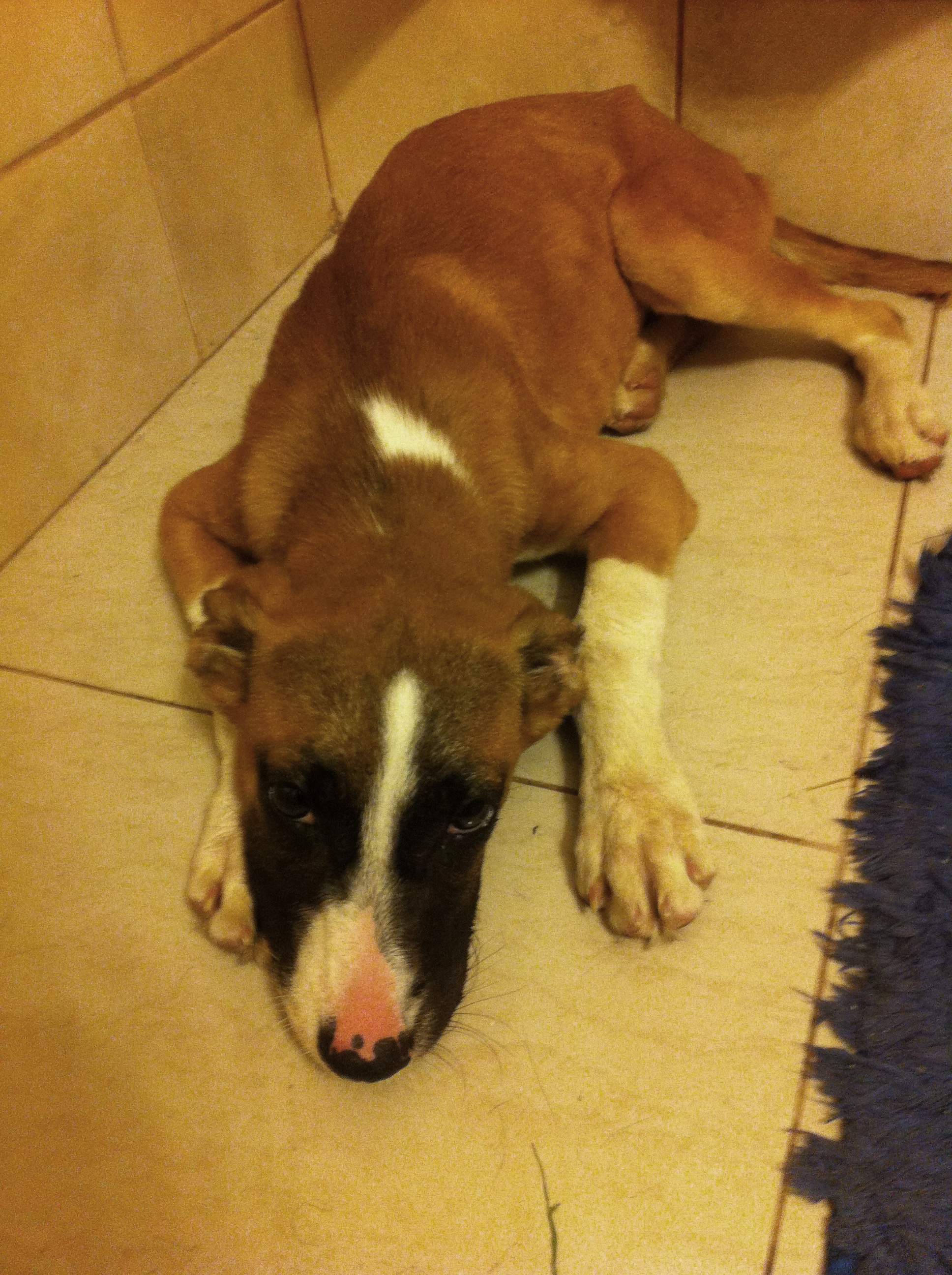
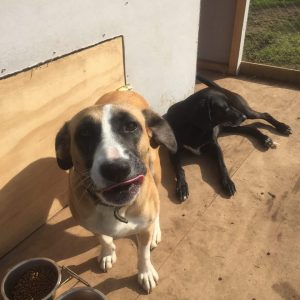
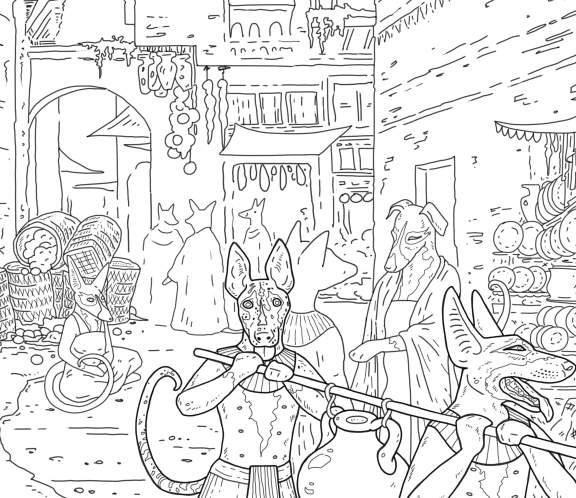
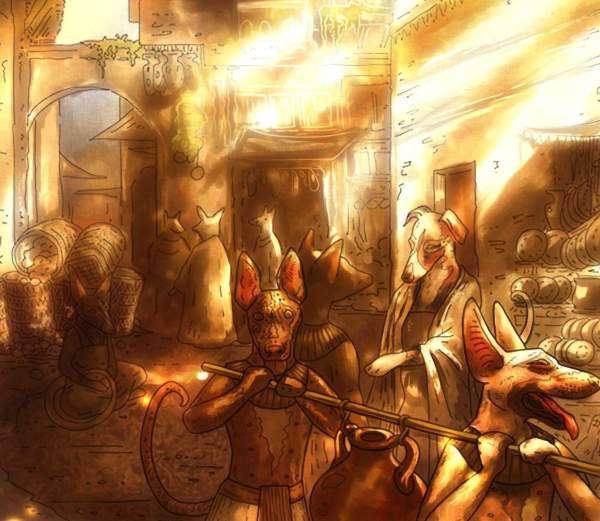
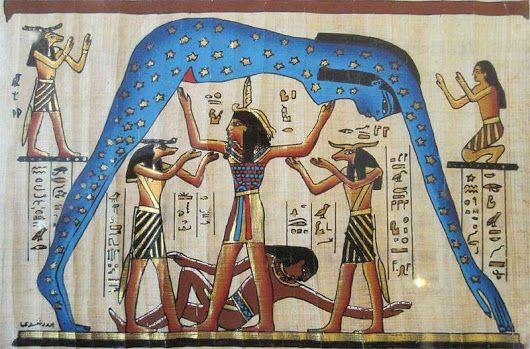
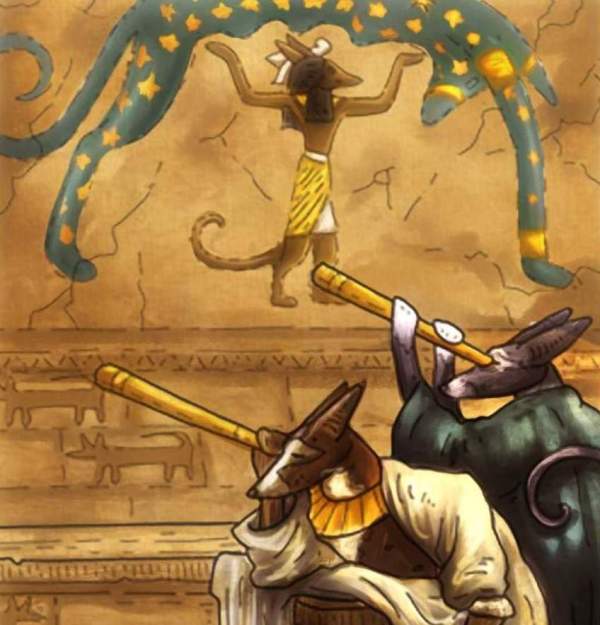
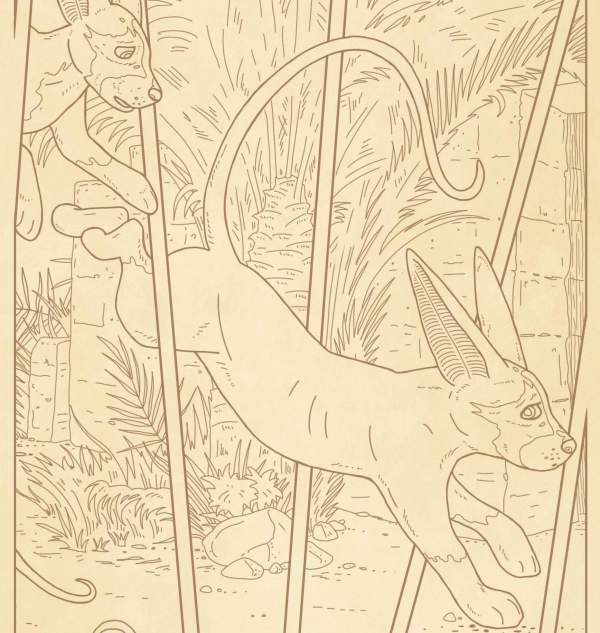
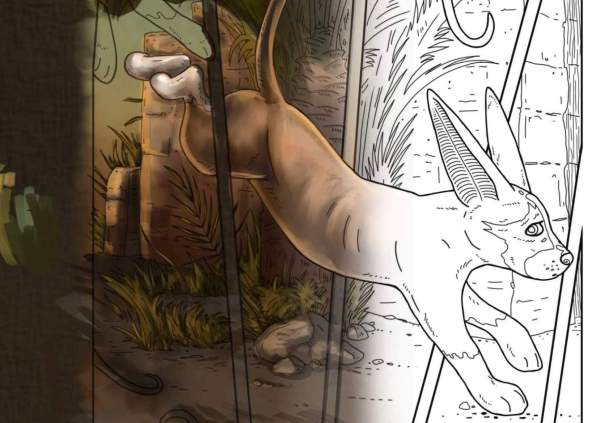
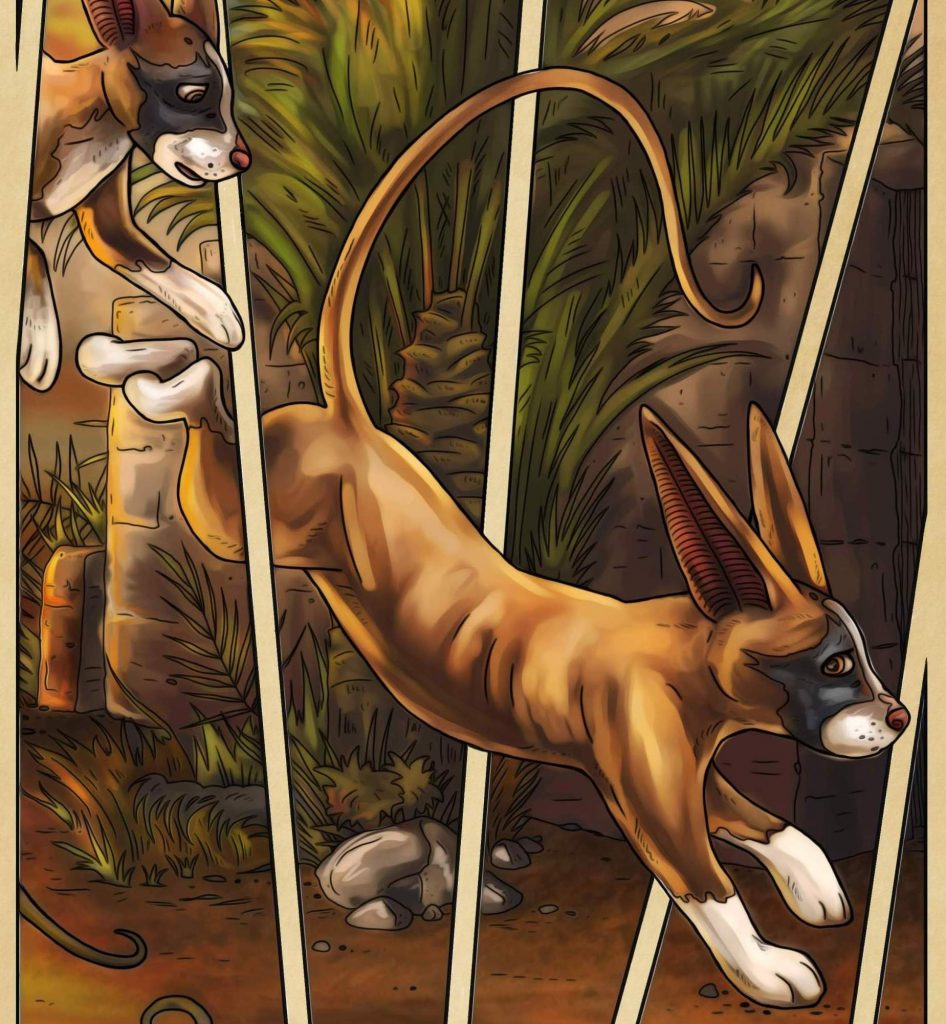

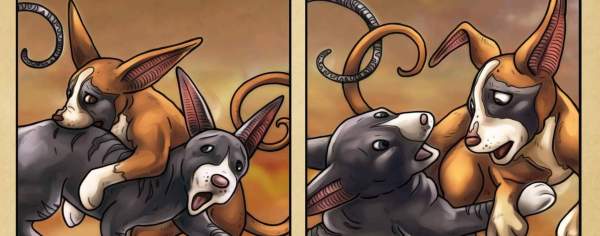
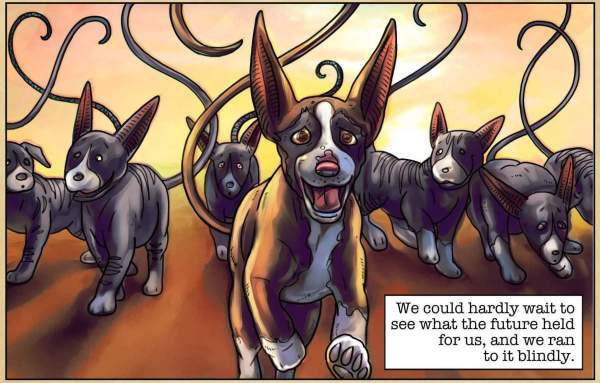

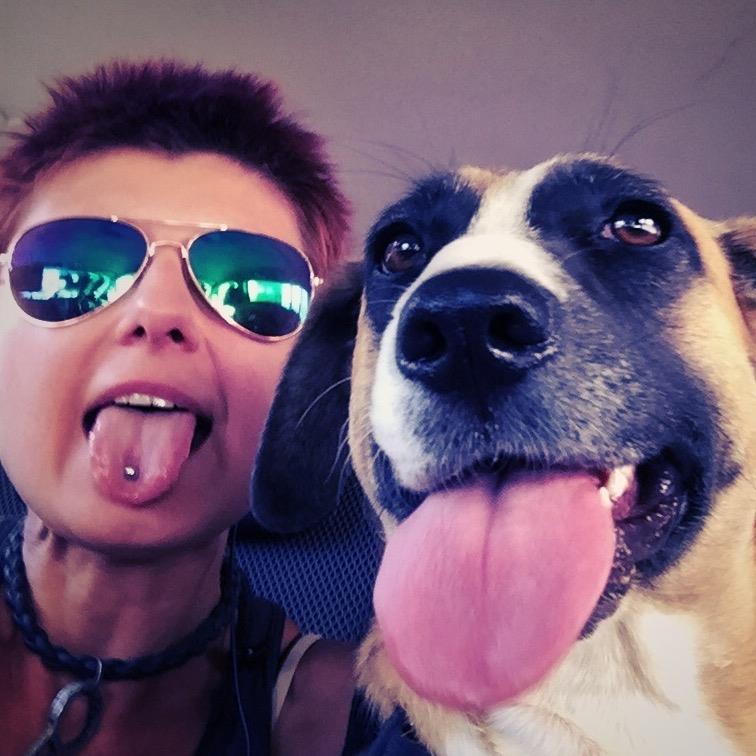
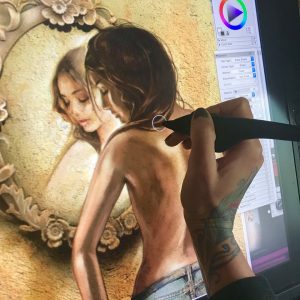 It turned out that Cally’s main character Sarah was in need of a custom-made tattoo from someone with experience in just that craft. The tattoo is so significant in this book that it’s almost its own character. Cally didn’t have to do a lot of talking for me to have enough mental images to begin my work. She simply shared with me three of the 662 pages of her novel, and I knew everything I need to know about what Sarah looked liked and enough about her personality to portray that through body language and choice of clothing. One of the advantages of working with an author is that they tend to be quite articulate. After all, the readers have to see her character in their minds just as clearly as I was about to see her on my digital drawing page (for a more technical description of my digital painting process check out my article
It turned out that Cally’s main character Sarah was in need of a custom-made tattoo from someone with experience in just that craft. The tattoo is so significant in this book that it’s almost its own character. Cally didn’t have to do a lot of talking for me to have enough mental images to begin my work. She simply shared with me three of the 662 pages of her novel, and I knew everything I need to know about what Sarah looked liked and enough about her personality to portray that through body language and choice of clothing. One of the advantages of working with an author is that they tend to be quite articulate. After all, the readers have to see her character in their minds just as clearly as I was about to see her on my digital drawing page (for a more technical description of my digital painting process check out my article 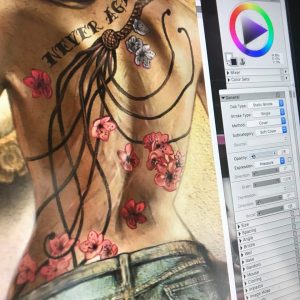 Now that I had Sarah’s body, face and hair painted and approved by Callystin, I moved onto the most important part – the tattoo. Sarah’s tattoo is complex enough for an artist to design for a real back. It would be a challenge to tailor it for a fictional 1200 by 2200 pixel painted character. I had to approach it the same way I would a real tattoo. Having read Cally’s description of it over and over again, I drew a fully detailed cat-o-nine tails whip with a braided leather handle and cherry blossoms scattered all around. I then wrapped the design around my character, curving and blurring it to match my painting style in this piece. Actually, the most time consuming and complicated part of the process was the amount of distortion I had to apply to my otherwise flawless and highly detailed tattoo design in order to make it look realistic in the given light and remaining true to my brushstrokes. The application of the tattoo to Sarah’s back was a week long project. After submission, Cally requested a few edits and adjustments, specifically in relation to individual tails and their direction, the placement and color of specific blossoms, and clearly readable text “Never Again”. After another few days of edits we arrived at the tattoo that we both agreed was perfect. The only final adjustment she asked for was the removal of visible scars from Sarah’s back. I imagined that most of Sarah’s scars would still be visible, if not for any other reason but for the reader to see that she has them. Cally had a very firm and specific request to remove the scars, explaining to me that the whole reason for the tattoo is to hide the scars all together. The audience does not need to know the full scar story from the cover. They will find out while reading. After discussing the technicalities of actually covering scars with tattoos, we came to an artistic agreement and I cleaned up Sarah’s back, while Cally cleaned up some textual details on the matter.
Now that I had Sarah’s body, face and hair painted and approved by Callystin, I moved onto the most important part – the tattoo. Sarah’s tattoo is complex enough for an artist to design for a real back. It would be a challenge to tailor it for a fictional 1200 by 2200 pixel painted character. I had to approach it the same way I would a real tattoo. Having read Cally’s description of it over and over again, I drew a fully detailed cat-o-nine tails whip with a braided leather handle and cherry blossoms scattered all around. I then wrapped the design around my character, curving and blurring it to match my painting style in this piece. Actually, the most time consuming and complicated part of the process was the amount of distortion I had to apply to my otherwise flawless and highly detailed tattoo design in order to make it look realistic in the given light and remaining true to my brushstrokes. The application of the tattoo to Sarah’s back was a week long project. After submission, Cally requested a few edits and adjustments, specifically in relation to individual tails and their direction, the placement and color of specific blossoms, and clearly readable text “Never Again”. After another few days of edits we arrived at the tattoo that we both agreed was perfect. The only final adjustment she asked for was the removal of visible scars from Sarah’s back. I imagined that most of Sarah’s scars would still be visible, if not for any other reason but for the reader to see that she has them. Cally had a very firm and specific request to remove the scars, explaining to me that the whole reason for the tattoo is to hide the scars all together. The audience does not need to know the full scar story from the cover. They will find out while reading. After discussing the technicalities of actually covering scars with tattoos, we came to an artistic agreement and I cleaned up Sarah’s back, while Cally cleaned up some textual details on the matter.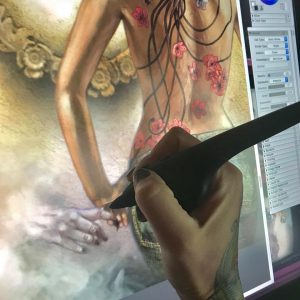 My next subject of interest was something that my author described as optional, but I immediately saw as inevitable. While Sarah is an obviously attractive young woman with an enticing full back tattoo, this is more than just a romance novel, it is a paranormal romance novel. I felt that the paranormal part was important to at least suggest visually. This is where Sarah’s glance direction comes into play. I specifically painted her looking down and at her hand, in order to have a platform to introduce a mysterious supernatural hand inviting her into its otherworldly haze. Now it all comes together. Now we know what seduces Sarah’s curiously. It is this human, yet animal-like, hand in the mist. This was probably my most favorite part of the project. I wanted the pale beastly hand to appear as mysterious as possible, revealing nothing of its character yet teasing the audience into having to find out. I wanted the viewers and the readers to be as intrigued by the hand as Sarah is.
My next subject of interest was something that my author described as optional, but I immediately saw as inevitable. While Sarah is an obviously attractive young woman with an enticing full back tattoo, this is more than just a romance novel, it is a paranormal romance novel. I felt that the paranormal part was important to at least suggest visually. This is where Sarah’s glance direction comes into play. I specifically painted her looking down and at her hand, in order to have a platform to introduce a mysterious supernatural hand inviting her into its otherworldly haze. Now it all comes together. Now we know what seduces Sarah’s curiously. It is this human, yet animal-like, hand in the mist. This was probably my most favorite part of the project. I wanted the pale beastly hand to appear as mysterious as possible, revealing nothing of its character yet teasing the audience into having to find out. I wanted the viewers and the readers to be as intrigued by the hand as Sarah is.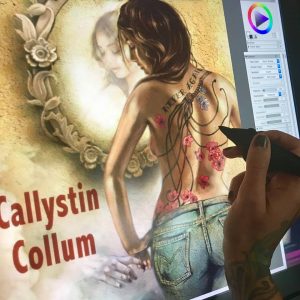 Now that the mysterious hand was done and approved by the author, I moved on to polishing up the details on the image as a whole. This is a part of any digital painting where I create a lot of new layers, each with very minute but vary valuable information on them. I spent a full day on making sure that my light source was consistent, the parts that needed to be in focus were clearly in focus, while the ones intended to be blurred were sufficiently blurred. I played with darkness, contrast, definition and saturation on my fused layers, and of course scanned the entire image for imperfections, artifacts and inconsistencies. After a couple more back-and-forths with Callystin, we were ready for formatting.
Now that the mysterious hand was done and approved by the author, I moved on to polishing up the details on the image as a whole. This is a part of any digital painting where I create a lot of new layers, each with very minute but vary valuable information on them. I spent a full day on making sure that my light source was consistent, the parts that needed to be in focus were clearly in focus, while the ones intended to be blurred were sufficiently blurred. I played with darkness, contrast, definition and saturation on my fused layers, and of course scanned the entire image for imperfections, artifacts and inconsistencies. After a couple more back-and-forths with Callystin, we were ready for formatting.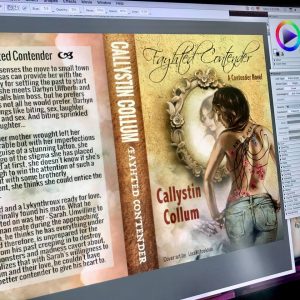 Formatting a book cover is surprisingly more complicated than people realize. Correct resolution is the single most important factor. You don’t want any detail to be lost in the print. Color balance is also essential. The printed version has to look exactly as the digital version does on the screen. Finally, sizing mistakes are unforgiving. Depending on the publisher’s format demands, you have to make sure that your full cover spread, plus the spine, will not be cropped even a millimeter off from the desired layout. In order to achieve this, one must know the exact thickness of the book’s spine, which is calculated by multiplying the number of double sided pages by the paper thickness. To do this you must know the paper your author has chosen for her publication and her manuscript length according to paper style and size. As Cally was making last minute edits and adjustments, the thickness of her book spine also kept changing, sometimes by a fraction of a millimeter, but every pixel counts when it comes to professional formatting. I think for Cally, this must have been the only frustrating part of the project, understandably so. Well, good things come to those who work hard, and in time we worked out all the nagging technical details and the Fayhted Contender was ready for publication.
Formatting a book cover is surprisingly more complicated than people realize. Correct resolution is the single most important factor. You don’t want any detail to be lost in the print. Color balance is also essential. The printed version has to look exactly as the digital version does on the screen. Finally, sizing mistakes are unforgiving. Depending on the publisher’s format demands, you have to make sure that your full cover spread, plus the spine, will not be cropped even a millimeter off from the desired layout. In order to achieve this, one must know the exact thickness of the book’s spine, which is calculated by multiplying the number of double sided pages by the paper thickness. To do this you must know the paper your author has chosen for her publication and her manuscript length according to paper style and size. As Cally was making last minute edits and adjustments, the thickness of her book spine also kept changing, sometimes by a fraction of a millimeter, but every pixel counts when it comes to professional formatting. I think for Cally, this must have been the only frustrating part of the project, understandably so. Well, good things come to those who work hard, and in time we worked out all the nagging technical details and the Fayhted Contender was ready for publication.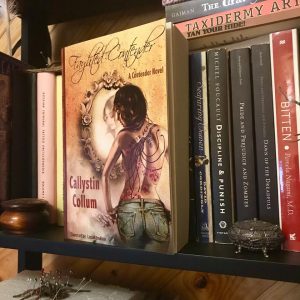 After three weeks of work and collaboration, Cally and I have become good friends and discovered that we share many similar views and opinions. I suppose it only makes sense, since we were able to work together so smoothly and quickly, understanding each other’s visions and motivations. This has been an incredibly rewarding artistic journey, but in the end nothing could have felt better than receiving my own copy of Fayhted Contender with a personal inscription from the author on the first page. Reading someone else’s novel with my art on the cover took some getting used to, but since this book is so easy to lose yourself in I soon had no trouble forgetting about the cover art and following Sarah on her journey.
After three weeks of work and collaboration, Cally and I have become good friends and discovered that we share many similar views and opinions. I suppose it only makes sense, since we were able to work together so smoothly and quickly, understanding each other’s visions and motivations. This has been an incredibly rewarding artistic journey, but in the end nothing could have felt better than receiving my own copy of Fayhted Contender with a personal inscription from the author on the first page. Reading someone else’s novel with my art on the cover took some getting used to, but since this book is so easy to lose yourself in I soon had no trouble forgetting about the cover art and following Sarah on her journey.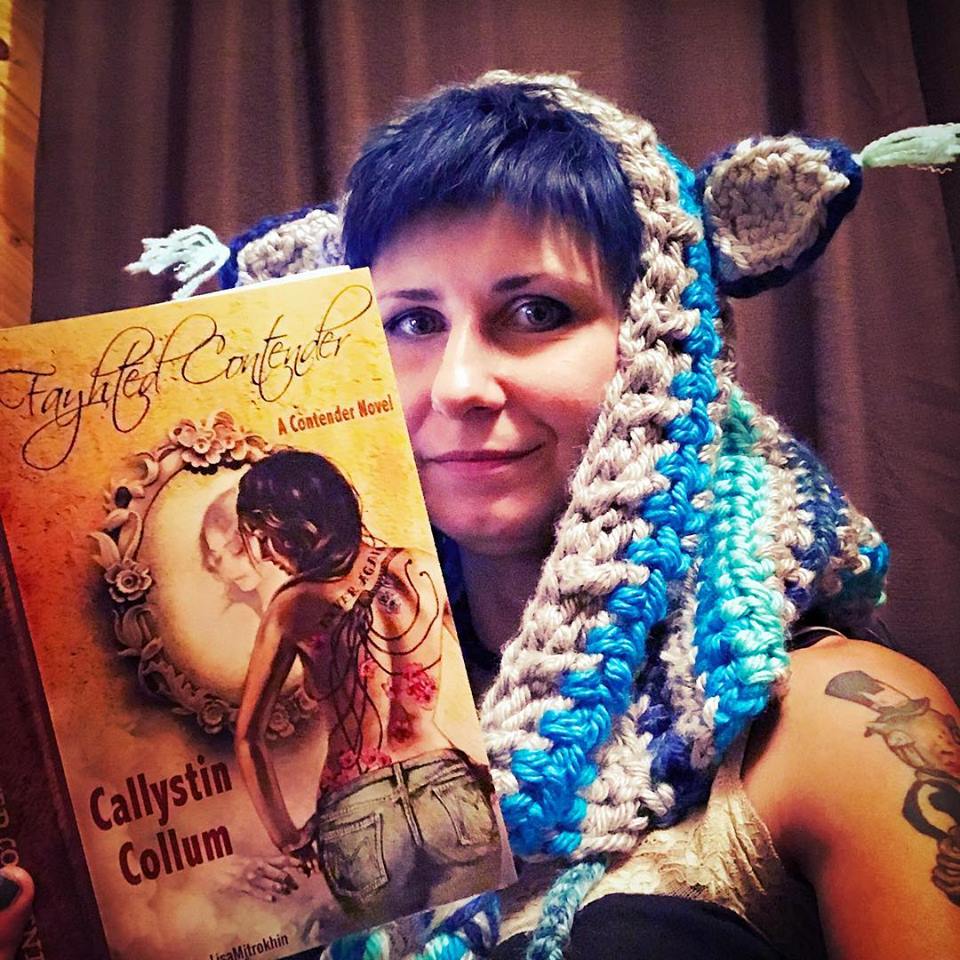
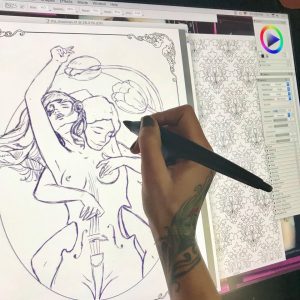 It all begins with an idea. Once I have a clear character concept in my head (which is teaming with ideas at any given moment) I open a new blank document and begin a rough sketch with my pencil tool set to a charcoal or a rough pencil, and usually in a color other than black. I tend to sketch in purple or brown. At this point I am only interested in working on the composition. I freehand my characters the way that I would on a notepad with an actual pencil. I erase a lot to correct my lines as I shape the desired composition. I continue sculpting in this manner for the next hour or so, depending on the complexity of my design. In this case, you will be following the creation of “The Musician” page for an upcoming book. Since this is a book project, instead of a blank page, I am working on a pre-made “frame” page that will be consistent throughout the book.
It all begins with an idea. Once I have a clear character concept in my head (which is teaming with ideas at any given moment) I open a new blank document and begin a rough sketch with my pencil tool set to a charcoal or a rough pencil, and usually in a color other than black. I tend to sketch in purple or brown. At this point I am only interested in working on the composition. I freehand my characters the way that I would on a notepad with an actual pencil. I erase a lot to correct my lines as I shape the desired composition. I continue sculpting in this manner for the next hour or so, depending on the complexity of my design. In this case, you will be following the creation of “The Musician” page for an upcoming book. Since this is a book project, instead of a blank page, I am working on a pre-made “frame” page that will be consistent throughout the book.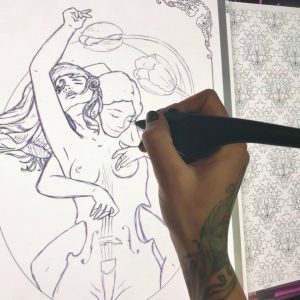 Once I have my composition I create a new layer. I dim the purple layer a bit, and begin drawing clean black lines over the transparent sketch. At this point I have my pencil tool set to “single, circular, (soft) cover” and, generally working on a 2400 x 3000 at a 300 px/in resolution, I set the pencil/brush in the range of 3.2 and 4.2 at a medium to lower opacity, with a rest value of 70%, bleed 40% and jitter at 0.04. The combination variations on these settings are of course unlimited, and every artist sets his own stats according to personal preference. This is by no means an instruction manual on how to set your controls. This is simply what I find to be the most effective given my screen with its wear and tear, the pressure of my hand as I draw, the current tip of my stylus, etc. These numbers are set and adjusted according to so many variables that it would take a book to explain it all. For our immediate purposes, let’s just say that I found my sweet spot and I work with it for best results and consistency, in coloring pages only. I have completely different preferences for other types of digital creations. As a matter of fact I have several palette layouts saved in my window arrangements, and I switch between them depending on my project.
Once I have my composition I create a new layer. I dim the purple layer a bit, and begin drawing clean black lines over the transparent sketch. At this point I have my pencil tool set to “single, circular, (soft) cover” and, generally working on a 2400 x 3000 at a 300 px/in resolution, I set the pencil/brush in the range of 3.2 and 4.2 at a medium to lower opacity, with a rest value of 70%, bleed 40% and jitter at 0.04. The combination variations on these settings are of course unlimited, and every artist sets his own stats according to personal preference. This is by no means an instruction manual on how to set your controls. This is simply what I find to be the most effective given my screen with its wear and tear, the pressure of my hand as I draw, the current tip of my stylus, etc. These numbers are set and adjusted according to so many variables that it would take a book to explain it all. For our immediate purposes, let’s just say that I found my sweet spot and I work with it for best results and consistency, in coloring pages only. I have completely different preferences for other types of digital creations. As a matter of fact I have several palette layouts saved in my window arrangements, and I switch between them depending on my project.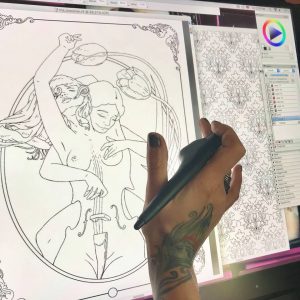 Once my clean black line work is done – a tedious and careful process – I can kill my purple layer. It is no longer needed. Of course I don’t have to erase it all together. I can dim it, or just make it invisible for the time being. Looking at just the black line work, I can see imperfections and inconsistencies. I now zoom in and out a lot, looking for anything that needs cleaner lines, smoother turns, etc. Because this is to be a coloring page, my lines need to be flawless.
Once my clean black line work is done – a tedious and careful process – I can kill my purple layer. It is no longer needed. Of course I don’t have to erase it all together. I can dim it, or just make it invisible for the time being. Looking at just the black line work, I can see imperfections and inconsistencies. I now zoom in and out a lot, looking for anything that needs cleaner lines, smoother turns, etc. Because this is to be a coloring page, my lines need to be flawless.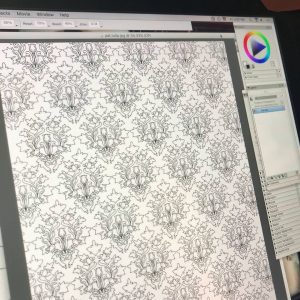 This particular book will be a character centered fantasy compilation, with each individual page presenting a new character drawn in a style closer to my natural drawing style rather than a traditional color-in mosaic page. However, to compensate for this fluidity that may be intimidating to some colorists, each page will also be embellished with elaborate background designs and patterns. Knowing that I will be drawing this character, I already created her background pattern days ago. All of my patterns are my original creations, drawn in the same manner as I am drawing this page, and saved as .jpg files for further use. Now that I have my background pattern, I can copy and paste it onto “The Musician”, resized, styled, and otherwise altered to suit my needs.
This particular book will be a character centered fantasy compilation, with each individual page presenting a new character drawn in a style closer to my natural drawing style rather than a traditional color-in mosaic page. However, to compensate for this fluidity that may be intimidating to some colorists, each page will also be embellished with elaborate background designs and patterns. Knowing that I will be drawing this character, I already created her background pattern days ago. All of my patterns are my original creations, drawn in the same manner as I am drawing this page, and saved as .jpg files for further use. Now that I have my background pattern, I can copy and paste it onto “The Musician”, resized, styled, and otherwise altered to suit my needs.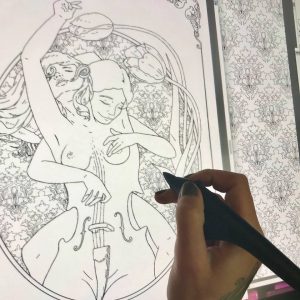 In this case, I minimize my pattern and make it into a gel layer, which I place under the main line layer. Now I can play with cropping and shaping it to appear just in the oval behind my characters. There are multiple ways of doing this. The first being simply starting my design with a patterned oval, then dimming it to comfortably draw my characters in a different layer, and once drawn filling my characters with white inside the outlines, and then bringing up the background pattern. There are many other methods of creating this effect using the fill tool and multiple layer arrangements, and even multiple file combinations, but I chose to do this in a bit of a primitive way this time. When I began this page I had a clear vision of my characters and their positioning in relation to each other and the page, but I did not yet know where and how I may use the pattern that I created days ago, or if I would even use that pattern at all. Having left my pattern work to the last minute, and having under-layed it in a gel layer, I just work around with my eraser tool, taking off all unwanted spill. A bit tedious, I know. With all this technology you would imagine that I can just click this and drag that and voila! a pattern fill, but no. Now I sit for nearly half an hour carving my pattern out to fit its shape. Sometimes that just feels like the better way to do it. This way I know I have complete control of my edges and their cleanliness.
In this case, I minimize my pattern and make it into a gel layer, which I place under the main line layer. Now I can play with cropping and shaping it to appear just in the oval behind my characters. There are multiple ways of doing this. The first being simply starting my design with a patterned oval, then dimming it to comfortably draw my characters in a different layer, and once drawn filling my characters with white inside the outlines, and then bringing up the background pattern. There are many other methods of creating this effect using the fill tool and multiple layer arrangements, and even multiple file combinations, but I chose to do this in a bit of a primitive way this time. When I began this page I had a clear vision of my characters and their positioning in relation to each other and the page, but I did not yet know where and how I may use the pattern that I created days ago, or if I would even use that pattern at all. Having left my pattern work to the last minute, and having under-layed it in a gel layer, I just work around with my eraser tool, taking off all unwanted spill. A bit tedious, I know. With all this technology you would imagine that I can just click this and drag that and voila! a pattern fill, but no. Now I sit for nearly half an hour carving my pattern out to fit its shape. Sometimes that just feels like the better way to do it. This way I know I have complete control of my edges and their cleanliness.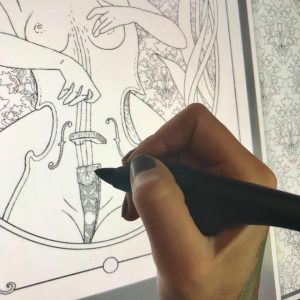 Now I look over my creation and take some time to add tiny detail and decoration. On this particular page, my characters are not wearing any fabrics nor ornaments, so my only decorative bits are the cello details. In some cases I like to draw very fine lines in the hair, giving it shape and volume that is almost realistic, but in this case the background is too thin and busy. If I add many new lines to the characters’ hair, It will be difficult to see its general shape. I chose to leave the hair on both girls nearly blank, with just enough lines to define its structure, allowing the colorist variation in coloring style. There will be many more characters in this book with very finely drawn hair.
Now I look over my creation and take some time to add tiny detail and decoration. On this particular page, my characters are not wearing any fabrics nor ornaments, so my only decorative bits are the cello details. In some cases I like to draw very fine lines in the hair, giving it shape and volume that is almost realistic, but in this case the background is too thin and busy. If I add many new lines to the characters’ hair, It will be difficult to see its general shape. I chose to leave the hair on both girls nearly blank, with just enough lines to define its structure, allowing the colorist variation in coloring style. There will be many more characters in this book with very finely drawn hair.